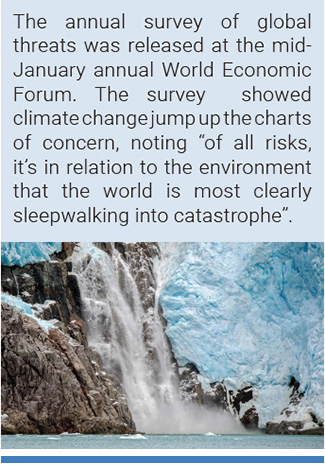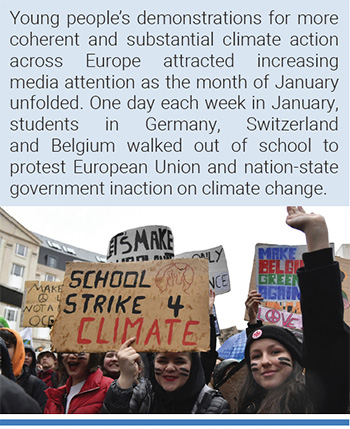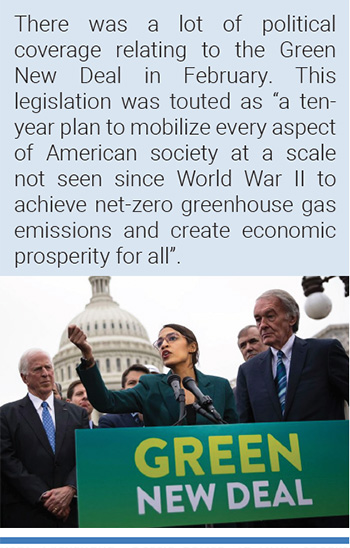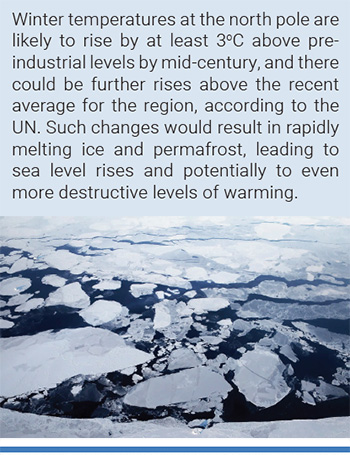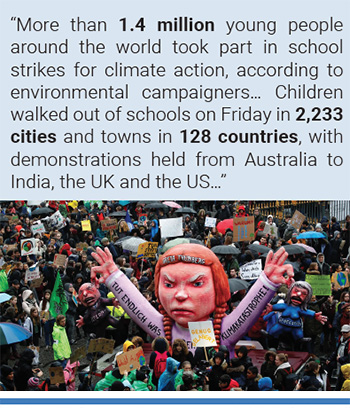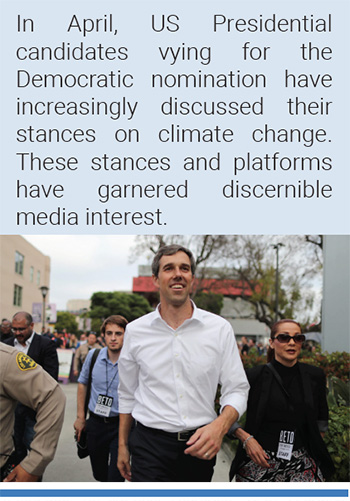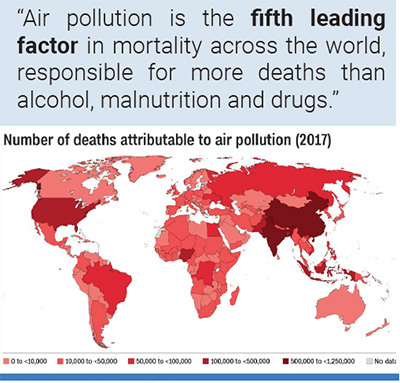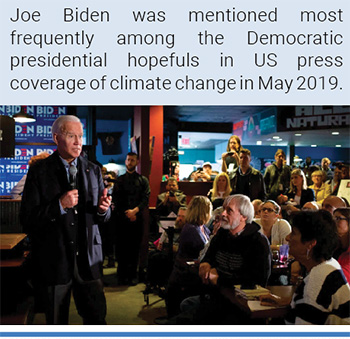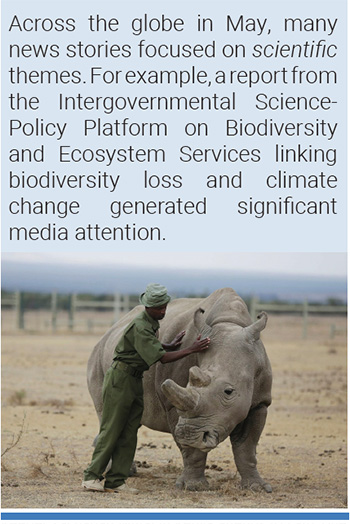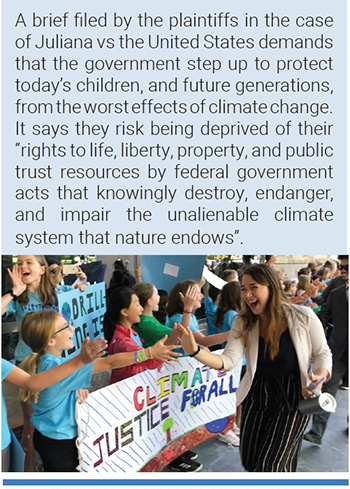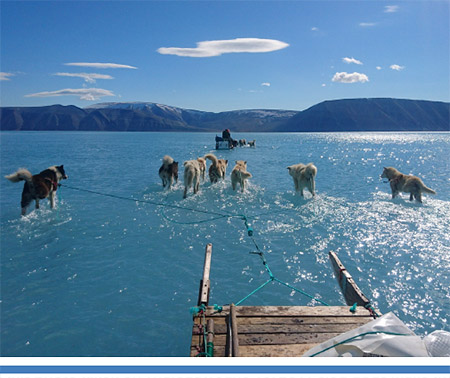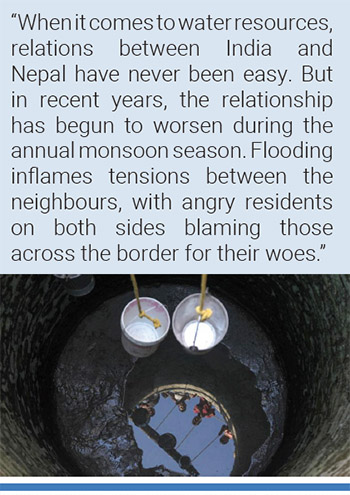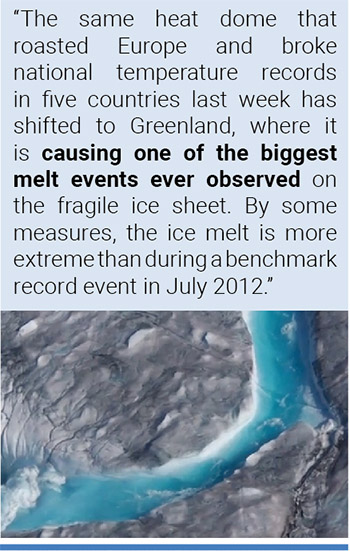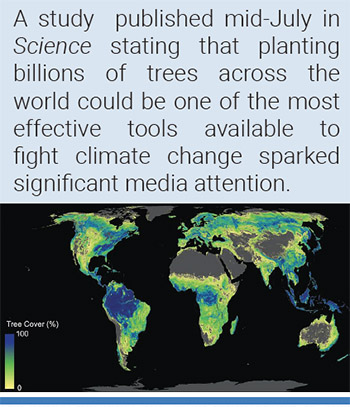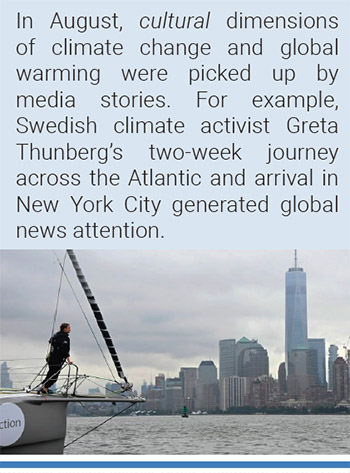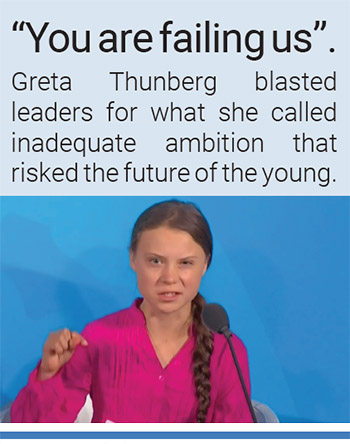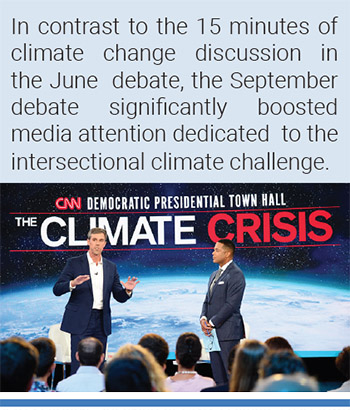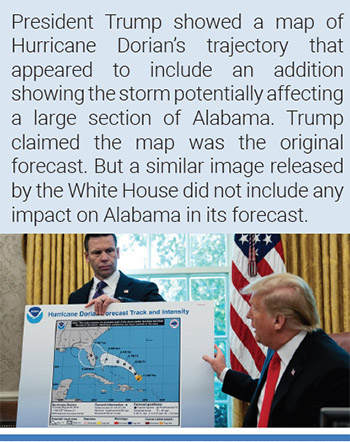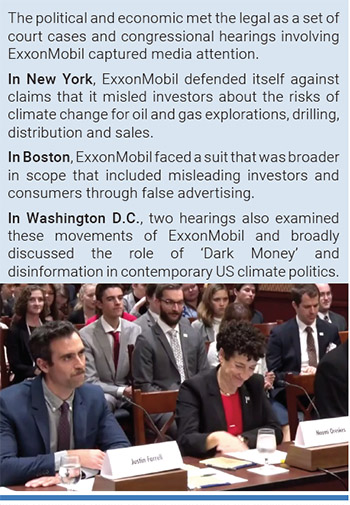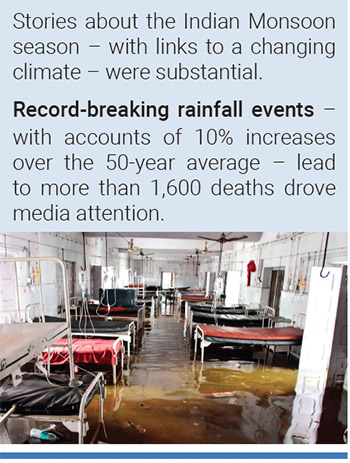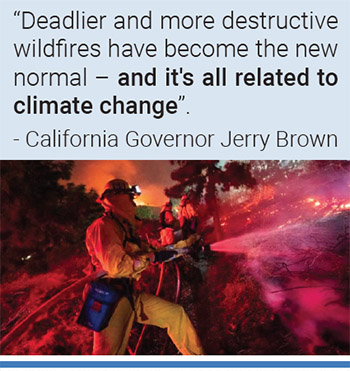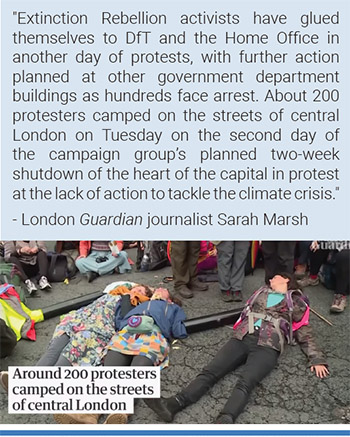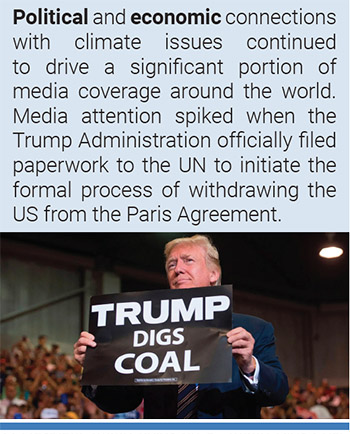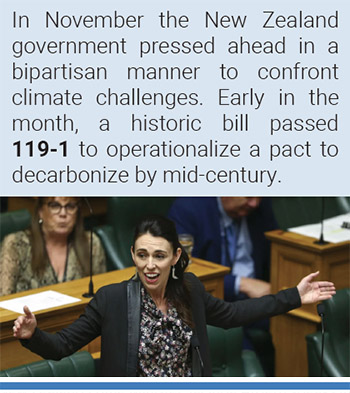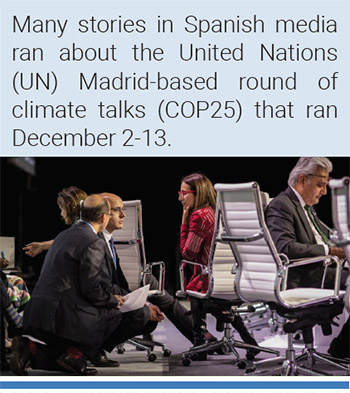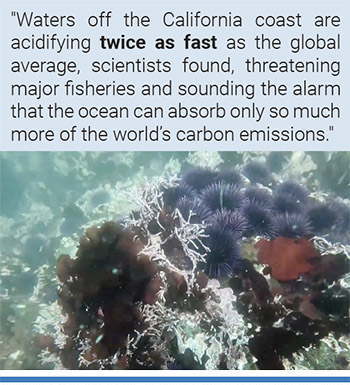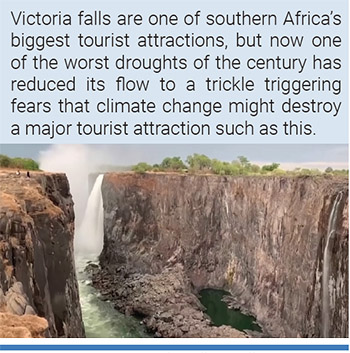Monthly Summaries
2019 Year End Retrospective
Special Issue 2019
A Review of Media Coverage of Climate Change and Global Warming in 2019
[DOI]

 has been an important year in which climate change and global warming fought for media attention amid competing interests in other stories, events and issues around the globe. In a finite ‘news hole’, climate change and global warming garnered coverage through stories manifesting through primary, yet often intersecting, political, economic, scientific, cultural as well as ecological and meteorological themes.
has been an important year in which climate change and global warming fought for media attention amid competing interests in other stories, events and issues around the globe. In a finite ‘news hole’, climate change and global warming garnered coverage through stories manifesting through primary, yet often intersecting, political, economic, scientific, cultural as well as ecological and meteorological themes.
Sub-Saharan African drought, Central American migration pressures, South American deforestation, Asian public health concerns, European decarbonization, United Nations (UN) climate talks, Australian bushfires, Canadian Federal Elections, United States (US) withdrawal from the Paris Climate Agreement and global youth-led climate social movements punctuated the 2019 media and climate change landscape. Climate impacts – from the Amazon to the Zambezi River – grabbed media attention in 2019. Personalities like Donald, Jacinda, Jair, Greta, and Narendra contributed ‘discernible human influences’ on media coverage of climate change across the year. And in 2019, other names made climate-related news: Barry, Dorian, Hagabis, Idai, Kammuri and Lorenzo.
 As the year ended, retrospectives like Miles O’Brien’s take at PBS NewsHour helped to put the “Earth’s fragility and humans’ indifference to it” into context, describing how we ‘Earthlings’ found ourselves at an ‘inflection point’ after this pivotal year. As journalists and editors took stock of the year gone by, numerous influential news organizations called out US Trump Administration actions as incommensurate with the scale of the intersectional climate challenges. For example, in ‘President Trump’s very bad year on climate change hurts us all’ at the end of December, Los Angeles Times Editors wrote, “If Trump thinks the Paris agreement posed an 'unfair economic burden' on the U.S., as the administration described it, he ought to contemplate the costs of dealing with a warmer and more unstable climate”. Meanwhile, New York Times journalists Nadja Popovich, Livia Albeck-Ripka and Kendra Pierre-Louis placed seven explicit climate policy actions in the context of a larger basket of ’95 Environmental Rules Being Rolled Back Under Trump’. Outside the US context, Guardian journalist Fiona Harvey pointed out that, “Climate breakdown played a key role in at least 15 events in 2019 that cost more than $1bn (£760m) in damage, with more than half of those costing more than $10bn each. Extreme weather including floods, storms, droughts and wildfires struck every inhabited continent in the past year, causing devastation and loss of life”.
As the year ended, retrospectives like Miles O’Brien’s take at PBS NewsHour helped to put the “Earth’s fragility and humans’ indifference to it” into context, describing how we ‘Earthlings’ found ourselves at an ‘inflection point’ after this pivotal year. As journalists and editors took stock of the year gone by, numerous influential news organizations called out US Trump Administration actions as incommensurate with the scale of the intersectional climate challenges. For example, in ‘President Trump’s very bad year on climate change hurts us all’ at the end of December, Los Angeles Times Editors wrote, “If Trump thinks the Paris agreement posed an 'unfair economic burden' on the U.S., as the administration described it, he ought to contemplate the costs of dealing with a warmer and more unstable climate”. Meanwhile, New York Times journalists Nadja Popovich, Livia Albeck-Ripka and Kendra Pierre-Louis placed seven explicit climate policy actions in the context of a larger basket of ’95 Environmental Rules Being Rolled Back Under Trump’. Outside the US context, Guardian journalist Fiona Harvey pointed out that, “Climate breakdown played a key role in at least 15 events in 2019 that cost more than $1bn (£760m) in damage, with more than half of those costing more than $10bn each. Extreme weather including floods, storms, droughts and wildfires struck every inhabited continent in the past year, causing devastation and loss of life”.
As this end of the year also marked the end of a decade, numerous outlets also examined climate change over the past ten years. For instance, journalist John D. Sutter at CNN commented, “On the cusp of 2020, the state of the planet is far more dire than in 2010. Preserving a safe and healthy ecological system is no longer a realistic possibility. Now, we're looking at less bad options, ceding the fact that the virtual end of coral reefs, the drowning of some island nations, the worsening of already-devastating storms and the displacement of millions -- they seem close to inevitable. The climate crisis is already costly, deadly and deeply unjust, putting the most vulnerable people in the world, often who've done the least to cause this, at terrible risk. The worst part? We've known about this for a very long time”.
At the global level, September was the high water mark for coverage of climate change or global warming among the sources tracked by our Media and Climate Change Observatory (MeCCO) team. New Zealand print media coverage reached an all-time high, while the amount of coverage in Germany and Spain were second highest, and the United Kingdom reached the fourth highest on record in the month of September. Also in September 2019, Indian print media coverage reached an all-time high.
Coverage was most abundant in history apart from attention in November and December 2009 associated with the Copenhagen round of climate talks (COP15) and the University of East Anglia email hacking scandal ‘climate-gate’. MeCCO documented particularly strong signals in the quantity of coverage in the US in September in both television and print media. US television media reached its second highest levels (after the aforementioned period of November and December 2009. US print media of climate change or global warming reached an all-time high since MeCCO monitoring began in January 2000. US print media coverage of climate change surpassed the previous high water mark achieved in January 2017 (largely dominated by speculation of how newly inaugurated US President Donald Trump would impact global efforts to combat climate change). Contributing to these increases, a ‘Covering Climate Now’ campaign – led by US-based media organizations the Nation and Columbia Journalism Review – was deployed in September to increase media coverage of climate change across more than 300 participating outlets. With a combined potential audience of over 1 billion readers, viewers and listeners, this initiative contributed to the increases in coverage that we in MeCCO detected.
In 2019, we at MeCCO introduced expanded media monitoring of climate change or global warming around the world.
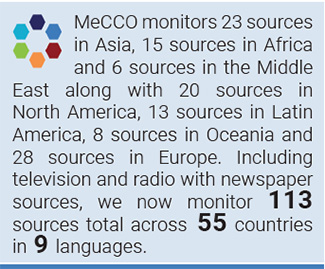 in January, we began tracking Public Broadcasting Services on United States television and additional monitoring across four wire services: Associated Press, Agence France Press (AFP), The Canadian Press, and United Press International (UPI)
in January, we began tracking Public Broadcasting Services on United States television and additional monitoring across four wire services: Associated Press, Agence France Press (AFP), The Canadian Press, and United Press International (UPI)- in April, we then added eight new European sources to our counts: Correio da Manhã (Portugal), La Republica (Italy), Corriere della Sera (Italy), Le Monde (France), Le Figaro (France), El Mundo (Spain), La Vanguardia (Spain) and Expansion (Spain)
- also in April, we added a ‘European Newspaper Coverage of Climate Change or Global Warming’ figure like we had done with our work to track ‘Latin American Newspaper Coverage of Climate Change or Global Warming’ in the past
- in May, we began monitoring six sources total from Sweden (Dagens Nyheter, Aftonbladet, and Expressen) and Norway (Aftenposten, VG, and Dagbladet) to our European monitoring
- in October, we integrated 17 new sources across 14 countries: five new sources in Asia, 11 new sources in Africa and 1 new source in the Middle East: The Malaysian Reserve (Malaysia), Today (Singapore), The Daily Mirror (Sri Lanka), The Daily News (Sri Lanka) and The New Nation (Bangladesh) in Asia; Daily Trust (Nigeria), Vanguard (Nigeria), The New Times (Rwanda), Daily Nation (Kenya), The Times of Zambia (Zambia), New Era Namibia (Namibia), The Citizen (Tanzania), Pa Potentiel (Congo), L’Observateur Paalga (Burkina Faso), La Nouvelle Tribune (Morocco) and Sud Quotidien (Senegal) in Africa; and Dawn (Pakistan) in the Middle East
This work increased our explanatory power regarding print media coverage of climate change in these regions now with 23 sources in Asia, 15 sources in Africa and 6 sources in the Middle East along with 20 sources in North America, 13 sources in Latin America, 8 sources in Oceania and 28 sources in Europe. In addition, we at MeCCO now monitor print media representations of climate change at the country-level in eleven nations. Including television and radio with newspaper sources, we now monitor 113 sources total across 55 countries in nine languages (see fact sheet):
- English: ‘climate change’ or ‘global warming’
- French: ‘changement climatique’ or ‘réchauffement climatique’
- German: ‘klimawandel’ or ‘globale erwärmung’
- Italian: ‘cambiamenti climatici’ or ‘riscaldamento globale’
- Japanese: ‘温暖化’ or ‘気候変動’
- Norwegian: ‘global oppvarming’ or ‘klimaendring’
- Portuguese: ‘mudanças climáticas’ or ‘aquecimento global’
- Spanish: ‘cambio climático’ or ‘calentamiento global’
- Swedish: ‘global uppvärmning’ or ‘klimatförändring’
Across the one-hundred newspaper sources, coverage was up 73% in 2019 compared to 2018. Across global radio, coverage was up 74% in 2019 compared to 2018. At the country level, coverage increased everywhere. This was most pronounced in Germany and the UK where coverage more than doubled. Yet coverage increased substantially in New Zealand (up 95%), Canada (up 90%) Spain (up 88%) and Australia (up 83%) in 2019. Elsewhere, coverage in 2019 compared to the previous year in India was up 61% while coverage was up 59% in Norway, 48% in Sweden and 45% in Japan. US television coverage increased dramatically in 2019, up 138%, but the increase in print coverage in 2019 was more modest by comparison, up 46% from 2018.

Figure 1. Media coverage of climate change or global warming in one-hundred print sources in seven different regions around the world, from January through December 2019.
At the US country level, Figure 2 illustrates these trends month to month in US press accounts across five newspaper publications in 2019 – The Washington Post, The Wall Street Journal, The New York Times, USA Today, and The Los Angeles Times.

Figure 2. Media coverage of climate change or global warming month to month in the Los Angeles Times, The New York Times, USA Today, The Washington Post, and The Wall Street Journal in the US from January through December 2019.
Figure 3 shows trends month to month in 2019 across US television news – ABC, CBS, CNN, Fox News Network, MSNBC, and NBC.

Figure 3. Media coverage of climate change or global warming month to month on ABC, CBS, CNN, Fox News Network, MSNBC, and NBC in the US from January through December 2019.
In the US, there was a continued prominence (detected in 2017 and 2018 as well) of news from US outlets on climate change or global warming associated with Donald J. Trump. We at MeCCO have referred to this as a ‘Trump Dump’, where media attention that would have focused on other climate-related events and issues instead was placed on Trump-related actions, leaving many other stories untold. It bears repeating that Lisa Hymas described this aptly in this way: “The media should be chasing down stories on climate science, the people being affected by climate change, responses and solutions to the problem. Instead, even when they report on climate change, they’re still chasing Trump”. This pattern was discussed particularly in February, March and May 2019 below. This resurfaced as well in November 2019 when the Trump administration formally notified the UN that the US was withdrawing from the Paris climate agreement (see below for more). In 2019, these ongoing trends led to a ‘distracting Donald’ label as many appeared to grow weary of interference and subversion of ongoing efforts by the Trump Administration to confront a changing climate as the 2020s approached.
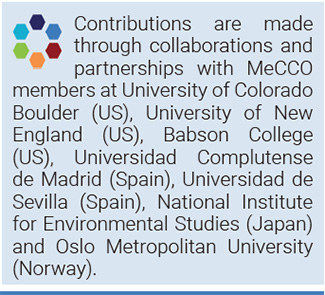 This report is a reprise of monthly summaries that our MeCCO team has compiled and posted each month on our website. It is our third annual review of coverage. The project is currently based in the Center for Science and Technology Policy Research (CSTPR) in the Cooperative Institute for Research in Environmental Sciences (CIRES) at the University of Colorado Boulder. However, contributions are made through collaborations and partnerships with MeCCO members at the University of New England (US), Babson College (US), Universidad Complutense de Madrid (Spain), Universidad de Sevilla (Spain) and the National Institute for Environmental Studies (Japan) and Oslo Metropolitan University (Norway). MeCCO members are Midori Aoyagi, Andrew Benham, Max Boykoff, Patrick Chandler, Meaghan Daly, Kaori Doi, Rogelio Fernández-Reyes, Lauren Gifford, Isidro Jiménez Gómez, Jennifer Katzung, Lucy McAllister, Marisa McNatt, Ami Nacu-Schmidt, David Oonk, Jeremiah Osborne-Gowey, Olivia Pearman, Anne Hege Simonsen, and Andreas Ytterstad.
This report is a reprise of monthly summaries that our MeCCO team has compiled and posted each month on our website. It is our third annual review of coverage. The project is currently based in the Center for Science and Technology Policy Research (CSTPR) in the Cooperative Institute for Research in Environmental Sciences (CIRES) at the University of Colorado Boulder. However, contributions are made through collaborations and partnerships with MeCCO members at the University of New England (US), Babson College (US), Universidad Complutense de Madrid (Spain), Universidad de Sevilla (Spain) and the National Institute for Environmental Studies (Japan) and Oslo Metropolitan University (Norway). MeCCO members are Midori Aoyagi, Andrew Benham, Max Boykoff, Patrick Chandler, Meaghan Daly, Kaori Doi, Rogelio Fernández-Reyes, Lauren Gifford, Isidro Jiménez Gómez, Jennifer Katzung, Lucy McAllister, Marisa McNatt, Ami Nacu-Schmidt, David Oonk, Jeremiah Osborne-Gowey, Olivia Pearman, Anne Hege Simonsen, and Andreas Ytterstad.
As the next decade unfolds, let us take some time to reflect on how the past year of media coverage of climate change may shape what is to come. 2020 is also a critical time to ponder how our histories up to the present shape those that will follow in ‘the fierce urgency of now’. What follows are ‘highlights’ of key events, stories and developments through political, scientific, cultural, ecological and meteorological themes that have transpired during our collectively experienced year 2019.
January
January media attention to climate change and global warming was down 20% throughout the world from the previous month of December 2018, but up just over 15% from January 2018. While African coverage was up 21% from the previous month, it was down in all other regions, including North America where coverage was down 10% in January compared to the previous month of December 2018.
Figure 4. Word cloud showing frequency of words (4 letters or more) invoked in media coverage of climate change or global warming in Indian newspaper sources. Data are from The Indian Express, The Hindu, Hindustan Times, and The Times of India. |
In January, considerable attention was paid to political and economic content of coverage. Prominently, the movements of newly elected Brazilian President Jair Bolsonaro captured media attention. From his inauguration in January, coverage focused on his efforts to commodify ecosystem services in the country. For example, Bolsonaro immediately sought to cede control of indigenous lands to agribusiness. Journalist Marina Lopes from The Washington Post reported, “Brazil’s new right-wing president opened the door Wednesday for more potential development and tree-clearing in the Amazon rain forest, giving the Agriculture Ministry oversight over which lands are granted protected status. The move by Jair Bolsonaro — in one of his first acts since his inauguration Tuesday — is seen as a victory for Brazil’s powerful rural lobby, which has long sought access to protected lands for logging, farming and other projects. It also signaled the apparent start of a new era of sweeping deregulation in Brazil, a country once lauded for its strides in environmental protection — including its stewardship of the world’s largest rain forest. Bolsonaro, a former army captain who was backed by the rural lobby, supports greater development of the Amazon, the assimilation of indigenous groups and reduction of environmental regulation”.
In Europe, some coverage focused on continuing trends toward decarbonization and electric transportation. For example, media focused on Germany’s announced plans in January to phase out all of its coal-fired power plants over the next two decades. In addition to abundant media attention in the German press, journalist Erik Kirschbaum from The Los Angeles Times reported, “the announcement marked a significant shift for Europe’s largest country — a nation that had long been a leader on cutting CO2 emissions before turning into a laggard in recent years and badly missing its reduction targets. Coal plants account for 40% of Germany’s electricity, itself a reduction from recent years when coal dominated power production”. As another example, coverage noted record-setting electric vehicle sales in 2018. Journalists Camilla Knudson and Alister Doyle commented, “Almost a third of new cars sold in Norway last year were pure electric, a new world record as the country strives to end sales of fossil-fueled vehicles by 2025…The independent Norwegian Road Federation (NRF) said on Wednesday that electric cars rose to 31.2 percent of all sales last year, from 20.8 percent in 2017 and just 5.5 percent in 2013, while sales of petrol and diesel cars plunged”.
Meanwhile, the annual survey of global threats was released at the mid-January annual World Economic Forum. The survey showed climate change jump up the charts of concern, noting "Of all risks, it's in relation to the environment that the world is most clearly sleepwalking into catastrophe". Journalist Joanna Sugdan from The Wall Street Journal reported, “The threat of a full-blown global trade war and rising political tensions between world powers are the dominant global risks, according to a report by the World Economic Forum ahead of its annual gathering in Davos, Switzerland, next week. Cyberattacks and climate change also feature high on the list of potential hazards drawn up from a survey of around 1,000 lawmakers, academics and business leaders for the group that organizes the Davos meeting”. Meanwhile, Guardian economics editor Larry Elliot wrote, “Growing tension between the world’s major powers is the most urgent global risk and makes it harder to mobilise collective action to tackle climate change, according to a report prepared for next week’s World Economic Forum in Davos, Switzerland. The WEF’s annual global risks report found that a year of extreme weather-related events meant environmental issues topped the list of concerns in a survey of around 1,000 experts and decision-makers”.
World Economic Forum chief Børge Brende wants ‘coordinated, concerted action’ among world’s powers to halt climate change Photo: Martin Bernetti/AFP/Getty Images. |
Also in January, media covered ecological and meteorological dimensions of climate issues. For example, increases in jellyfish stings in Australia were attributed to changes in the climate. Washington Post journalist Rick Noack reported, “Authorities in Queensland, Australia, were forced to close beaches across the region over the weekend amid what local officials said was a jellyfish “epidemic.” Thousands of stings were recorded in Queensland last week, according to rescue organizations. While the vast majority of those stings were not life-threatening and were caused by “bluebottle colonies,” researchers say the number of more serious injuries from less common jellyfish is also at above-average levels. Some researchers also say this jellyfish infestation could be one more thing to blame on climate change”.
However, most dominant in January media coverage of climate change was a polar vortex that gripped much of the upper Midwest of the United States. Part of the media story also became US President Trump’s response. For example, Associated Press reporter Seth Borenstein wrote, “In the midst of a Midwest cold spell, President Donald Trump is pleading for global warming to come back, but it never went away. Just like the Arctic air invading parts of the U.S. because of wandering pieces of the polar vortex, Earth’s warmth appears a bit temporarily displaced. But scientific reports issued by the Trump administration and outside climate scientists contradict Trump’s suggestion that global warming can’t exist if it’s cold outside”. Meanwhile, CNN journalists Don Lemon and Chris Cuomo joked about the President’s confusion between weather and climate change..
Regarding media accounts focused on primarily scientific dimensions of climate change and global warming, the US government shutdown’s impact on ongoing scientific research on climate change garnered media attention. In a representative Washington Post article entitled ‘As shutdown continues, so does damage to U.S. science’, journalists Ben Guarino, Carolyn Y. Johnson, Sarah Kaplan and Lenny Bernstein reported, “Of the 800,000 federal employees furloughed or working without pay, thousands are researchers. These include agency scientists at the Agriculture Department, the National Institute of Standards and Technology, the National Oceanic and Atmospheric Administration (NOAA), the National Science Foundation and the U.S. Geological Survey. (The Centers for Disease Control and Prevention and the National Institutes of Health, which were separately funded through September, are almost entirely safe from this shutdown.) Furloughed government scientists are banned from any form of work activity — they cannot so much as open an email. “The current government shutdown has far-reaching effects that put America’s scientific progress at risk. While there are reports that agencies such as NOAA and the USGS are still issuing alerts about weather and natural hazards, much of the scientific research into how to prevent these kinds of disasters has stalled,” said Christine McEntee, executive director of the American Geophysical Union. “This shutdown could affect the EPA’s ability to meet deadlines for assessing chemicals, and NOAA isn’t able to track fish for commercial harvesting or endangered species to protect them from passing ships.” She added, “Until funding is secured, many scientists employed by the U.S. government aren’t able to make important observations or analyze data to protect life, property and ecosystems here at home and abroad".
In other news, key scientific findings from new studies relating to climate change garnered attention. For example, that the world’s oceans have been warming more quickly than predicted generated considerable media coverage. The study in Science magazine by Lijing Cheng, John Abraham, Zeke Hausfather, and Kevin Trenberth entitled ‘How Fast are the Oceans Warming?’. USA Today journalist Doyle Rice noted, “Global warming isn't only cooking our atmosphere, it’s also heating up the oceans. The world's seas were the warmest on record in 2018, scientists announced Thursday. Also, ocean temperatures are rising faster than previously thought, a new paper said. Specifically, they're warming as much as 40 percent faster than an estimate from a United Nations panel just five years ago”. Meanwhile, CNN reporter Jen Christensen wrote, “For the new study, scientists used data collected by a high-tech ocean observing system called Argo, an international network of more than 3,000 robotic floats that continuously measure the temperature and salinity of the water. Researchers used this data in combination with other historic temperature information and studies. The study authors say the warming is happening because of climate change created by such human activities as the burning of fossil fuels”.
Students and others hold up placards with climate messages during a demonstration against climate change in Brussels, January 17, 2019. Students as part of the Youth for Climate movement took time off school Thursday to call for stronger action against climate change. Photo: AP/Wijngaert. |
Furthermore, scientific findings from the Proceedings of the National Academy of Sciences that Antarctica is losing ice more than six times faster today than it did in the 1970s also garnered media attention. To illustrate, Associated Press journalist Seth Borenstein reported, “Scientists used aerial photographs, satellite measurements and computer models to track how fast the southern-most continent has been melting since 1979 in 176 individual basins. They found the ice loss to be accelerating dramatically — a key indicator of human-caused climate change. Since 2009, Antarctica has lost almost 278 billion tons (252 billion metric tons) of ice per year, the new study found. In the 1980s, it was losing 44 billion tons (40 billion metric tons) a year. The recent melting rate is 15 percent higher than what a study found last year”. Washington Post journalists Chris Mooney and Brady Dennis wrote, “Antarctic glaciers have been melting at an accelerating pace over the past four decades thanks to an influx of warm ocean water — a startling new finding that researchers say could mean sea levels are poised to rise more quickly than predicted in coming decades”.
Across the globe in January, there was a range of stories that intersected with the cultural arena. For example, the news that renewable energy became Germany’s main energy source in 2018 (overtaking coal) attracted attention. For example, journalist Vera Eckert from Reuters reported, “Renewables overtook coal as Germany’s main source of energy for the first time last year, accounting for just over 40 percent of electricity production… The shift marks progress as Europe’s biggest economy aims for renewables to provide 65 percent of its energy by 2030 in a costly transition as it abandons nuclear power by 2022 and is devising plans for an orderly long-term exit from coal. The research from the Fraunhofer organization of applied science showed that output of solar, wind, biomass and hydroelectric generation units rose 4.3 percent last year to produce 219 terawatt hours (TWh) of electricity. That was out of a total national power production of 542 TWh derived from both green and fossil fuels, of which coal burning accounted for 38 percent. Green energy’s share of Germany’s power production has risen from 38.2 percent in 2017 and just 19.1 percent in 2010”.
In addition, young people’s demonstrations for more coherent and substantial climate action across Europe attracted increasing media attention as the month of January unfolded. One day each week in January, students in Germany, Switzerland and Belgium walked out of school to protest European Union and nation-state government inaction on climate change. Early in the month, the Associated Press reported, “More than 10,000 students skipped school again in Belgium to join a march demanding better protections of the globe’s fragile climate. Despite the rain and cold, the colorful protest march in Brussels was bigger than the initial one last week. Banners reading “School strike 4 Climate” and “Skipping school? No. We fight for our future,” highlighted the march, which was free of incidents”. The BBC also captured comments from some of the more than 12,000 students who took part in the protests in Brussels. Later in the month – as estimated sizes of the student groups has continued to grow – Washington Post journalist Rick Noack reported, “Now in their third week, the Belgian protests against inaction on climate change drew more than 30,000 high school and university students to Brussels, roughly triple the number of protesters last week”.
February
February media attention to climate change and global warming was up 9% throughout the world from the previous month of January, and up 63% from February 2018. While Asia, Middle East and Central/South America coverage was down 8%, 12% and 15% respectively from the previous month, it was up in all other regions. For examples, coverage in Europe was up 8%, Oceania coverage increased 34% and North America media attention went up 8% in February compared to the previous month.

Figure 5. Word clouds showing frequency of words (4 letters or more) invoked in media coverage of climate change or global warming in United States newspaper sources in January (left) and February (right). Data are from The Los Angeles Times, The New York Times, USA Today, The Wall Street Journal and The Washington Post.
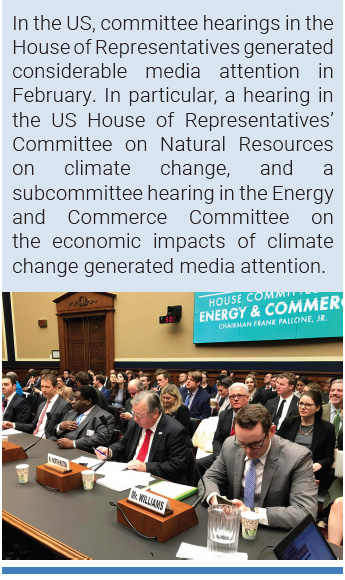 In February, there were many media stories about climate change that touched on political and economic content. In the US, committee hearings in the House of Representatives generated considerable media attention in early February. In particular, a hearing in the US House of Representatives’ Committee on Natural Resources on climate change, and a subcommittee hearing in the Energy and Commerce Committee on the economic impacts of climate change generated media attention. For example, MSNBC ran with the headline ‘The House – finally – cares about climate change again’ while journalist Jen Christensen from CNN noted, “President Donald Trump did not mention climate change or any efforts to help the environment during his State of the Union address Tuesday, but members of the US House of Representatives held two hearings Wednesday on Capitol Hill to take a closer look at the threat of climate change”. Stephanie Ebbs from ABC News reported on dueling personalities in the hearings when she noted, “ranking Member Rob Bishop, R-Utah, raised concerns the hearing was too broad and not focused enough on the committee's jurisdiction, which is federal conservation programs. Bishop said he wants to the committee to spend more time talking about how forests can be managed to promote clean air and protect states from smoke pollution as a result of wildfires in states like California…"I have to mention I'm kind of a loss, I don't know where this hearing is going or the other six you have planned because you haven't told us what the goal is. At some point we may be asking, where are we going? What is the real legislation to help people that is supposed to come out of these hearings? To understand whether these hearings are for those of us around the horseshoe that are going to make legislation or this group that's sitting at a table in the corner so they can write cute stories," Bishop said, point toward reporters in the hearing room”.
In February, there were many media stories about climate change that touched on political and economic content. In the US, committee hearings in the House of Representatives generated considerable media attention in early February. In particular, a hearing in the US House of Representatives’ Committee on Natural Resources on climate change, and a subcommittee hearing in the Energy and Commerce Committee on the economic impacts of climate change generated media attention. For example, MSNBC ran with the headline ‘The House – finally – cares about climate change again’ while journalist Jen Christensen from CNN noted, “President Donald Trump did not mention climate change or any efforts to help the environment during his State of the Union address Tuesday, but members of the US House of Representatives held two hearings Wednesday on Capitol Hill to take a closer look at the threat of climate change”. Stephanie Ebbs from ABC News reported on dueling personalities in the hearings when she noted, “ranking Member Rob Bishop, R-Utah, raised concerns the hearing was too broad and not focused enough on the committee's jurisdiction, which is federal conservation programs. Bishop said he wants to the committee to spend more time talking about how forests can be managed to promote clean air and protect states from smoke pollution as a result of wildfires in states like California…"I have to mention I'm kind of a loss, I don't know where this hearing is going or the other six you have planned because you haven't told us what the goal is. At some point we may be asking, where are we going? What is the real legislation to help people that is supposed to come out of these hearings? To understand whether these hearings are for those of us around the horseshoe that are going to make legislation or this group that's sitting at a table in the corner so they can write cute stories," Bishop said, point toward reporters in the hearing room”.
There was a lot of political coverage relating to the Green New Deal – co-sponsored by Rep. Alexandria Ocasio-Cortez (D-NY) and Sen. Edward Markey (D-MA) – in February. This legislation was touted as “a ten-year plan to mobilize every aspect of American society at a scale not seen since World War II to achieve net-zero greenhouse gas emissions and create economic prosperity for all". Journalists Lisa Friedman and Glenn Thrush from The New York Times reported, “Liberal Democrats put flesh on their “Green New Deal” slogan on Thursday with a sweeping resolution intended to redefine the national debate on climate change by calling for the United States to eliminate additional emissions of carbon by 2030. The measure, drafted by freshman Representative Alexandria Ocasio-Cortez of New York and Senator Edward J. Markey of Massachusetts, is intended to answer the demand, by the party’s restive base, for a grand strategy that combats climate change, creates jobs and offers an affirmative response to the challenge to core party values posed by President Trump…as a blueprint for liberal ambition, it was breathtaking. It includes a 10-year commitment to convert “100 percent of the power demand in the United States” to “clean, renewable and zero-emission energy sources,” to upgrade “all existing buildings” to meet energy efficiency requirements, and to expand high-speed rail so broadly that most air travel would be rendered obsolete. The initiative, introduced as nonbinding resolutions in the House and Senate, is tethered to an infrastructure program that its authors say could create millions of new “green jobs,” while guaranteeing health care, “a family-sustaining wage, adequate family and medical leave, paid vacations and retirement security” to every American”. Meanwhile, USA Today reporters Elizabeth Weise and Ledyard King noted, “The Earth is facing a climate change deadline, with a looming tipping point into a dramatically changed, less hospitable planet – and Democratic lawmakers are beginning what's likely to be a long discussion over how best to deal with it. These first attempts have coalesced under a Green New Deal championed by Rep. Alexandria Ocasio-Cortez, D-N.Y., and Sen. Edward Markey, D-Mass”. As an illustration on US television, Amna Nawaz and William Brangham from PBS NewsHour discussed the scale and scope of the plan with co-sponsoring US Senator Ed Markey.
Rep. Alexandria Ocasio-Cortez (D-N.Y.) speaks alongside Sen. Ed Markey (D-Mass.) at a news conference about the Green New Deal, in Washington on February 7, 2019. Photo: Al Drago/Bloomberg News. |
In addition, a new ‘scorecard’ from the League of Conservation Voters was released late in the month, and this generated additional media attention in the US. It found that the differences in positions taken on climate change between Democrats and Republicans is stark, where the former has increasingly engaged with the issue over the past year. For example, journalist Dino Grandoni from The Washington Post reported, “Democratic voters will have to decide among a slate of White House hopefuls tripping over themselves to commit to tackling climate change and other environmental issues. But which Democratic senator had the best environmental voting record in Congress last year? The answer: all of them. Each senator who has announced their candidacy for president received perfect scores in an annual voting scorecard kept by the League of Conservation Voters. The six declared 2020 candidates in the Senate — Sens. Cory Booker (D-N.J.), Kirsten Gillibrand (D-N.Y.), Kamala Harris (D-Calif.), Amy Klobuchar (D-Minn.), Bernie Sanders (I-Vt.), Elizabeth Warren (D-Mass.) — always aligned with positions the environmental organization deemed ‘pro-environment’. So too did a handful of Senate Democrats thought to be considering a run for president, including Michael Bennet (D-Colo.), Sherrod Brown (D-Ohio) and Jeff Merkley (D-Ore.)”.
Also in February, media covered ecological and meteorological dimensions of climate issues. For example (intersecting with scientific coverage), public understanding and awareness of links between extreme weather and climate change was assessed in a Proceedings of the Natural Academy of Sciences study that garnered media attention in February. Through their research, the authors posited that over a period of approximately five years, what was considered once-extreme weather tends to become unremarkable and ‘normal’ weather. As an example of coverage, CNN journalist Jen Christensen reported, “The extreme weather that comes with climate change is becoming the new normal, so normal that people aren't talking about it as much -- and that could make them less motivated to take steps to fight global warming, according to new research. Researchers analyzed more than 2 billion social media posts between 2014 and 2016. What they found was that, when temperatures were unusual for a particular time of year, people would comment on it at first. But if the temperature trend continued and there were unusual temperatures again at that time the following year, people stopped commenting as much”.
Regarding media accounts focused on primarily scientific dimensions of climate change and global warming, the announcement that 2018 was determined to be the fourth warmest year on record generated a great deal of media coverage. The report from NASA and NOAA concurred with the UK Met Office in finding the continuing trend of warming here and now. As an example of coverage, Wall Street Journal journalist Timothy Puko reported, “The past five years have been the hottest in modern records…Last year was the fourth-warmest year since 1880, according to the report by the National Aeronautics and Space Administration and the National Oceanic and Atmospheric Administration, which track annual climate trends”. Reporter Jonathan Watts at The Guardian wrote, “Global warming could temporarily hit 1.5C above pre-industrial levels for the first time between now and 2023”. CBS News added, “the average temperature for the contiguous U.S. in 2018 was 53.5 degrees Fahrenheit, making it a warmer-than-average year for the 22nd year in a row”.
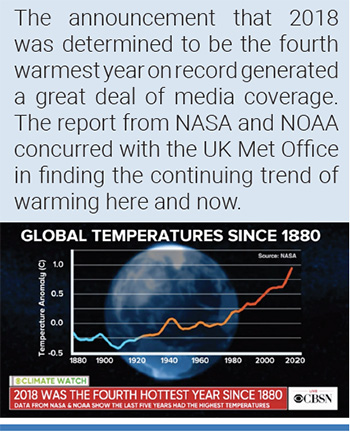 Also, a study in February from the journal Biological Conservation by Francisco Sánchez-Bayo and Kris Wyckhuis earned considerable media attention. This article reported that many insect populations worldwide are declining at a rapid rate and 40% of species are at risk for extinction within the century. For example, BBC journalist Aylin Woodward provided stark reporting, beginning an article “Somehow, it's easier to be concerned about wolves, sea turtles, and white rhinos dying off than it is to feel remorse over vanishing bugs. But the loss of insects is a dire threat — one that could trigger a "catastrophic collapse of Earth's ecosystems," a new study said. The research, the first global review of its kind, looked at 73 historical reports on insect declines around the world and found the total mass of all insects on the planets is decreasing by 2.5% per year. If this trend continues unabated, the Earth may not have any insects at all by 2119”.
Also, a study in February from the journal Biological Conservation by Francisco Sánchez-Bayo and Kris Wyckhuis earned considerable media attention. This article reported that many insect populations worldwide are declining at a rapid rate and 40% of species are at risk for extinction within the century. For example, BBC journalist Aylin Woodward provided stark reporting, beginning an article “Somehow, it's easier to be concerned about wolves, sea turtles, and white rhinos dying off than it is to feel remorse over vanishing bugs. But the loss of insects is a dire threat — one that could trigger a "catastrophic collapse of Earth's ecosystems," a new study said. The research, the first global review of its kind, looked at 73 historical reports on insect declines around the world and found the total mass of all insects on the planets is decreasing by 2.5% per year. If this trend continues unabated, the Earth may not have any insects at all by 2119”.
Across the globe in February, there was a range of stories that intersected with the cultural arena. For example, there was news coverage (melding with political and economic coverage) of the development that Exxon Mobil has plans to partner with Qatar's national energy company to build a $10 billion natural gas export hub in Texas. Journalist Clifford Kraus from The New York Times noted, “Qatar Petroleum and Exxon Mobil said on Tuesday that they are making a big investment in American natural gas exports. The deal is designed in part to strengthen Qatar’s ties with the United States nearly two years after Saudi Arabia and its allies launched a trade embargo against the country. The companies said they would spend more than $10 billion to turn Golden Pass, a terminal in Texas originally built to import gas, into an export hub for gas extracted from shale fields in Texas, New Mexico and elsewhere. A deeper push into the United States would give state-owned Qatar Petroleum, already the biggest liquefied natural gas exporter in the world, quicker and cheaper access to Latin America, freeing more of its domestic production for lucrative Asian markets. Qatar is also making a bid to strengthen its relationship with the Trump administration, which has established close ties with Saudi Arabia”.
In addition, ongoing youth demonstrations in Europe continued to build momentum in February. These continued one day each week as students in Germany, Switzerland and Belgium walked out of school to protest European Union and nation-state government inaction on climate change. In February, media covered its spread to the UK and elsewhere. On February 15, Guardian journalists Matthew Taylor, Sandra Laville, Amy Walker and Poppy Noor reported, “Thousands of schoolchildren and young people in the UK have taken part in climate strikes with the support of a former UN climate chief, who said it was “time to heed the deeply moving voice of youth”. Christiana Figueres, who led the historic 2015 Paris agreement, said the fact that children were so worried about their future they were prepared to strike should make adults take urgent action. “It is a sign that we are failing in our responsibility to protect them from the worsening impacts of climate change,” she said. Initial reports suggested several thousand children walked out of lessons on Friday in protest at the mounting ecological crisis. Organisers said 3,000 had gathered in London, 2,000 in Oxford, 1,000 in Leeds and Exeter and 600 in Brighton”.
Also relating to cultural stories (and themes permeating other themes above), issues of race, socio-economics, justice and (in)equality have permeated reporting in February. For example, journalist Tracy Jan from The Washington Post reported, “Race appears to trump ethnicity when it comes to predicting wealth, according to a new report examining the economic disparities among Miami’s diverse population. Among the most provocative findings: Identifying as black or white was a bigger factor than ancestry or ethnicity in determining employment, income and homeownership… Descendants of black Americans, Afro-Caribbeans — primarily Haitians, Jamaicans, Trinidadians and Tobagonians — and black Latinos were more economically similar than Latinos of various ancestry who identified as white, the researchers found. The median wealth for U.S. black households was $3,700, compared with $12,000 for black Caribbean households and $107,000 for white households, the study found. Latinos who identified as white generally have higher household incomes and homeownership rates and lower unemployment rates than those of black Latinos, the study found”. This was a Kirwani Institute for the Study of Race and Ethnicity at Ohio State University report, authored by nine researchers.
March
Media attention to climate change and global warming in March increased in all regions and all countries monitored throughout the world from the previous month of February. March 2019 coverage was up 25% from February 2019, and nearly doubled from the amount of media attention to climate change or global warming in March 2018. In particular, in March 2019 coverage was up 5% in Africa, up 9% in Oceania, up 19% in Asia, up 27% in the Middle East, and up 48% in Central/South America compared to the previous month.
Figure 6. Word cloud showing frequency of words (4 letters or more) invoked in media coverage of climate change or global warming in thirteen Spanish- and Portuguese-language newspaper sources across ten Latin American countries in March 2019. |
Among monitoring at the country level, coverage increased 4% in Australia, 10% in Germany, 12% in the UK, 17% in Canada, 20% in India, 21% in New Zealand and 25% in the US. Furthermore, among the four wire services we now monitor – the Associated Press, Agence France Press (AFP), The Canadian Press, and United Press International (UPI) – there was a 55% increase in March 2019 coverage of climate change or global warming from February 2019 coverage, and nearly a doubling of coverage from March 2018 levels.
In March ecological and meteorological connections to climate issues populated overall coverage. For example, record-setting flooding in the US – particularly in the Midwest states of Wisconsin, Iowa and Nebraska – was covered, many stories making links to flood events and a warming world. For example, John Schwartz from The New York Times wrote, “Vast areas of the United States are at risk of flooding this spring, even as Nebraska and other Midwestern states are already reeling from record-breaking late-winter floods, federal scientists said on Thursday…More rainfall in the Midwest is a predictable consequence of climate change, according to the most recent National Climate Assessment, which was produced last year by 13 federal agencies. A warmer atmosphere can hold more moisture, which comes down as precipitation."
Also in March, an East African cyclone named ‘Idai’ – with damage most concentrated in Mozambique – prompted further articulations in media accounts of links between extreme events and a changing climate. Journalist Ruth Maclean from The Guardian reported on Monday, March 18 that Mozambique President “Filipe Nyusi told Mozambican radio he had seen ‘many bodies’ floating in the overflowing Pungwe and Busi rivers. “It appears that we can register more than 1,000 deaths,” he said, adding that more than 100,000 people were at risk because of severe flooding. At least 215 people have been confirmed dead and hundreds are missing across Mozambique, Malawi and Zimbabwe from Tropical Cyclone Idai, according to government agencies and the Red Cross, which said 1.5 million people had been affected”. Furthermore, journalist Jeffrey Gogo from The Herald in Harare, Zimbabwe observed, “On March 15, Harare woke up to some light winds in overcast conditions – as per the MSD’s [Meteorological Services Department] predictions. It drizzled in a few places. But it is the high risk areas such as Muzarabani or Chibuwe or Chisumbanje were the greatest concern lies, in the likely event of the tropical cyclone resulting in flash flooding at the scale of the havoc it has wrought in Mozambique…once again, this will be a litmus test for Zimbabwe’s preparedness to handle disaster situations, which, as a result of climate change, have become more frequent, intense and damaging”. And the Business Day newspaper based on Johannesburg, South Africa carried a story by Matthew Hill and Godfrey Marawanyika with Ana Monteiro from Bloomberg who noted, “The country is the third-most vulnerable on the continent to climate change, according to the Global Facility for Disaster Reduction and Recovery”. Two days later (March 20), reporters Tara John and Anna Cardovillas from CNN communicated that Amnesty International “urged authorities in Mozambique and Zimbabwe, countries that are prone to flooding, to adopt climate change policies that could reduce the impact of these events”, quoting Muleya Mwananyanda Amnesty International's deputy regional director for southern Africa who declared, "As the effects of climate change intensify, these extreme weather conditions can be expected to revisit us more frequently. The devastation wrought by Cyclone Idai is yet another wake-up call for the world to put in place ambitious climate change mitigation measures”.
Scientists fear Arctic heating could trigger a climate ‘tipping point’. Photo: Mario Tama/Getty Images. |
March media accounts also focused on primarily scientific dimensions of climate change and global warming. For example, a United Nations Environment report about wintertime warming in the Arctic garnered media attention early in the month. The report noted that Arctic temperatures were on pace to rise 3-5oC by mid-century, even with Paris Agreement-level engagement. They noted that such warming risks permafrost melt and consequent large releases of trapped methane which would then further amplify warming (a positive feedback). Journalist Fiona Harvey from The Guardian reported, “Sharp and potentially devastating temperature rises of 3oC to 5oC in the Arctic are now inevitable even if the world succeeds in cutting greenhouse gas emissions in line with the Paris agreement, research has found. Winter temperatures at the north pole are likely to rise by at least 3oC above pre-industrial levels by mid-century, and there could be further rises to between 5oC and 9oC above the recent average for the region, according to the UN. Such changes would result in rapidly melting ice and permafrost, leading to sea level rises and potentially to even more destructive levels of warming. Scientists fear Arctic heating could trigger a climate “tipping point” as melting permafrost releases the powerful greenhouse gas methane into the atmosphere, which in turn could create a runaway warming effect”.
As another example, a report from the Associated Press emitted in March then generated attention across multiple media sources, cascading into many other regional and local outlets. This report noted that urban heat records – noted in over 400 weather stations over the past two decades across the US – have been broken two times more frequently than cold weather records. Seth Borenstein and Nicky Forster from the Associated Press reported, “Over the past 20 years, Americans have been twice as likely to sweat through record-breaking heat rather than shiver through record-setting cold, a new Associated Press data analysis shows. The AP looked at 424 weather stations throughout the Lower 48 states that had consistent temperature records since 1920 and counted how many times daily hot temperature records were tied or broken and how many daily cold records were set. In a stable climate, the numbers should be roughly equal. Since 1999, the ratio has been two warm records set or broken for every cold one. In 16 of the last 20 years, there have been more daily high temperature records than low”.
Students take part in a demonstration in Düsseldorf, Germany, on the global day of action on March 15, 2019. Photo: Wolfgang Rattay/Reuters. |
Stories in March also picked up on cultural themes. For example, the student strike across 100 countries on March 15 provided fodder for news coverage. Catalyzed by 16-year-old Swedish student Greta Thunberg (who was nominated in March for a Nobel Peace Prize as well), young people walked out of schools and demonstrated their dissatisfaction for inadequate policy action in the face of 21st century climate change. Damian Carrington from The Guardian observed, “More than 1.4 million young people around the world took part in school strikes for climate action, according to environmental campaigners…Children walked out of schools on Friday in 2,233 cities and towns in 128 countries, with demonstrations held from Australia to India, the UK and the US…”
Reverberations from the events were observed through concatenate media reports in mid-March. For example, journalist Lindsay Brown from the BBC commented on local governments in the UK taking action, noting, “There's no single definition of what that means but many local areas say they want to be carbon-neutral by 2030. Some councils have promised to introduce electric car hubs or build sustainable homes to try to achieve that goal. It's a much more ambitious target than the government's, which is to reduce carbon emissions by 80% (compared to 1990 levels) by 2050”.
In March, considerable attention continued to be paid to political and economic content of coverage. For example, the Norwegian government’s decision to divest from oil and gas investments got media notice in the public sphere. Journalist Sarah McFarlane from The Wall Street Journal reported, “Norway’s $1 trillion sovereign-wealth fund took a major step toward selling off some of its substantial holdings in oil-and-gas companies, a move to shield the oil-rich nation from the risk of permanently lower crude prices. The Norwegian finance ministry proposed that the fund remove energy-exploration and -production companies from its portfolio, following a 2017 recommendation made by the central bank, which uses the fund to invest the proceeds of the country’s oil industry”.
April
April media attention to climate change and global warming continued to be driven by political, economic, ecological, meteorological, scientific and cultural themes. Globally, the quantity of coverage remained steady as compared with the previous month of March 2019. However, coverage in April 2019 went up nearly 50% compared to coverage globally in April 2018. Across the seven regions we monitor (Asia, Africa, Europe, Latin America, Middle East, North America, Oceania), Europe saw the largest rise in coverage, increasing nearly 12% from the previous month and up 89% from European coverage a year earlier (April 2018). Within Europe, United Kingdom media coverage increased remarkably, up 39% from the previous month of March, and up 167% from April 2018: cultural and political movements and pressures drove coverage, notably through Extinction Rebellion protests and Greta Thunberg actions.
Considering thematic dimensions of coverage in April, political and economic content punctuated media coverage throughout the month. For instance, in the US, discussions of federal (in)action on climate change continued. For example, mid-month an Environmental Protection Agency ‘Planning for Natural Disaster Debris’ guide with mentions of climate change adaptation warranted coverage. Washington Post journalists Juliet Eilperin and Brady Dennis wrote, “The Environmental Protection Agency published a 150-page document this past week with a straightforward message for coping with the fallout from natural disasters across the country: Start planning for the fact that climate change is going to make these catastrophes worse. The language, included in guidance on how to address the debris left in the wake of floods, hurricanes and wildfires, is at odds with the rhetoric of the EPA’s own leader, Andrew Wheeler”.
Democratic presidential candidate Beto O’Rourke leaves after speaking at a rally in Los Angeles on April 27, 2019. Photo: Lucy Nicholson/Reuters. |
Also in April, US Presidential candidates vying for the Democratic nomination have increasingly discussed their stances on climate change. These stances and platforms have garnered discernible media interest. For example, 2020 hopeful Beto O’Rourke’s $5 trillion plan to combat climate change attracted attention. CNN journalists Kate Sullivan and Leyla Santiago reported “former Texas Democratic congressman's plan called climate change "the greatest threat we face" and outlined a four-part framework to address this "existential threat" and "growing emergency…O'Rourke's ambitious, first major policy rollout comes amid questions from voters and critics about how he would take on key issues should he be elected president”. Meanwhile, Kathleen Ronayne and Will Weissert – covering Beto O’Rourke’s announcement for The Associated Press and PBS NewsHour – noted it “calls on the U.S. to guarantee net-zero carbon emissions by 2050, while promising to reach half that goal in just the next 11 years”.
Moreover, late in April, a report from the Institute for Energy Economics and Financial Analysis regarding the ongoing political economy of coal vis-à-vis renewable energy generation contributed to coverage of climate change. For example, CNN journalist Matt Egan wrote, “The renewable energy sector is projected to generate more electricity than coal during the month of April, according to a recent report published by the Institute for Energy Economics and Financial Analysis (IEEFA). That's never happened before. Coal, long the king of the power sector, has already been dethroned by natural gas, a much cleaner burning fossil fuel. Now, coal is facing intensifying pressure from wind and solar power” Egan quoted Dennis Wamstead from IEEFA who commented, “Five years ago this never would have been close to happening…The transition that's going on in the electric sector in the United States has been phenomenal”.
Across the globe in April, many news stories focused on the cultural arena. For example, in mid-April Amazon employees penned an open letter to CEO Jeff Bezos, stating discontent with the company’s stance on sustainability and climate change. Signed by approximately 4,500 workers, this disturbance in business cultures generated media attention. Journalist Karen Weise from The New York Times reported, “Employees at big tech companies have pushed back against their employers for working with the military and law enforcement offices, and demanded better treatment of women and minorities. Now, thousands of them are also taking on climate change. This week, more than 4,200 Amazon employees called on the company to rethink how it addresses and contributes to a warming planet. The action is the largest employee-driven movement on climate change to take place in the influential tech industry. The workers say the company needs to make firm commitments to reduce its carbon footprint across its vast operations, not make piecemeal or vague announcements. And they say that Amazon should stop offering custom cloud-computing services that help the oil and gas industry find and extract more fossil fuels”. Meanwhile, reporter Joseph Pisani from The Associated Press noted, “The online shopping giant, which already works with BP and Shell, has been trying to woo more oil and gas companies to use its technology to help them find drillable oil faster, angering workers who have been pushing Amazon to do more to combat climate change”.
In addition, media covered ongoing youth protests about climate change: particularly of Swedish activist Greta Thunberg as well as the UK-based movement Extinction Rebellion. For example, from US National Public Radio, David Greene and Frank Langfitt discussed how Extinction Rebellion disrupted ‘business as usual’ in London on April 17. Greene noted, “protesters have blocked traffic in parts of the city for several days now to put pressure on the British government to address climate change. Demonstrators have shut down 55 bus routes and, according to police, affected half a million people. Police have already made nearly 300 arrests”. Meanwhile, Guardian journalists Matthew Taylor, Damien Gayle and Libby Brooks observed, “Thousands of people have taken part in the civil disobedience protests since Monday, blockading four landmarks in the capital in an attempt to force the government to take action on the escalating climate crisis…the four sites – Marble Arch, Waterloo Bridge, Parliament Square and Oxford Circus – remained under the control of protesters, causing delays and diversions in the surrounding areas”. Also in The Guardian a few days later, journalists Vikram Dodd , Damien Gayle and Martha Busby wrote, “Governments will no longer be able ignore the impending climate and ecological crisis, Greta Thunberg, the teenage climate activist, has told Extinction Rebellion protesters gathered at Marble Arch in London. In a speech on Sunday night where she took aim at politicians who have for too long been able to satisfy demands for action with “beautiful words and promises”, the Swedish 16-year-old said humanity was sitting at a crossroads, but that those gathered had chosen which path they wish to take”.
Source: State of Global Air, 2019. |
Media attention was paid to scientific dimensions of climate change and global warming. The US government shutdown’s impact on ongoing scientific research on climate change garnered media attention. For example, a State of Global Air report delineated connections between climate change and public health. CNN journalist Ben Westcott reported, “air pollution is the fifth leading factor in mortality across the world, responsible for more deaths than alcohol, malnutrition and drugs. Particularly at risk are countries in Asia and Africa, where high levels of lung-clogging particulate matter (PM 2.5) and the regular use of fuels like coal and charcoal for home cooking result in a dramatically reduced life expectancy. PM 2.5 are dangerous airborne pollution particles smaller than 2.5 micrometers in diameter”. Meanwhile, journalist Fiona Harvey from The Guardian noted, “Air pollution contributed to nearly one in every 10 deaths in 2017, making it a bigger killer than malaria and road accidents and comparable to smoking…In south Asia, children can expect to have their lives cut short by 30 months, and in sub-Saharan Africa by 24 months, because of a combination of outdoor air pollution caused by traffic and industry, and dirty air indoors, largely from cooking fires. In east Asia, air pollution will shorten children’s lives by an estimated 23 months. However, the life expectancy burden is forecast to be less than five months for children in the developed world”.
Also in April, a study by Terry Hughes and colleagues published in the journal Nature generated media attention. This study found that climate change has been thwarting coral growth at the Great Barrier Reef. These findings garnered stories across media outlets such as the Guardian, BBC, USA Today, and New York Times. For example, journalist Doyle Rice at USA Today wrote, “Coral in Australia's iconic Great Barrier Reef just can't handle the heat. In fact, as global warming heats the reef, the coral there isn't able to recover”. And a study of glacial melt also published in the journal Nature led to considerable media attention. This study found that glacial melt contributed to 1 inch of sea level rise over the past 50 years. For example, Nina Avramova from CNN reported, “Most glaciers in Central Europe, Western Canada and the United States would vanish in the second half of this century under the current rates of ice loss, according to a new report. Glaciers have lost over 9,000 billion tons of ice between 1961 and 2016, according to a research letter published in the journal Nature on Monday. This amounts to a block of ice the size of Germany and almost 100 feet thick, or the size of the United States and 4 feet thick…”. Meanwhile, journalist Seth Borenstein from The Associated Press wrote, “Earth’s glaciers are melting much faster than scientists thought. A new study shows they are losing 369 billion tons of snow and ice each year, more than half of that in North America. The most comprehensive measurement of glaciers worldwide found that thousands of inland masses of snow compressed into ice are shrinking 18 percent faster than an international panel of scientists calculated in 2013”.
Last in April, media covered ecological and meteorological connections with climate issues. For example, cyclone Kenneth making landfall in Mozambique drew media attention, along with numerous discussions of links to climate change. Reports from CNN, The New York Times, The Washington Post, and BBC dotted the landscape of coverage exploring connections between the disasters associated with cyclone Kenneth (and Cyclone Idai in the previous month), yet connections are more often considered than definitively linked. For example, in an Associated Press article, journalist Frank Jordans observes, “Experts caution it is premature to say whether the unprecedented double-whammy of storms to hit the southern African nation is a consequence of climate change, and whether these cyclones will become more common”.
May
May media attention to climate change and global warming was up 27% throughout the world from the previous month of April 2019. While coverage in the Middle East dropped 25% from the previous month, coverage in all other regions increased from April 2019 into May 2019: among them, African coverage doubled, Asian media attention to climate change was up nearly 12%, European coverage increased nearly 22%, Central/South American coverage was up 23%, North America coverage increased almost 8% and coverage on Oceania rose over 86% compared to the previous month. Across international wire services – Associated Press, Agence France Presse, The Canadian Press and United Press International - media attention to climate change went up nearly 20%, while across international radio programming including American Public Media, National Public Radio, British Broadcasting Services, Southwest Radio Africa, Radio Balad and Radio France Internationale – media coverage increased nearly 30%.
Figure 7. Word cloud showing frequency of words (4 letters or more) invoked in media coverage of climate change or global warming in United States newspaper sources in May 2019. Data are from the Los Angeles Times, The New York Times, USA Today, The Wall Street Journal and The Washington Post. |
In the US, the steadily building US Democratic Presidential primary race generated numerous stories about rhetoric on climate action along with some plans too. For example, US Presidential hopeful and Washington governor Jay Inslee (mentioned second most frequently among the Democratic presidential hopefuls) released a set of plans (he called the ‘Evergreen Economy Plan’) to spur decarbonization of industry and society, clean energy development and emission-free transportation. Journalist Ken Thomas from The Wall Street Journal noted, “Gov. Jay Inslee proposed Friday that the U.S. should require carbon-neutral power by 2030, laying out a climate plan at the start of his presidential campaign that embraces elements of the Green New Deal, which many Democrats have backed. The Washington state governor, who has made climate change central to his long-shot bid for the White House, said that if elected he would set targets for achieving 100% clean energy across the electrical grid and in new vehicles and buildings”. In an article calling his plan ‘radical’, journalist Emily Holden from The Guardian reported, “Jay Inslee, the governor of Washington State, is introducing a second portion of his climate change plan as most Democratic contenders for president have yet to officially roll out their own big-picture proposals. Inslee’s 38-page document is focused on creating jobs. It outlines a $9tn investment over 10 years and seeks to create 8m jobs aimed at decarbonizing the economy. In an earlier plan, he vowed to make the US carbon neutral by 2045. Inslee wants to upgrade buildings, replace water and transit infrastructure, clean up manufacturing and quintuple spending on clean energy and climate research. Many of those efforts would require congressional legislation. The blueprint echoes progressives’ Green New Deal, but with far more details and fewer commitments to social programs”.
Meanwhile, 2020 presidential candidate Joe Biden’s occupation of a ‘middle ground’ approach on climate action drew much consternation and critique picked up on by media stories. Consequently, Joe Biden was mentioned most frequently among the Democratic presidential hopefuls in US press coverage of climate change in May 2019. For instance, Journalist Katie Glueck from The New York Times explained, “Former Vice President Joseph R. Biden Jr. defended his record on climate change on Monday in the face of criticism from rivals for the 2020 Democratic presidential nomination, and called for a “green revolution” that is “rational” and affordable…liberal activists and candidates like Senator Bernie Sanders of Vermont questioned his boldness on climate. Mr. Biden, echoing the language of revolution used by Mr. Sanders, said Monday that the nation needed ‘environmental revolution’” and that “he had, in fact, introduced the first bill addressing climate change in the 1980s”. Meanwhile, Fox News correspondent Lukas Mikelionis noted, “Biden’s plan, which hasn’t yet been released, aims to appeal to both die-hard environmentalists and blue-collar voters who voted for President Trump in 2016. The core of the plan will likely include the U.S. re-joining the Paris Climate Agreement and focusing on technology and regulations to limit emissions from the burning of fossil fuels”. Meanwhile, journalist Valerie Volcovici from Reuters wrote that Biden was “carving out a middle ground approach that will likely face heavy resistance from green activists”.
And in an effort not to be overlooked (see Figure 8), US Colorado senator and 2020 presidential hopeful Michael Bennet called for concerted climate action, including the founding of a ‘Climate Bank’ to devote resources to a net-zero emissions economy by mid-century. CBS News reporters Cara Korte and Adam Brewster noted, “The plan is broken into five "principles" which contain plans to fight climate change through a mix of individual and corporate incentives, government reforms, and executive actions. His proposal includes an implementation timeline, too, that would begin on his first day in office as president”.
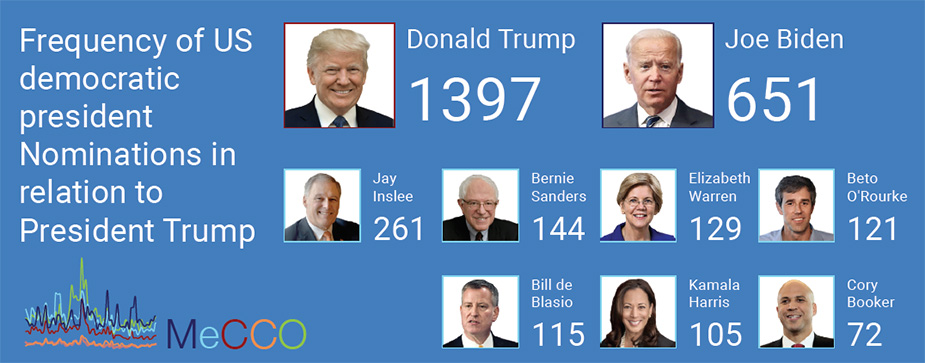
Figure 8. Infographic showing a Top 8 of current aspirants for the US Democratic nomination for president who are mentioned in US news related to climate change, relative to current US President Donald J. Trump. These are May 2019 frequencies of mentions of their last names in print media articles where climate change or global warming are also invoked. Data are from 559 articles in May 2019 in The Los Angeles Times, The New York Times, USA Today, The Wall Street Journal and The Washington Post.
And in May 2019, beyond stories of US politics and climate change, there were many other media stories addressing political and economic connections with climate issues around the world. For example, in the UK, news was made when the country set a record (of a week) without producing energy from coal: this was newsworthy in part due to that having been the longest stretch of coal-free power for over 100 years, and in part because it was seen as a sign of carbon-free energy generation to come in the UK. Journalist Jasper Jolly from The Guardian wrote, “Britain has gone a week without using coal to generate electricity for the first time since Queen Victoria was on the throne, in a landmark moment in the transition away from the heavily polluting fuel…Coal-fired power stations still play a major part in the UK’s energy system as a backup during high demand but the increasing use of renewable energy sources such as wind power means it is required less. High international coal prices have also made the fuel a less attractive source of energy. The latest achievement – the first coal-free week since 1882, when a plant opened at Holborn in London – comes only two years after Britain’s first coal-free day since the Industrial Revolution. Burning coal to generate electricity is thought to be incompatible with avoiding catastrophic climate change, and the UK government has committed to phasing out coal-fired power by 2025”.
Joe Biden answered questions during a campaign event in Hampton, New Hampshire. Photo: Elizabeth Frantz/New York Times. |
National-level elections in Australia and India in May 2019 also connected to themes of climate change and global warming policy. In particular, there was a doubling of media portrayals of climate change in Australia compared to the previous month, largely through connections made between the Australian election and climate change. For example, in an article entitled ‘Australia’s Politics May Be Changing With Its Climate’, journalist Somini Sengupta from The New York Times covered the lead up to the May 18 Australian elections, writing, “It’s been a year of extremes for this country. The hottest summer ever. Torrential rains in the north. A crippling drought in its southeastern farm belt. Now, with national elections scheduled for May 18, a vital question looms: To what degree will climate change sway the way Australians vote? The answer could provide important lessons for other democracies in the age of climate change”.
In May, ecological and meteorological content also shaped overall media coverage throughout the month. Particularly, a spate of tornado activity in May in North America then prompted questions about how this increase may relate to a changing climate. For example, Associated Press journalists Rick Callahan and Grant Schulte wrote, “So far this year, 38 people have died in 10 tornadoes in the United States, including a combined seven within the last week in Iowa, Missouri, Oklahoma and Ohio. The relative quiet in recent years followed the massive tornado that killed 161 people and injured more than 1,100 in Joplin, Missouri, in 2011. The EF5 storm packed winds in excess of 200 mph and was on the ground for more than 22 miles. Scientists also say climate change is responsible for more intense and more frequent extreme weather such as storms, droughts, floods and fires, but without extensive study they cannot directly link a single weather event to the changing climate”. Meanwhile, journalists Kevin Williams and Alan Blinder from The New York Times noted, “Climate change is increasingly linked to extreme weather, but limited historical information, especially when compared with temperature data that goes back more than a century, has made it difficult for researchers to determine whether rising temperatures are making tornadoes more common and severe. Kerry A. Emanuel, a professor of atmospheric science at the Massachusetts Institute of Technology who specializes in hurricanes, noted that the science of the connection between tornadoes and climate change is simply less comprehensive than what researchers have compiled on tropical cyclones. Dealing with tornadoes and climate change, he said, is “absolutely complicated,” and there are relatively few papers that discuss tornadoes and climate because “it’s almost impossible to see any signal in the data.” What’s more, he said, the data of the current generation of radar technology goes back to only about 1990, a shorter period than that for good hurricane data”. And, NBC News reporter Denise Chow commented, “Climate change is causing ocean temperatures and global surface temperatures to increase, which in turn drives atmospheric instability when warm, moist air moves across the middle of the country, according to Kevin Trenberth, a senior scientist at the National Center for Atmospheric Research in Boulder, Colorado. “All of this provides more fuel for thunderstorms and sets the stage for tornadoes to develop,” Trenberth said. But while scientists also predict that wind shear may decrease as the Arctic warms, climate models show that atmospheric instability from climate change will probably contribute to more tornadoes overall. “If you don’t have a cold Arctic, it’s hard to get a really strong wind shear across the Pacific Ocean,” Gensini said. “It’ll be a bit of a struggle between these two blocking weather patterns, but our climate models show that instability wins out, which suggests that we’ll see more tornadoes.” Gensini said it is difficult to know the impact that climate change is having on specific extreme weather events, or in particular regions of the country, but that general trends are consistent with models that incorporate the planet’s changing climate. “The analogy I like to use is with baseball’s steroid era,” Gensini said. “It’s a very difficult question to answer if this one home run was caused by steroids, but when you look at the batting average or the number of home runs over that time period, it’s easy to say that, yes, statistically a lot of those home runs were likely caused by steroids”.
Keeper Zachariah Mutai in Kenya attends to Fatu, one of only two female northern white rhinos left in the world. Photo: Sunday Alamba/AP. |
Also, connections between flooding and climate change in the US Midwest generated media attention as May came to a close. For example, in an article titled ‘Mississippi River flood is longest-lasting in over 90 years, since 'Great Flood' of 1927’ USA Today journalist Doyle Rice reported, “Flooding in at least 8 states along portions of the Mississippi River – due to relentless, record-breaking spring rainfall – is the longest-lasting since the "Great Flood" of 1927, the National Weather Service said…As the planet warms due to human-caused climate change, heavy downpours are increasing in the Midwest, according to the National Climate Assessment. From the early 1990s to the mid-2010s, very heavy precipitation events in the Midwest increased by 37%, the assessment said”. This has delayed planting of crops in the Midwestern ‘breadbasket’, and further connections to a changing climate have been raised in media accounts. For example, journalist Katie Mettler from The Washington Post noted, “For the past five years, the 18 states that produce the majority of the United States’ corn crop had an average of 90 percent of their fields planted by the end of May, according to data released Tuesday by the Agriculture Department. At the same point this year, 58 percent of the corn crop is in the ground. The outlook for soybeans is just as dismal, with 29 percent in the ground compared with 66 percent in years past. In individual states, the gap is even more severe. Just 22 percent of the corn crop had been planted as of May 26 in…Indiana. Soybeans stood at 11 percent…Some farmers blame this spring’s extreme weather on the changing climate, another example of the way Mother Nature has become increasingly unruly and unpredictable, alongside historically strong hurricanes, bitter cold and devastating, deadly wildfires. Others…say they’ve accepted that farmers can’t control the weather — and should instead look to federal aid and insurance programs that help people like him when the crops don’t cooperate”.
Across the globe in May, many news stories focused on scientific themes. For example, a report from the Intergovernmental Science-Policy Platform on Biodiversity and Ecosystem Services linking biodiversity loss and climate change generated significant media attention. Journalist Denise Chow from NBC News reported, “A sweeping report assessing the state of the natural world found that humans are having an “unprecedented” and devastating effect on global biodiversity, with about 1 million animal and plant species now threatened with extinction. A summary of the report’s findings was released Monday by the Intergovernmental Science-Policy Platform on Biodiversity and Ecosystem Services, which was established in 2012 by the United Nations Environment Programme and includes representatives from 132 countries”. Meanwhile, in rather stark language, BBC journalist Matt McGrath wrote, “On land, in the seas, in the sky, the devastating impact of humans on nature is laid bare in a compelling UN report. One million animal and plant species are now threatened with extinction. Nature everywhere is declining at a speed never previously seen and our need for ever more food and energy are the main drivers. These trends can be halted, the study says, but it will take "transformative change" in every aspect of how humans interact with nature. From the bees that pollinate our crops, to the forests that hold back flood waters, the report reveals how humans are ravaging the very ecosystems that support their societies”. This report also prompted The New York Times editorial team to publish an editorial entitled ‘Life as We Know It’ where they wrote, “Humanity’s culpability in what many scientists believe to be a planetary emergency has now been reaffirmed by a detailed and depressing report compiled by hundreds of international experts and based on thousands of scientific studies…“Most of nature’s contributions are not fully replaceable,” the report says. But humans can stop or at least limit the damage”.
Amid media attention paid to cultural dimensions of climate change and global warming in the month of May, a report from the Climate Literacy and Energy Awareness Network regarding teaching about climate change in K12 US schools earned press attention. Journalist Michael Melia from The Associated Press reported, “The Climate Literacy and Energy Awareness Network, funded by federal grants, reviewed more than 30,000 free online resources and found only 700 acceptable for use in schools. “There’s a lot of information that’s out there that is broken, old, misleading, not scientifically sound, not sound technically,” said Frank Niepold, a climate education coordinator at the National Oceanic and Atmospheric Administration”.
June
June media attention to climate change and global warming roughly doubled from June 2018, while trending slightly lower (-9%) from high levels in May 2019. At the country level, coverage was notably up in Spain (+8%), Sweden (+8%), India (+67%) and through international wire services (+8%) as well as global radio segments (+26%) in June.
The increase of 67% from the previous month in Indian media coverage of climate change – across The Hindu, Times of India, Indian Express and the Hindustan Times – can be attributed in part to record-breaking and sustained heat waves across the country in June, with temperatures peaking at 45.6 degrees Celsius or 114.08°F in New Delhi. For example, journalist Jacob Koshny from The Hindu reported, “critical groundwater resources, which accounted for 40% of India’s water supply, are being depleted at ‘unsustainable’ rates and up to 70% of India’s water supply is ‘contaminated’”.
Furthermore, an editorial from the Hindustan Times noted, “India, in any case, is facing the worst water crisis in its history. According to NITI Aayog, by 2020, 100 million will be affected by a shortage of groundwater in 21 Indian cities. And about 40% of the population will have no access to drinking water by 2030. It's not too difficult to discern why India is facing such an acute crisis. A report released by McGill University and Utrecht University blames irrigation techniques, industrial and residential habits combined with climate change for this problem”. Stories of severe heat compounding existing drought and water scarcity issues throughout India (and particularly in Northern India) provided news hooks for media stories. Also, stories of declining water levels in the India, Ganga and Brahmaputra basins, partly attributed to the rapid retreat of the Himalayan glaciers feeding these river basins generated media attention in India. And the impacts of heat waves on energy demands, particularly in cities, drove increased coverage.
In addition, US media coverage increased in June: coverage in the US was up 5% in print media and nearly 47% on television compared to the previous month. When this increase across outlets is disaggregated, one can detect a slightly different set of trends (see Figure 9). These show that in fact most of these increases are due to increased coverage at The New York Times followed by increases at The Washington Post in print, and on CNN, Fox News and MSNBC in television, coverage. In fact, these increases across US media coverage of climate change in recent months are occurring in spite of rather than because of more abundant coverage in the leading US network news organizations – ABC News, CBS News, NBC News, and PBS NewsHour * – along with US prestige press outlets – The Wall Street Journal and USA Today.
* Lower levels of US networks television coverage compared to the cable outlets can be explained in part by a more limited news hole. We at MeCCO continue to work to develop a way to normalize for those differences.
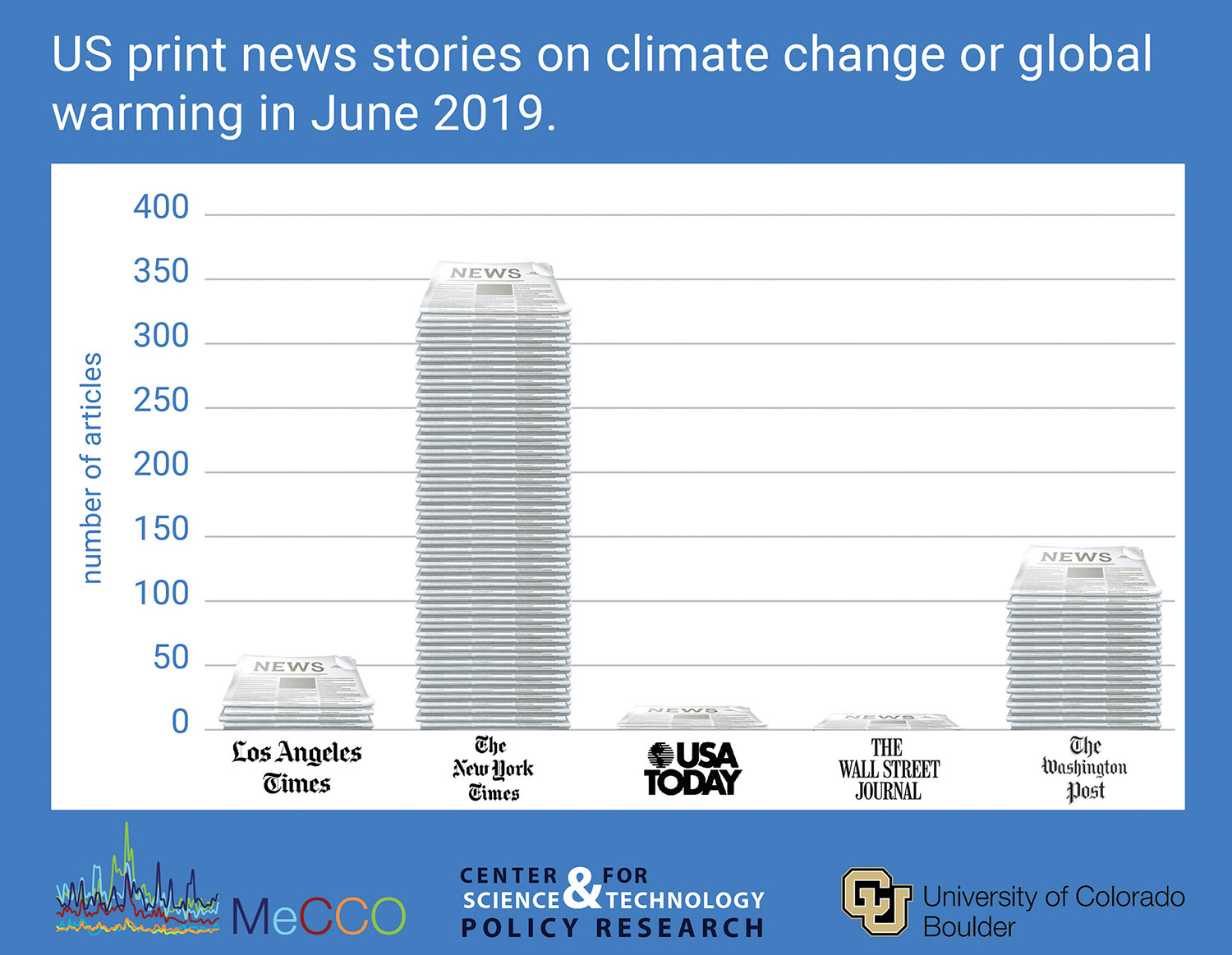
Figure 9. Number of news stories in June 2019 across US newspapers (The Washington Post, The Wall Street Journal, The New York Times, USA Today, and Los Angeles Times).
For example, one day in the print edition of The New York Times – Wednesday, June 5 – nearly outpaced coverage across the entire month in The Wall Street Journal (which carried a total of 11 stories in June). Stories on that day addressed issues associated with climate change including ‘Biden’s Plan for Climate Action Goes Beyond Obama’s Goals’ on the front page above the fold, international news of the Danish elections and how “climate and immigration fuel the divide” (page A5), news of protests in London to US President Trump’s visit, with mention by journalist Ceylan Yeginsu of one placard on the street reading ‘climate change is real, your tan is not’ (page A6), a story about climate change motivating France to end the disposal of $900 million in unsold goods each year (page A8), coverage of an ongoing US federal court case regarding whether young people have a constitutional right to be protected from climate change (page A10), a story by reporter Kendra Pierre-Louis on research into avoided deaths associated with climate mitigation and adaptation commitments in line with the Paris Agreement (page A20), a Nicholas Kristof op-ed addressing the role of climate change in migration patterns (page A26), and story by journalist Brad Plumer entitled ‘Companies Expect to Feel Climate Change’s Bite in 5 years’ (page B4).
Kelsey Juliana, greeting supporters outside a courthouse in Portland, Oregon. Photo: Andrew Selsky/Associated Press. |
Amid media attention paid to cultural dimensions of climate change and global warming in the month of June, the aforementioned Federal court case (called ‘Juliana vs the United States’) garnered media attention. For example, journalist John Schwartz from The New York Times noted that the ongoing case in the US Ninth Circuit Court of Appeals “was scheduled to begin last October, but the court granted the Trump administration an unusual pretrial appeal. Their decision could have important implications for this and other attempts to use the courts to pursue climate action across the United States. A brief filed by the plaintiffs in the case of Juliana vs the United States demands that the government step up to protect today’s children, and future generations, from the worst effects of climate change. It says they risk being deprived of their “rights to life, liberty, property, and public trust resources by federal government acts that knowingly destroy, endanger, and impair the unalienable climate system that nature endows”.
In addition, a Guardian weekend special section at the end of the month of June covered a number of stories from a conversation with Greta Thunberg and Alexandria Ocasio-Cortez, a story on a fast-warming Artic town called Longyearbyen and a feature on how climate experts have made changes in their own lives. This fed into increased coverage in the UK in June, along with burgeoning coverage in The Times (London) and Sunday Times particularly as June came to a close.
There were many other media stories addressing political and economic connections with climate issues around the world. For example, to start the month of June, US President Trump’s visit to the UK sparked media attention as it related to his climate stance and his take on intergenerational equity. Also, journalists Matthew Weaver and Kate Lyons from The Guardian reported “Prince Charles spent 75 minutes longer than scheduled trying to convince Donald Trump of the dangers of global heating, but the president still insisted the US was “clean” and blamed other nations for the crisis. Trump told ITV’s Good Morning Britain on Wednesday he had been due to meet the Prince of Wales for 15 minutes during his state visit, but the discussion went on for 90 minutes – during which the prince did “most of the talking”. “He [Prince Charles] is really into climate change and I think that’s great. What he really wants and what he really feels warmly about is the future. He wants to make sure future generations have climate that is good climate, as opposed to a disaster, and I agree”, noted US President Donald Trump. However, a number of his other comments to Piers Morgan on ITV (and reported elsewhere in the media during Trump’s visit) prompted Washington Post national correspondent Philip Bump to ask ‘Does Trump Understand How Global Warming Works?’. Pulling a quote from Trump in his piece that “I did say, well, the United States right now has among the cleanest climates there are, based on all statistics, and it’s even getting better. Because I agree with that. I want the best water, the cleanest water. Crystal clean, has to be crystal clean air”, Bump noted, “He appears instead to be talking about old-school 1970s-era pollution: smog and soot and so on. That’s also a problem, certainly, particularly in cities in China and India. It often stems from the same electricity production that generates carbon-dioxide emissions. But it’s not what we’re talking about when we talk about climate change”.
As another example, back on US soil during the month, US presidential hopefuls continued to roll out climate plans: these, in turn, generated media coverage. For instance, leading Democratic hopeful and former Vice President Joe Biden released his plan. Stories focused on the plan itself as well as on reactions to the ‘middle ground approach’. For example, journalists Dino Grandoni and Jeff Stein from The Washington Post wrote on June 4, “Joe Biden is embracing the framework of the Green New Deal in his bid for the White House, calling on the United States to eliminate climate-warming emissions by no later than the middle of the century while creating millions of new jobs and rallying the rest of the world to forestall dangerous rising temperatures. Biden released a 22-page climate plan Tuesday that appears at least in part aimed at blunting the criticisms of environmentalists and others on the left who have argued Biden’s 2020 presidential campaign is out of step with the current Democratic Party. With the former vice president consistently leading in the polling, the Democratic Party’s left flank has leveled broader critiques of Biden’s record and campaign policies, including his vote for the Iraq War as a senator and his support for a public option rather than the universal “Medicare-for-all” plan”. Associated Press reporter Hunter Woodall and Elana Schor also noted that he is “pitching a $5 trillion-plus climate proposal that he says would lead the U.S. to net zero emission of carbon pollution by 2050. The former vice president calls for $1.7 trillion in federal spending over 10 years, with the rest of the investments coming from the private sector. Biden proposes covering the taxpayer costs by repealing the corporate tax cuts that President Donald Trump signed in 2017, while eliminating existing subsidies to the fossil fuel companies. Biden's plan — a mix of tax incentives, federal spending, new regulation and more aggressive foreign policy on climate issues —comes as he pushes back on rivals' assertions that his environmental agenda isn't bold enough. Climate activists largely praised his pitch Tuesday, although some said the Democrats' 2020 front-runner still hasn't gone far enough to challenge the fossil fuel industry. His proposal calls the Green New Deal pushed by some Democrats on Capitol Hill "a crucial outline" but stops short of some of its timelines for weaning the U.S. economy off power from fossil fuels, even as he promises a "clean energy revolution" nationwide and internationally.
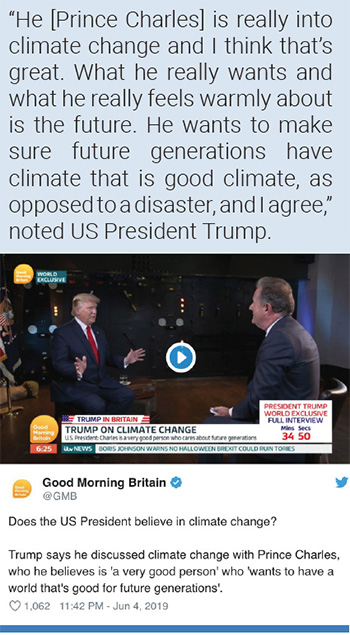 Meanwhile, Senator Elizabeth Warren (also a Democratic Presidential hopeful) released a set of plans to confront climate change. These prompted stories about the plan and comparing/contrasting hers with Joe Biden’s and others’. For example, journalist Ken Thomas compared it to the Joe Biden plan in the pages of The Wall Street Journal, while Reuters journalist Ginger Gibson wrote, “Democratic U.S. presidential hopeful Elizabeth Warren proposed on Tuesday spending $2 trillion on a new "green manufacturing" program to address climate change that would invest in research and exporting American clean energy technology. The manufacturing program is the first in a new series of "economic patriotism" proposals Warren is unveiling intended to create American jobs and help U.S. industry. "This is going to be a big plan for bold structural changes," Warren said at a campaign rally in Detroit, Michigan. Warren told the crowd of about 500 in a facility that teaches manufacturing skills that her proposal would be paid for by cutting subsidies in the oil and gas industry. Additionally, by all companies paying more taxes, she said, singling out Amazon.com. Among the more than 20 Democrats in the field hoping to challenge Republican President Donald Trump in November 2020, Warren has distinguished herself as the most prolific proposer of new policy positions”. Meanwhile, New York Times journalists Astead Herndon and Patricia Cohen noted the Senator Warren’s plan “would invest $2 trillion in climate-friendly industries over a decade, create a new cabinet-level Department of Economic Development and even manipulate the dollar to promote exports”.
Meanwhile, Senator Elizabeth Warren (also a Democratic Presidential hopeful) released a set of plans to confront climate change. These prompted stories about the plan and comparing/contrasting hers with Joe Biden’s and others’. For example, journalist Ken Thomas compared it to the Joe Biden plan in the pages of The Wall Street Journal, while Reuters journalist Ginger Gibson wrote, “Democratic U.S. presidential hopeful Elizabeth Warren proposed on Tuesday spending $2 trillion on a new "green manufacturing" program to address climate change that would invest in research and exporting American clean energy technology. The manufacturing program is the first in a new series of "economic patriotism" proposals Warren is unveiling intended to create American jobs and help U.S. industry. "This is going to be a big plan for bold structural changes," Warren said at a campaign rally in Detroit, Michigan. Warren told the crowd of about 500 in a facility that teaches manufacturing skills that her proposal would be paid for by cutting subsidies in the oil and gas industry. Additionally, by all companies paying more taxes, she said, singling out Amazon.com. Among the more than 20 Democrats in the field hoping to challenge Republican President Donald Trump in November 2020, Warren has distinguished herself as the most prolific proposer of new policy positions”. Meanwhile, New York Times journalists Astead Herndon and Patricia Cohen noted the Senator Warren’s plan “would invest $2 trillion in climate-friendly industries over a decade, create a new cabinet-level Department of Economic Development and even manipulate the dollar to promote exports”.
Other stories in June focused more squarely on economics. For example, there were numerous media reports on a new analysis of corporate disclosures by the Carbon Disclosure Project. Journalist Matthew Green from Reuters reported, “More than 200 of the world’s largest listed companies forecast that climate change could cost them a combined total of almost $1 trillion, with much of the pain due in the next five years, according to a report published on Tuesday. Even so, the findings by charity CDP suggested many companies still underestimated the dangers as scientists warn that earth’s climate system is on course to hit catastrophic tipping points without rapid cuts in carbon emissions”. Furthermore, New York Times reporter Brad Plumer wrote, “Under pressure from shareholders and regulators, companies are increasingly disclosing the specific financial impacts they could face as the planet warms, such as extreme weather that could disrupt their supply chains or stricter climate regulations that could hurt the value of coal, oil and gas investments. Early estimates suggest that trillions of dollars may ultimately be at stake. Even so, analysts warn that many companies are still lagging in accounting for all of the plausible financial risks from global warming”.
In mid-June, a European Union failure to agree on a carbon-neutral proposal for 2050 generated media attention. For instance, Associated Press reporters Samuel Petrequin and Raf Casert reported, “European Union leaders failed Thursday to back a plan to make the bloc’s economy carbon neutral by 2050 in spite of promises to protesters across the continent to fight harder against climate change. Ahead of a U.N. meeting in the fall, the proposal was relegated to a non-binding footnote in the final statement of Thursday’s summit of EU leaders in Brussels. “For a large majority of Member States, climate neutrality must be achieved by 2050,” the footnote read. “However, for the change in approach to become an official target, all 28 EU countries need to back the change. The non-decision showed the rift between the western member states and the eastern nations on climate change. According to French president Emmanuel Macron and several other diplomatic sources, 24 countries including Britain, France and Germany supported the initiative, but were held back by Poland and three other nations which heavily depend on a fossil-fuel economy”.
Later in June, the first round of US Democratic Primary Presidential Debates also generated attention (as much for the absence of climate change discussions as their presence), along with the United Nations Climate Conference – the fiftieth sessions of the Subsidiary Body for Scientific and Technological Advice and the Subsidiary Body (SB 50) for Implementation – in Bonn, Germany generated media coverage.
In this photo taken on June 13, 2019 sled dogs make their way in northwest Greenland with their paws in melted ice water. Photo: Steffen M. Olsen/Danish Meteorological Institute. |
In June, ecological and meteorological content also shaped overall media coverage throughout the month. Of note, a photograph of dogs pulling a sled through melted water in Greenland made it to many news reports and print media due to the striking image of warming. Stories that accompanied the shot described ice loss due to ‘unseasonably’ high Arctic temperatures. For example, CNN meteorologist Brandon Miller reported, “Over 40% of Greenland experienced melting Thursday, with total ice loss estimated to be more than 2 gigatons (equal to 2 billion tons) on just that day alone. While Greenland is a big island filled with lots of ice, it is highly unusual for that much ice to be lost in the middle of June. The average ‘melt season’ for Greenland runs from June to August, with the bulk of the melting occurring in July. To visualize how much ice that is, imagine filling the National Mall in Washington with enough ice to reach a point in the sky eight times higher than the Washington Monument (to borrow an analogy Meredith Nettles from Columbia University gave to The Washington Post)…This much melting this early in the summer could be a bad sign, indicating 2019 could once again set records for the amount of Greenland ice loss”. Meanwhile, journalist Henry Fountain from The New York Times wrote, “The Arctic spring thaw has begun with a bang, with extensive melting of the Greenland ice sheet and sea ice loss that is already several weeks ahead of normal, scientists said. A stagnant zone of high-pressure air over Greenland last week brought warm air from the south, raising temperatures as much as 40 degrees Fahrenheit above normal. That, coupled with cloudless conditions, led to a pulse of melting across much of the ice sheet surface. Melting last Wednesday was the most extensive, at 275,000 square miles, or about 45 percent of the surface…”
Across the globe in June, many news stories also focused on scientific themes. Among them, a study of Himalayan glaciers published in the journal Science Advances prompted a number of news stories in June. For example, journalist Jeff Berardelli from CBS News reported, “Keeping watch over ice on the Himalayan glaciers was certainly not the intended mission of a U.S. spy satellite program, called Hexagon, which operated from 1971 to 1986. Nevertheless, the declassified photos have revealed a rapid acceleration of Himalayan ice melt — doubling in just one generation. A new study by Columbia University's Earth Institute finds the glaciers have been losing 20 vertical inches of ice per year since 2000, double the rate of the late 20th century. To put that into perspective, the recent amount of ice lost each year is enough to fill 3.2 million Olympic-size swimming pools and more than enough to supply drinking water to every person on Earth for longer than a lifetime. To reach these conclusions, lead author Joshua Maurer and his team took a unique approach. They analyzed 40 years of satellite images of 650 glaciers spanning 1,200 miles across India, China, Nepal and Bhutan. Much of the 20th-century data came from images taken by U.S. spy satellites. The researchers then created a system to automatically turn these images into 3D models in order to measure the changing elevations of glaciers over time. They then compared these images with more recent data from newer satellites to determine ice volume changes”.
Also among them, a study examining heat deaths in major US cities in the future grabbed media interest. USA Today journalist Doyle Rice wrote, “Deadly summer heat will get worse as the globe warms, so putting the brakes on climate change by reducing carbon emissions will literally be a lifesaver for thousands of Americans, a new study suggests. In fact, researchers report that limiting global warming could drastically lower deaths in most of the 15 U.S. cities studied”. Meanwhile, reporter Emily Baumgaertner from The Los Angeles Times noted, “For decades, climate scientists have been designing models to predict global warming’s long-term ecological effects: sea level rise, coral bleaching, extinctions of entire species. Researchers have now taken a step that hits closer to home, characterizing for the first time how various climate scenarios outlined in the Paris agreement could affect heat-related deaths in humans. Spoiler alert: The results range from horrible to only marginally less horrible. If no change is made to current climate commitments, the global average temperature could rise 3 degrees Celsius above pre-industrial levels by the year 2100, and with it will come the type of extreme heat waves that are expected to occur once every 30 years. Researchers predict about 20,240 heat-related deaths across 15 U.S. cities whenever such an event occurs. But by limiting that temperature change to 2 or even 1.5 degrees Celsius — the goal of the Paris agreement — humans could prevent between 6,232 and 9,484 of those deaths, according to the research published Wednesday in the journal Science Advances”.
July
July media attention to climate change and global warming continued through ecological/meteorological, political, economic, scientific and cultural themes. Of note, New Zealand political developments contributed to a 31% increase in coverage from the previous month. Also, July Monsoon rains, floods and consequent landslides gripped India and contributed to a 5% increase in media coverage of climate change from June 2019 (along with an overall doubling of the amount of media coverage of climate change in India since April 2019). Meanwhile, July 2019 media coverage of climate change in Germany continued to rise like the mercury in the thermometer in continental Europe: it was up 9% from June and has been rising since April 2019. However, US television news coverage dropped 37% in July 2019, from the previous month’s numbers. CNN in particular dropped nearly 50%. Perhaps coverage of the ‘horse race’ for the Democratic nomination for US President displaced some attention in the finite CNN news hole, despite the many new stories described below.
UK media coverage has steadily increased over time. For instance, coverage in the first seven months in 2019 (January – July) has more than doubled from the first seven months of 2018. However, when these increases across outlets are disaggregated one can detect a slightly different set of trends. For example, stories in The Guardian (and Observer) and in The Times (and Sunday Times) ran the majority (55%) of climate change articles across these seven news outlets. Of note, The Daily Mail (and Mail on Sunday) accounted for just under 5% of overall newspaper stories in these seven UK news organizations (see Figure 10).

Figure 10. Number of news stories per day per outlet in July 2019 across UK newspapers (Daily Mail, The Guardian (and Observer), The Sun (and Sunday Sun), The Telegraph, Daily Mirror, The Scotsman (and Scotsman on Sunday), and The Times (and Sunday Times).
Ecological and meteorological content dominated overall media coverage throughout the month of July. Of note, Europe faced a number of heat waves in July that were tied to changes in the climate. Starting the month, records were set across the continent. Many stories documented the record-breaking heat. For example, journalist Rob Picheta from CNN reported on July 1, “Europe's scorching heat wave expanded across the continent on Saturday, with people from Britain to the Balkans sweltering under abnormally high temperatures after a record-breaking week. France is expecting temperatures of 39 degrees Celsius (103 degrees Fahrenheit) in parts on Saturday, a day after it shattered its record mark multiple times in one day. Spain, which is dealing with the aftermath of a wildfire that tore through 10,000 acres of forest in the country's north-east on Friday, is bracing for temperatures of up to 42 degrees, according to its national meteorological body AEMET. The country is still affected by a "mass of tropical wind coming from Africa," the agency said. And the UK saw its hottest day of the year by some distance, with the mercury rising to 33 degrees Celsius (91.4 Fahrenheit) and threatening the country's hottest-ever June mark of 35.6 degrees, set in 1976”. A few days later, reporter Doyle Rice from USA Today linked the high temperatures to the hottest global June on record. He noted, “Global warming exacerbated the heat wave that baked Europe late last week, a report released Tuesday said. The news came as a separate report said the globe sweltered to its hottest June on record. Europe's heat wave, which included France's all-time high temperature of 114.6 degrees last week, was “made more likely and more intense by human-induced climate change,” the World Weather Attribution group said in a release. They also said this is true for every heat wave in Europe nowadays. Specifically, the report said the extreme conditions from June 26-28 in Toulouse, France, were as much as 10 times more likely now than they were in 1900, before greenhouse gas emissions from industry had a major effect on the atmosphere. The burning of fossil fuels such as coal, oil and gas releases greenhouse gases such as carbon dioxide and methane into our atmosphere, which has warmed the planet to levels that cannot be explained by natural causes”.
Indian villagers take buckets down a well running dry to collect drinking water in the district of Samba. A heatwave triggered warnings of water shortages and heatstroke. Source: CNN. |
Also in early July, denizens along the US Gulf Coast braced for the impacts of Hurricane Barry to start the hurricane season. Just missing New Orleans, residents across the US state of Louisiana nonetheless were impacted. Numerous stories ran that tracked the storm and made links between hurricane events and climate change. For example, leading up to the storm making landfall, US National Public Radio journalist Rebecca Hersher reported, “People across southern Louisiana are spending the weekend worried about flooding. The water is coming from every direction: the Mississippi River is swollen with rain that fell weeks ago farther north, and a storm called Barry is pushing ocean water onshore while it drops more rain from above. It's a situation driven by climate change, and one that Louisiana has never dealt with, at least in recorded history. And it's raising questions about whether New Orleans and other communities are prepared for such an onslaught”. As a second example, journalists Kathy Finn and Timothy Gardner from Reuters wrote, “While no single storm can be linked directly to climate change, the trend of warming air and seas around the globe has caused conditions that scientists say will, on average, make storms stronger and rainier”. In the wake of the storm, New York Times journalist Christopher Flavelle reported, “New research shows that the extreme weather and fires of recent years, similar to the flooding that has struck Louisiana and the Midwest, may be making Americans sick in ways researchers are only beginning to understand. By knocking chemicals loose from soil, homes, industrial-waste sites or other sources, and spreading them into the air, water and ground, disasters like these — often intensified by climate change — appear to be exposing people to an array of physical ailments including respiratory disease and cancer…The movement of toxic substances by storms and wildfires joins a long list of threats that climate change poses to Americans’ health, whether they be more severe heat waves or the spread of dengue or other ailments previously restricted to the tropics. What makes this threat different, researchers say, is the ability of many contaminants to persist in the environment or in people’s bodies after the disaster has passed, and to accumulate in with each new storm or fire”.
On the other side of the planet, floods and consequent landslides in Asia also captured media attention. Areas of Nepal, Bangladesh and India faced intense rains as the monsoon season gripped the region. For example, BBC correspondent Navin Singh Khadka wrote, “When it comes to water resources, relations between India and Nepal have never been easy. But in recent years, the relationship has begun to worsen during the annual monsoon season, which lasts from June to September. Flooding inflames tensions between the neighbours, with angry residents on both sides blaming those across the border for their woes. This year, floods have been wreaking havoc in the region. Dozens have been killed in Nepal and Bangladesh, and more than three million people have been displaced in north and north-eastern India…Now, as climate change makes the monsoon itself erratic, experts fear that the issues between the two neighbours could become far more complicated”.
A record-setting European heat wave hit Greenland. Source: Associated Press/Caspar Haarløv “Into the Ice”. |
As July progressed, a ‘heat dome’ that sat over much of the US then garnered media attention to links to changes in the climate. Record-breaking temperatures from the US heartland to the east coast left five dead and thousands without power due to demand surges. Journalist Doyle Rice from The USA Today warned, “If you think it's hot now, just wait awhile. As the globe warms in the years ahead, days with extreme heat are forecast to skyrocket across hundreds of U.S. cities, a new study suggests, perhaps even breaking the ‘heat index’”. Meanwhile, in an article titled ‘Heat Waves in the Age of Climate Change: Longer, More Frequent and More Dangerous’ journalist Kendra Pierre-Louis wrote, “people with health issues, older people and young children are especially susceptible to the effects of extreme heat. It’s a threat that grows as climate change continues,” adding, “There’s another way that climate change worsens heat waves: by changing the jet stream. Those air currents in the atmosphere help move weather systems around and are driven by temperature differences, which are shrinking. So when heat waves arrive, they stay in place longer”.
Following that heat dome in North America, another heatwave baked Europe. Media covered temperature records falling across Germany, France, the UK, the Netherlands and Belgium. For example, journalists Angela Charlton and Kirsten Grieshaber from The Associated Press wrote in an article titled ‘Europe melts under Sahara heat wave, smashing heat records’, “Even ice cream, Italian gelato or Popsicles couldn’t help this time. Temperature records that had stood for decades or even just hours fell minute by minute Thursday afternoon and Europeans and tourists alike jumped into fountains, lakes, rivers or the sea to escape a suffocating heat wave rising up from the Sahara. On a day that no one on the continent will ever forget, two potential drug dealers in Belgium even called the police, begging to be rescued from the locked container they managed to get themselves trapped in. It was nearly impossible to keep up with the falling records as temperatures climbed higher and higher under a brutal sun — in Paris and London, in Belgium, Germany, the Netherlands — all places where air conditioning is not typically installed in homes, cafes or stores. Even office air conditioning systems strained under the hot, dry air that was trapped between two stormy weather systems. Climate scientists warned these types of heat waves could become the new normal but they loom as a giant challenge for temperate Europe. As emissions keep warming the planet, scientists say there will be more and hotter heat waves, although it’s too early to know whether this specific hot spell is linked to man-made climate change”. Meanwhile, Guardian journalist Jon Henley explained, “Germany, the Netherlands and Belgium have recorded all-time national temperature highs for the second day running and Paris has had its hottest day ever as the second dangerous heatwave of the summer sears western Europe. The extreme temperatures follow a similar heatwave last month that made it the hottest June on record. Scientists say the climate crisis is making summer heatwaves five times more likely and significantly more intense”.
The global potential tree cover representing an area of 4.4 billion hectares of canopy cover distributed across the world. Source: Bastin, J-F., Y. Finegold, C. Garcia, D. Mollicone, M. Rezende, D. Routh, C.M. Zohner, and T. W. Crowther, 2019. The global tree restoration potential. Science, July 2019, 76-79. |
To round out the scorching month in the Northern Hemisphere, Greenland was reported to also have suffered a heat wave, leading to rapid ice melt and forest fire outbreaks. In a Washington Post article entitled ‘The Greenland ice sheet is in the throes of one of its greatest melting events ever recorded’, journalists Jason Samenow and Andrew Freedman reported, “The same heat dome that roasted Europe and broke national temperature records in five countries last week has shifted to Greenland, where it is causing one of the biggest melt events ever observed on the fragile ice sheet. By some measures, the ice melt is more extreme than during a benchmark record event in July 2012, according to scientists analyzing the latest data. During that event, about 98 percent of the ice sheet experienced some surface melting, speeding up the process of shedding ice into the ocean. The fate of Greenland’s ice sheet is of critical importance to every coastal resident in the world, since Greenland is already the biggest contributor to modern-day sea level rise. The pace and extent of Greenland ice melt will help determine how high sea levels climb and how quickly”.
In addition to heat waves, hurricanes and flooding capturing media attention through associations with climate change, media stories also addressed political and economic connections with climate issues around the world. For example, in the US, market forces and insurance company pull-back struck the coal industry. Journalist Oliver Ralph from The Los Angeles Times noted, “Up to now, U.S. insurers have resisted joining the growing movement in Europe to stop selling insurance to coal-based power plants and coal mines because of the environmental damage they cause”. Meanwhile, BBC News reported, “Chubb has become the latest major insurer to cut its exposure to the coal industry, citing climate change. The firm will no longer underwrite the building and operation of new coal-fired plants or new risks for companies that generate more than 30% of their revenues from coal mining. Chairman Evan G. Greenberg said Chubb accepts "the reality of climate change... on our planet". Allianz, Hannover, and Lloyds Banking Group have scaled back coal insurance. The Switzerland-based insurer does most of its business in the US, where President Donald Trump has vowed to revive the coal sector. Chubb is thought to be the biggest insurer operating in the US to introduce the policy, and it could put pressure on firms such as AIG and Travelers to follow suit”.
Also in the US, in mid-July President Donald J. Trump delivered a speech promoting his environmental record, and this grabbed the attention of many media outlets. Amid widespread coverage, journalists Katie Rogers and Coral Davenport from The New York Times reported, “for nearly an hour in the East Room on Monday afternoon, Mr. Trump sought to recast his administration’s record by describing what he called “America’s environmental leadership” under his command. Flanked by several cabinet members and senior environmental officials — one a former lobbyist for the coal industry and the other a former oil lobbyist — Mr. Trump rattled off a grab bag of his administration’s accomplishments, which he said included “being good stewards of our public land,” reducing carbon emissions and promoting the “cleanest air” and “crystal clean” water… David G. Victor, the director of the Laboratory on International Law and Regulation at the University of California, San Diego, said the speech was the starkest example to date of the disconnect between Mr. Trump’s rhetoric and reality. “This speech is a true ‘1984’ moment,” he said”. Also, journalist Jennifer Ludden from National Public Radio noted, “President Trump used the pomp and circumstance of the East Room, complete with an entrance to "Hail to the Chief" and a bevy of supportive Cabinet members, to tout "America's Environmental Leadership" on Monday. There was no new policy announcement. In fact, the event felt mostly like a campaign rally. But it may amount to recognition that the environment and climate change are a growing concern for U.S. voters and an issue on which Democrats hold an edge”.
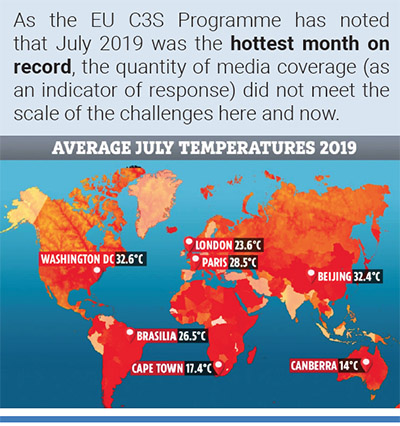 Moving from ecological and meteorological as well as political and economic dimensions of climate change stories in the media in July, additional attention was paid to cultural stories. For example, the fast-moving trend of universities, cities, states and countries declaring ‘climate emergencies’ generated media stories. For instance, Associated Press journalist Edith M. Lederer wrote, “Networks and organizations representing more than 7,000 institutions of higher and further education around the world have signed a letter declaring “a climate emergency” and committing to tackle it, the U.N. Environment agency said Wednesday. U.N. Environment representative Sam Barrett announced the initiative at a U.N. meeting promoting higher education. Organizers said they hope 10,000 institutions will sign the letter by the end of 2019. The letter says: “The young minds that are shaped by our institutions must be equipped with the knowledge, skills and capability to respond to the ever-growing challenges of climate change.” It commits the institutions to support a three-point plan that includes mobilizing resources for climate change research, increasing education on preserving the environment, and going carbon neutral by 2030, or 2050 at the very latest”.
Moving from ecological and meteorological as well as political and economic dimensions of climate change stories in the media in July, additional attention was paid to cultural stories. For example, the fast-moving trend of universities, cities, states and countries declaring ‘climate emergencies’ generated media stories. For instance, Associated Press journalist Edith M. Lederer wrote, “Networks and organizations representing more than 7,000 institutions of higher and further education around the world have signed a letter declaring “a climate emergency” and committing to tackle it, the U.N. Environment agency said Wednesday. U.N. Environment representative Sam Barrett announced the initiative at a U.N. meeting promoting higher education. Organizers said they hope 10,000 institutions will sign the letter by the end of 2019. The letter says: “The young minds that are shaped by our institutions must be equipped with the knowledge, skills and capability to respond to the ever-growing challenges of climate change.” It commits the institutions to support a three-point plan that includes mobilizing resources for climate change research, increasing education on preserving the environment, and going carbon neutral by 2030, or 2050 at the very latest”.
And not to be left behind, scientific ways of knowing about climate change also pervaded media stories in July. Among them, a new study of rapid sea ice decline in Antarctica grabbed attention. For example, journalist Seth Borenstein from The Associated Press wrote, “The amount of ice circling Antarctica is suddenly plunging from a record high to record lows, baffling scientists. Floating ice off the southern continent steadily increased from 1979 and hit a record high in 2014. But three years later, the annual average extent of Antarctic sea ice hit its lowest mark, wiping out three-and-a-half decades of gains — and then some, a NASA study of satellite data shows”.
Also, a study published mid-July in Science stating that planting billions of trees across the world could be one of the most effective tools available to fight climate change sparked significant media attention. For example, at the BBC journalist Manish Pandey wrote, “Planting trees is now the best way to tackle rising temperatures and climate change, according to a study this week from a group of scientists. Trees absorb carbon dioxide which means they can help to stop rising temperatures around the world. They also keep soil moist and reduce the risk of flooding”. Meanwhile, reporter Stephanie Demarco from The Los Angeles Times noted, “By removing carbon dioxide from the air, trees are one of our strongest allies in the fight against climate change. And if we planted a whole lot more of them in just the right places, they could reduce the amount of carbon in the atmosphere to levels not seen in nearly 100 years, researchers say. After examining more than 70,000 high-quality satellite photos of trees from all over the planet, ecologists concluded that the Earth could support 900 million additional hectares of tree cover. Those trees would eliminate about two-thirds of the carbon that's in the atmosphere today as a result of human activities”. But media attention was garnered in part through critiques and some context-setting. For example, a Guardian editorial reminded readers, “It won’t be enough, of course. Important – vital – as these efforts are to reduce the amount of carbon dioxide in the atmosphere, and undo some of the damage we have done in the last century, they will be wholly inadequate without a corresponding effort to stop the production of more greenhouse gases”.
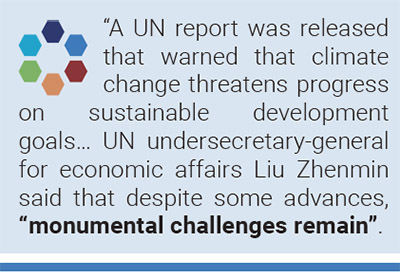 And a UN report was released in July that warned that climate change threatens progress on sustainable development. Among a number of alarming findings, the report pointed out that “an estimated 821 million people were undernourished in 2017” (up from 784 million in 2015) and “the worst hit region is sub-Saharan Africa, where the number of undernourished people increased from 195 million in 2014 to 237 million in 2017”. The report also warned that more than 55% of children globally “lacked minimum proficiency in reading and mathematics” while they observed, “investment in fossil fuels continues to be higher than investment in climate activities”. Among media coverage of this report, journalist Edith M. Lederer from the Associated Press noted that UN undersecretary-general for economic and social affairs Liu Zhenmin said that despite some advances, “monumental challenges remain”.
And a UN report was released in July that warned that climate change threatens progress on sustainable development. Among a number of alarming findings, the report pointed out that “an estimated 821 million people were undernourished in 2017” (up from 784 million in 2015) and “the worst hit region is sub-Saharan Africa, where the number of undernourished people increased from 195 million in 2014 to 237 million in 2017”. The report also warned that more than 55% of children globally “lacked minimum proficiency in reading and mathematics” while they observed, “investment in fossil fuels continues to be higher than investment in climate activities”. Among media coverage of this report, journalist Edith M. Lederer from the Associated Press noted that UN undersecretary-general for economic and social affairs Liu Zhenmin said that despite some advances, “monumental challenges remain”.
August
August media attention to climate change and global warming was up 20% throughout the world from the previous month of July, and up almost 83% from August 2018. At the regional level, from the previous month of July 2019 coverage in Asia was up nearly 14%, the European Union was up nearly 6%, North American coverage was up just over 32%, Latin American coverage was up almost 53%, African coverage was up over 8% and Oceania coverage was up approximately 33%. At the country level, of note Australian coverage was up nearly 62%, Canadian coverage was up nearly 38%, US coverage was up over 32% and New Zealand coverage was up slightly by just over 3%.

Figure 11. Word clouds showing frequency of words invoked in media coverage of climate change or global warming in United States newspaper sources in August (top left) - from the Los Angeles Times, The New York Times, USA Today, The Wall Street Journal and The Washington Post – Canadian sources (top right) – from The Globe and Mail, The Toronto Star, and National Post, as well as Australian sources (bottom left) – from The Sydney Morning Herald, Courier Mail & Sunday Mail, The Australian, The Daily Telegraph & Sunday Telegraph, and The Age, and New Zealand sources (bottom right) – from The New Zealand Herald, The Dominion Post, and The Press.
For a second straight month, ecological and meteorological content significantly shaped overall media coverage. Of note, in early August the Washington Post published a set of analyses of how climate change has impacted communities and counties around the US. Washington Post journalists Steven Mufson, Chris Mooney, Juliet Eilperin and John Muyskens reported, “Over the past two decades, the 2 degrees Celsius number has emerged as a critical threshold for global warming. In the 2015 Paris accord, international leaders agreed that the world should act urgently to keep the Earth’s average temperature increases “well below” 2 degrees Celsius by the year 2100 to avoid a host of catastrophic changes. The potential consequences are daunting. The United Nations Intergovernmental Panel on Climate Change warns that if Earth heats up by an average of 2 degrees Celsius, virtually all the world’s coral reefs will die; retreating ice sheets in Greenland and Antarctica could unleash massive sea level rise; and summertime Arctic sea ice, a shield against further warming, would begin to disappear. But global warming does not heat the world evenly. A Washington Post analysis of more than a century of National Oceanic and Atmospheric Administration temperature data across the Lower 48 states and 3,107 counties has found that major areas are nearing or have already crossed the 2-degree Celsius mark. Today, more than 1 in 10 Americans — 34 million people — are living in rapidly heating regions, including New York City and Los Angeles. Seventy-one counties have already hit the 2-degree Celsius mark. Alaska is the fastest-warming state in the country, but Rhode Island is the first state in the Lower 48 whose average temperature rise has eclipsed 2 degrees Celsius. Other parts of the Northeast — New Jersey, Connecticut, Maine and Massachusetts — trail close behind. While many people associate global warming with summer’s melting glaciers, forest fires and disastrous flooding, it is higher winter temperatures that have made New Jersey and nearby Rhode Island the fastest warming of the Lower 48 states”.
In August, media coverage also focused on the record-breaking heat from the month before. NOAA confirmed that July 2019 was the hottest month of any month on record on planet Earth. NOAA also reported that June 2019 was the hottest June on record. Many news stories covered these milestones. For example, journalist Sophie Lewis from CBS News reported, “This summer hasn't just felt like the hottest ever — it actually has been. July 2019 is now officially the hottest month on record, since record-keeping began 140 years ago. The average global temperature last month was 1.71 degrees Fahrenheit above the 20th-century average, NOAA announced Thursday. It follows the hottest June ever recorded, marking one of the hottest summers in recent history. Previously, July 2016 held the record for the hottest month ever. As of now, 2019 is tied with 2017 as the second-warmest year on record”. Meanwhile, journalist Robert Lee Hotz from The Wall Street Journal wrote, “This past July was the hottest month world-wide in more than a century of global record-keeping, with severe heat waves in Europe, Africa and parts of the U.S. boosting the overall global average temperature”.
Also in August, wildfires in the Amazon – and their links to a changing climate – generated global media attention. An increase of 83% from the previous year had many asking questions and connecting the dots between Brazilian forest management and climate change. For example, BBC reported, “Brazil's Amazon rainforest has seen a record number of fires this year, new space agency data suggests. The National Institute for Space Research (INPE) said its satellite data showed an 84% increase on the same period in 2018. It comes weeks after President Jair Bolsonaro sacked the head of the agency amid rows over its deforestation data. The largest rainforest in the world, the Amazon is a vital carbon store that slows down the pace of global warming. It is also home to about three million species of plants and animals, and one million indigenous people”. Meanwhile, journalist N'dea Yancey-Bragg from the USA Today wrote, “Forest fires in the Amazon are generating smoke that can be seen from space and may have caused a daytime blackout more than 1,700 miles away in the country's largest city. In the middle of the day Monday, the sky above São Paulo was blanketed by smoke from the wildfires raging in the Amazon region, according to local media reports. The smoke resulting from some of these wildfires was also captured in satellite images released by NASA last week”.
Moreover, as the fires continued through August, media reports covered how Brazilian president Jair Bolsonaro was mishandling the ongoing situation. Among numerous stories, journalist Marcelo Silva de Sousa, reporting for the Associated Press, wrote, “Amid global concern about raging fires in the Amazon, Brazil’s government complained Thursday that it is being targeted in smear campaign by critics who contend President Jair Bolsonaro is not doing enough to curb widespread deforestation. The threat to what some call “the lungs of the planet” has ignited a bitter dispute about who is to blame during the tenure of a leader who has described Brazil’s rainforest protections as an obstacle to economic development and who traded Twitter jabs on Thursday with France’s president over the fires. French President Emmanuel Macron called the wildfires an international crisis and said the leaders of the Group of 7 nations should hold urgent discussions about them at their summit…” Journalist Erik Ortiz from NBC News reported, “Environmental groups have blamed the policies of Brazilian President Jair Bolsonaro, who took office in January, for rolling back environmental protections that have paved the way for the illegal clearing of forests in favor of cattle farming and agriculture. On Wednesday, Bolsonaro posted a video to Facebook blaming nongovernmental organizations for setting the blazes as a tactic to malign him, although he provided no evidence for the claim”.
At the end of August, news of an approaching hurricane (Dorian) to Florida’s eastern coastline rang alarms. With expected landfall in the early days of September, some stories at the end of the month drew links between hurricanes and climate change. For example, journalist David Greene from National Public Radio spoke to Virgin Islands Representative Stacey Plaskett about how Hurricane Dorian's wind and rain affected the area. In the interview, she made links to a changing climate. She said, “Our population, of course, has declined after Irma and Maria hit St. Thomas and St. John as a Category 5. My family has been here, both sides of my family, almost 300 years, and we're going to deal with this. A lot of the damage to our public infrastructure was due in part to the neglect of the federal government over the years to supporting us in terms of federal dollars and percentages in the same manner that they did the mainland. And so they've given us funding not just to rebuild but to rebuild better than it was before. And so we're putting in - hardening our infrastructure - composite poles instead of wooden poles on - for utilities, putting things underground to ensure that we're able to deal with climate change, which is affecting us greatly”.
In addition to ecological and meteorological stories in August, media also ran numerous stories addressing political and economic connections with climate issues around the world. For example, in early August a Pacific Islands summit negotiated a communique about threats from climate change. With Australian Prime Minister Scott Morrison taking up an adversarial stance from the other member nations’ leaders, the interactions garnered media attention. For example, Guardian journalist Kate Lyons reported, “It was always going to be a showdown on the climate crisis. As leaders from the Pacific gathered in Tuvalu for their annual Pacific Islands Forum, there was one subject destined to dwarf all others and which pitted Australia, with its increasing emissions and plans for new coalmines, against its small island neighbours. And PIF 2019 turned out to be exactly that: a reckoning on the climate emergency confronting the Pacific. There were moving speeches from young Pasifika speaking of their fears for their future, tears in the leaders’ retreat, and accusations that Australia’s prime minister, Scott Morrison, had shown such disrespect toward his counterparts during their marathon 12-hour meeting, that the Fijian prime minister said Pacific countries may be driven further into the arms of China”. As another example, an Agence France Press article that ran in The Straights Times noted, “New Zealand Prime Minister Jacinda Ardern yesterday backed Pacific leaders' calls for urgent action on climate change, ramping up pressure on Australia to overhaul its stance on global warming. Australian Prime Minister Scott Morrison arrived at a meeting of Pacific Island leaders in Tuvalu with Canberra's regional leadership in question amid scrutiny of his government's climate change policies. Australia has long dominated the Pacific Islands Forum, an 18-member grouping consisting mainly of small atoll nations dotted around the vast Pacific Ocean. But its role is in doubt after leaders of the low-lying nations questioned in recent days whether Australia's climate-sceptic leader is committed to curbing a problem they see as a fundamental threat to their survival”. And getting further into the intricacies of the conflicts, journalist Tom McIlroy from The Australian wrote, “Deputy Prime Minister Michael McCormack has apologised for suggesting Pacific island nations could withstand the damaging effects of climate change by continuing to pick Australian fruit. Last week the Nationals leader said he was annoyed at countries at the Pacific Islands Forum meeting calling on Australia to shut down the domestic coal industry, saying they received large amounts of aid from Australia and “many of their workers come here and pick our fruit”. The comments followed Prime Minister Scott Morrison's clash with Pacific island leaders at the summit in Tuvalu over the inclusion of coal and temperature increases in a joint declaration from leaders”.
In the US, coverage of candidates’ climate plans as well as their departure from the US presidential primary, along with actions from the Democratic National Committee to block a debate on climate change, generated news associated with climate change.
Bernie Sanders speaks to striking telecommunications workers in Louisville, KY. Photo: Bruce Schreiner/AP. |
As one example of media coverage of climate plans, on August 22nd Senator Bernie Sanders released a $16.3 trillion Green New Deal plan to combat climate change. Journalist Lisa Friedman from The New York Times wrote, “Senator Bernie Sanders on Thursday released a $16.3 trillion blueprint to fight climate change, the latest and most expensive proposal from the field of Democratic presidential candidates aimed at reining in planet-warming greenhouse gases…Mr. Sanders was an early supporter of the Green New Deal, an ambitious but nonbinding congressional plan for tackling global warming and economic inequality. He is bestowing that same name upon his new plan, which calls for the United States to eliminate fossil fuel use by 2050. It declares climate change a national emergency; envisions building new solar, wind and geothermal power sources across the country; and commits $200 billion to help poor nations cope with climate change”. As another example, on August 26th entrepreneur Andrew Yang released his plan to address climate change. USA Today journalist Savannah Behrmann reported, “Calling the planet “a mess,” 2020 Democratic presidential candidate Andrew Yang released a climate change plan on Monday. His plan comes amid growing national and international concern about wildfires burning in the Amazon rainforest in Brazil -- and after President Donald Trump skipped a session of the G-7 meeting focused on climate, saying that his first priority is to maintain America's wealth, not trade away that prosperity for climate initiatives that he described as amounting to "dreams and windmills." The new plan also comes as Yang's upstart White House campaign appears to be picking up steam. He has qualified for next month's Democratic primary debate and a poll out Monday had the entrepreneur at 3% in the party's 2020 field”.
As an example of a candidate leaving the race, on August 21 Washington Governor Jay Inslee earned media attention when he announced the end of his campaign for US President. Among the many news stories, National Public Radio journalist Amita Kelly reported, “Inslee made climate change a top issue as a candidate. He proposed a 10-year action plan to, according to his campaign website, "achieve 100% clean electricity, 100% zero-emission new vehicles and 100% zero-carbon new buildings”.
Further attention was paid in the political sphere to the ongoing resistance from the Democratic National Committee to host a climate change-centered Democratic primary debate. For example, CBS News reporters Aaaron Navarro and Eleanor Watson noted, “Democrats and activists hoping to stage a presidential primary debate on climate change were dealt a significant blow on Thursday, when a party committee rejected a resolution that would have allowed candidates to participate. Washington State Democratic Chair Tina Powdowlaski authored the resolution, which called on the Democratic National Committee (DNC) to let candidates appear on stage simultaneously in a debate focused on the issue. The proposal, presented to the party's resolution committee at the DNC's summer meeting in San Francisco, was defeated by a vote of 17 to 8”. Meanwhile, Fox News journalist Greg Re focused on the reactions, reporting, “The Democratic National Committee's summer meeting in San Francisco erupted into a hail of protests on Thursday, as unruly environmentalist activists condemned the party's decision not to hold a presidential primary debate focused exclusively on climate change — a demand long sought by left-wing activists”.
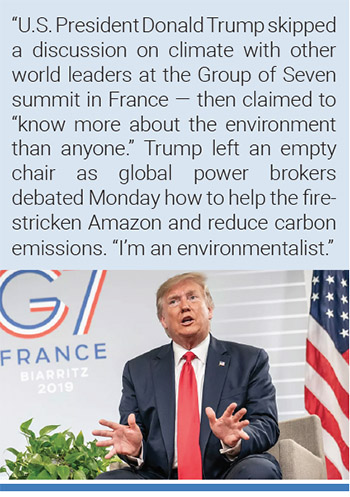 And at the end of August, G7 leaders met in Biarritz, France and numerous media stories noted US President Donald Trump’s absence at a climate change meeting. For example, journalist Kevin Liptak from CNN reported, “President Donald Trump skipped a session devoted to climate change at the G7 summit here, a snub aides wrote off as a scheduling conflict but nonetheless reflects Trump's isolation on the issue. As other leaders were taking their seats around a large round table, the chair reserved for Trump sat empty. The summit's host, French President Emmanuel Macron, gaveled the meeting to order anyway and launched into an explanation of a wrist watch made from recycled plastic. Later, the White House said Trump's schedule prevented his attendance”. As another example, Associated Press journalists Sylvie Corbet and Darlene Superville wrote, “U.S. President Donald Trump skipped a discussion on climate with other world leaders at the Group of Seven summit in France — then claimed to “know more about the environment than anyone.” Trump left an empty chair as global power brokers debated Monday how to help the fire-stricken Amazon and reduce carbon emissions. “I’m an environmentalist,” Trump told reporters, even as he celebrated America’s oil and gas wealth. Environmental activists declared the summit a failure, marching to demand tougher global emissions rules and more aid for the Amazon. Trump was scheduled to attend Monday’s session on climate, biodiversity and oceans at the G-7 summit in Biarritz, but didn’t. French President Emmanuel Macron, the summit host, shrugged off the absence, noting that Trump’s aides were there instead. Trump is a climate change skeptic who once had claimed it’s a hoax that was invented by the Chinese. His decision to withdraw the United States from the 2015 Paris climate accord has severely damaged global efforts to reduce emissions. Trump started the morning behind schedule, and held one-on-one meetings while others were in the climate discussions. However, his interlocutors, German Chancellor Angela Merkel and India’s Prime Minister Narendra Modi, managed to make it to the climate meeting. Asked about attending the climate session, Trump said it would be his next stop and that he wants clean air and water. But he never showed up.
And at the end of August, G7 leaders met in Biarritz, France and numerous media stories noted US President Donald Trump’s absence at a climate change meeting. For example, journalist Kevin Liptak from CNN reported, “President Donald Trump skipped a session devoted to climate change at the G7 summit here, a snub aides wrote off as a scheduling conflict but nonetheless reflects Trump's isolation on the issue. As other leaders were taking their seats around a large round table, the chair reserved for Trump sat empty. The summit's host, French President Emmanuel Macron, gaveled the meeting to order anyway and launched into an explanation of a wrist watch made from recycled plastic. Later, the White House said Trump's schedule prevented his attendance”. As another example, Associated Press journalists Sylvie Corbet and Darlene Superville wrote, “U.S. President Donald Trump skipped a discussion on climate with other world leaders at the Group of Seven summit in France — then claimed to “know more about the environment than anyone.” Trump left an empty chair as global power brokers debated Monday how to help the fire-stricken Amazon and reduce carbon emissions. “I’m an environmentalist,” Trump told reporters, even as he celebrated America’s oil and gas wealth. Environmental activists declared the summit a failure, marching to demand tougher global emissions rules and more aid for the Amazon. Trump was scheduled to attend Monday’s session on climate, biodiversity and oceans at the G-7 summit in Biarritz, but didn’t. French President Emmanuel Macron, the summit host, shrugged off the absence, noting that Trump’s aides were there instead. Trump is a climate change skeptic who once had claimed it’s a hoax that was invented by the Chinese. His decision to withdraw the United States from the 2015 Paris climate accord has severely damaged global efforts to reduce emissions. Trump started the morning behind schedule, and held one-on-one meetings while others were in the climate discussions. However, his interlocutors, German Chancellor Angela Merkel and India’s Prime Minister Narendra Modi, managed to make it to the climate meeting. Asked about attending the climate session, Trump said it would be his next stop and that he wants clean air and water. But he never showed up.
In August, cultural dimensions of climate change and global warming were picked up by media stories. For example, Swedish climate activist Greta Thunberg’s two-week journey across the Atlantic and arrival in New York City generated global news attention. For examples, National Public Radio journalist Jeff Brady reported, “After a two-week journey sailing across the Atlantic Ocean, 16-year-old Swedish climate activist Greta Thunberg arrived in New York on Wednesday at a marina in Lower Manhattan. Thunberg stepped off the emission-free racing yacht that brought her and held a news conference a few minutes later, saying, "The ground is still shaking for me”. On the other side of the Atlantic, Guardian journalist Oliver Millman wrote, “Unprecedented pressure exerted by young activists will push world leaders to address the unfolding climate crisis, even with a recalcitrant US under Donald Trump, Greta Thunberg has told the Guardian. Thunberg, the teenager whose school climate strikes have ignited a global youth-led movement, said that her journey to New York on a solar-powered yacht was symbolic of the lengths young people will take to confront the climate crisis…Thunberg’s vessel emerged from the mist of an unseasonably drizzly day to be met by a throng of supporters and media at a marina near the southern tip of Manhattan on Wednesday. Her arrival was heralded by a flotilla of 17 sailboats, charted by the UN, that intercepted her vessel near the Statue of Liberty”.
Swedish climate activist Greta Thunberg, 16, arrive in the U.S. after a 15-day journey crossing the Atlantic on a zero-carbon yacht. Photo: AFP/Getty. |
Many news stories in August also focused on scientific themes. Among them, a research product from the World Resources Institute examining countries around the world facing “extremely high” water stress earned media attention. Journalist Emily Holder from The Guardian wrote, “Worldwide, at the top of the list are Qatar, Israel, Lebanon, the Palestinian Territories and Iran. A total of 17 countries are facing “extremely high” risks and another 27 are facing “high” risks. Scientists have also linked the violence and civil war in Syria to a drought driven by rising temperatures and massive water withdrawals. In the African Sahel, a semi-arid region that stretches coast to coast across northern Africa below the Sahara, they have documented similar water stresses as millions have migrated out of the countryside. WRI’s experts explained that water stress is different from drought. But places where people are using water at a faster rate than it is replaced could see serious problems if they hit a drought – or a prolonged period without enough rain”. Focusing on the US context, Washington Post journalists Bonnie Berkowitz and Adrian Blanco reported, “The United States has enough water to satisfy the demand, but newly released data from the World Resources Institute shows some areas are out of balance. The WRI’s Aqueduct Water Risk Atlas researchers used hydrological models and more than 50 years of data to estimate the typical water supply of 189 countries compared to their demand. The result was a scale of “water stress” — how close a country comes to draining its annual water stores in a typical year…The United States ranked 71st of 189 countries, and low-medium on the stress scale, meaning we are pulling out just under 20 percent of our available water”.
In addition, an IPCC Special Report on Climate Change and Land generated significant media attention. Stories ran on this report around the globe. As a few examples, Los Angeles Times journalists Julia Rosen and Anna M. Phillips wrote, “Slashing greenhouse gas emissions from cars and power plants won’t be enough to avoid the worst effects of climate change. To meet the goals of the Paris climate accord, experts say, humanity also needs a new approach to managing the land beneath its feet. A sweeping new report from the United Nations’ Intergovernmental Panel on Climate Change highlights the myriad ways that rising temperatures have impacted agriculture, wildfire risk, soil health and biodiversity. The report also examines how land and its uses can exacerbate the effects of global warming — or help mitigate them”. Moreover, journalist Roger Harrabin from BBC reported, “A major report on land use and climate change says the West's high consumption of meat and dairy produce is fuelling global warming. But scientists and officials stopped short of explicitly calling on everyone to become vegan or vegetarian. They said that more people could be fed using less land if individuals cut down on eating meat”.
September
September media attention to climate change and global warming was at its highest level globally in nearly a decade. Compared to the amount of coverage in the previous month of August, global coverage was up nearly 24% and compared to the amount of coverage a year ago (September 2018), it was up 126%. Compared to August 2019, coverage also was up across all regions: Africa (+10%), Asia (+32%), Europe (+25%), Middle East (+6%), North America (+13%), Oceania (+20%), and Latin America (+28%). Compared to the previous month, coverage also was up across the wire services (+25%) and across global radio segments (+59%). This burgeoning coverage lent itself to the notion that media were increasingly treating climate change not as a distant challenge in space and time, but as an intersectional set of issues in the here and now.
Figure 12. Word cloud for US newspapers (Washington Post, Wall Street Journal, New York Times, USA Today, and Los Angeles Times) in September 2019. |
Trends, however, varied across countries. Compared to the previous month of August 2019, coverage was up in all eleven countries MeCCO monitors, except one: Canada (+31%), India (+26%), Germany (+26%), Spain (+81%), Japan (+49%), New Zealand (+17%), Norway (-13%), Sweden (+3%), UK (+8%), and US (+6%).
In September, media political and economic connections with climate issues dominated coverage around the world. For example, the month began as many US Democratic presidential hopefuls pushed out climate plans ahead of a September 4 climate town hall hosted by CNN. Journalists Juana Summers and Ellen Knickmeyer reported, “Five Democratic presidential candidates in the span of 24 hours have released sweeping plans to address climate change, ahead of a series of town halls devoted to the issue. On Wednesday, California Sen. Kamala Harris and South Bend, Indiana, Mayor Pete Buttigieg each unveiled their climate plans. New Jersey Sen. Cory Booker, Massachusetts Sen. Elizabeth Warren and former Obama cabinet member Julián Castro each laid out theirs on Tuesday. The flurry of plans comes ahead of a CNN town hall event on global warming, which 10 Democrats seeking the White House plan to attend. The forums come after liberals had demanded that the Democratic Party focus at least one debate on climate change, but a climate debate resolution was defeated at the Democratic National Committee’s summer meeting last month. Many Democrats see climate change as an urgent crisis. The issue is so urgent among Democratic voters that Washington Gov. Jay Inslee made action to limit the worst extremes of climate change the core of his presidential bid. But Inslee dropped out of the presidential race in August after failing to earn a spot in the September primary debate. Inslee would not have been invited to Wednesday’s climate change forum, either, having fallen short of the polling criteria. Since he abandoned his presidential bid, a number of candidates including Harris and Warren have embraced parts of the agenda he championed”.

Figure 13. Number of news stories per day per outlet in September 2019 across Indian newspapers (The Indian Express, The Hindu, Hindustan Times, and The Times of India).
Meanwhile, Wall Street Journal reporters Chad Day and Tarini Parti wrote, “Four more Democratic presidential candidates have rolled out plans to address climate change through trillions of dollars in government investment and a fundamental overhaul of the American energy economy. Sens. Kamala Harris of California, Cory Booker of New Jersey, Elizabeth Warren of Massachusetts and South Bend, Ind., Mayor Pete Buttigieg—all of whom had previously endorsed the Green New Deal, a sweeping proposal aimed at weaning the U.S. economy off fossil fuels—unveiled detailed plans…”
In early September, there was a 7-hour marathon of CNN town halls, featuring ten 2020 Democratic candidates in 40-minute consecutive segments. In contrast to the up to 15 minutes of climate change discussion in the June debate, this dedicated time to the intersectional climate challenge significantly boosted media attention both within the event itself, as well as through media accounts that followed.
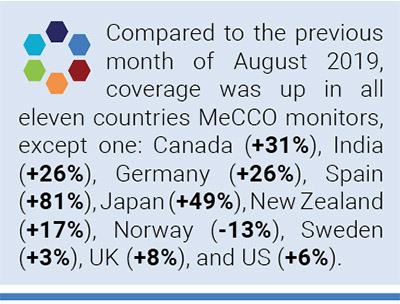 Stories abounded. For example, journalist Aamer Madhani from USA Today reported, “There’s perhaps no topic that more starkly divides Democratic hopefuls and President Trump than the debate on climate change. Democrats writ large see global warming as an existential crisis, while Trump has dismissed the issue as a Chinese-made “hoax". He has incorrectly suggested wind turbines cause cancer…until this week, global warming has remained largely a backburner issue in an internal Democratic debate that’s largely focused on who is best equipped to take on Trump in the general election and whether pursuing Medicare for All is the best way to fix health care in America. That could be changing. Capped with Wednesday's CNN's climate town hall — coming as Hurricane Dorian bears down on the southeastern United States — top Democratic hopefuls this week tried to demonstrate how they would approach turning the tide on global warming should they become the next commander-in-chief”.
Stories abounded. For example, journalist Aamer Madhani from USA Today reported, “There’s perhaps no topic that more starkly divides Democratic hopefuls and President Trump than the debate on climate change. Democrats writ large see global warming as an existential crisis, while Trump has dismissed the issue as a Chinese-made “hoax". He has incorrectly suggested wind turbines cause cancer…until this week, global warming has remained largely a backburner issue in an internal Democratic debate that’s largely focused on who is best equipped to take on Trump in the general election and whether pursuing Medicare for All is the best way to fix health care in America. That could be changing. Capped with Wednesday's CNN's climate town hall — coming as Hurricane Dorian bears down on the southeastern United States — top Democratic hopefuls this week tried to demonstrate how they would approach turning the tide on global warming should they become the next commander-in-chief”.
As another example (among many), New York-based Guardian journalists Emily Holden and Oliver Milman noted, “Democrats vying for president revealed a fundamental split over how aggressively the US should tackle climate change in a seven-hour town hall meeting on Wednesday. Bernie Sanders painted an apocalyptic future wreaked by the climate crisis and pledged to wage war on the fossil fuel industry. A high-energy Elizabeth Warren urged optimism for building a better America and the former vice-president Joe Biden, who has a pitched a more moderate proposal, said he would push other nations to recommit to stronger action”.
Greta Thunberg speaks to world leaders at UN’s climate summit in September 2019. Source: BBC. |
Then in mid-September the UN General Assembly and dedicated day – the Climate Action Summit – addressing climate policy action further boosted media attention. Among many media accounts, BBC journalist Roger Harrabin commented, “The UN’s climate summit has closed amidst cautious praise for its achievements, and bitter condemnation for its failures. On the plus side, more than 60 nations announced they were working on or exploring plans to reduce greenhouse gas to virtually zero. And a similar number said they would definitely boost their climate change ambitions by next year. On the minus side, the campaigner Greta Thunberg blasted leaders for what she called inadequate ambition that risked the future of the young. Germany’s pledge, for instance, was described by critics as totally unfit to meet carbon-cutting targets it’s already promised. And scientists will warn on Tuesday of alarming changes in the natural world, including melting ice and sea level rise beyond previous projections. So it’s possible to describe the UN summit as a cup half-full, or a cup three-quarters empty. That said, there were very clear signs that around the world people are waking up to the threat of an over-heating climate. India, China and the EU say they will deliver tougher carbon-curbing plans in 2020”.
Meanwhile, Associated Press journalist Seth Borenstein noted, the UN Secretary-General Antonio “Guterres opened the summit Monday by saying: “Earth is issuing a chilling cry: Stop.” He told the more than 60 world leaders scheduled to speak that it’s not a time to negotiate but to act to make the world carbon neutral by 2050. “Time is running out,” he said. “But it is not too late.” Scolded for doing little, leader after leader promised the United Nations on Monday to do more to prevent a warming world from reaching even more dangerous levels. As they made their pledges at the Climate Action Summit, though, they and others conceded it was not enough…Secretary-General Antonio Guterres concluded the summit by listing 77 countries that committed to carbon neutrality by 2050, 70 nations pledging to do more to fight climate change, with 100 business leaders promising to join the green economy and one-third of the global banking sector signing up to green goals. “Action by action, the tide is turning,” he said. “But we have a long way to go.” Businesses and charities also got in on the act, at times even going bigger than major nations. Microsoft founder Bill Gates announced Monday that his foundation, along with The World Bank and some European governments, would provide $790 million in financial help to 300 million of the world’s small farmers adapt to climate change. The Gates foundation pledged $310 million of that”.
In the US context, the mid-September confrontation by the Trump administration with the California state government garnered media attention. For example, Los Angeles Times journalists Alexa Díaz and Anna M. Phillips observed, “The Trump administration warned California officials Thursday that the state is “failing” to meet federal water quality standards, the latest move in the president’s escalating political feud with the state’s liberal leaders. In a letter to California Gov. Gavin Newsom, Environmental Protection Agency Administrator Andrew Wheeler threatened possible enforcement action if the state did not improve the way it deals with lead, arsenic and human waste in its water. Wheeler wrote that officials in San Francisco, Los Angeles and the state as a whole “do not appear to be acting with urgency to mitigate the risks to human health and the environment that may result from the homelessness crisis.” The administrator’s accusations came after several weeks of mounting tension between the president and California officials. This week, the EPA threatened to cut federal transportation funding from California as punishment for not submitting timely plans for controlling air pollution, an announcement that came amid a legal fight between state and federal powers over whether California can set tougher car emissions standards than those required by the federal government”.
Beto O’Rourke speaking at CNN’s climate crisis town hall. Source: Edward M. PioRoda/CNN. |
As such, ecological and meteorological content shaped media coverage in September. Of note, the month began with Hurricane Dorian tearing a path of destruction through the Bahamas. On September 6th, NBC News journalist Linda Givetash reported, “The number of people confirmed dead after Hurricane Dorian tore through the Bahamas rose to 30 late on Thursday, but was expected to rise dramatically as the country assessed the devastation. Crews assembled to survey the damage have a daunting task of inspecting each home and collapsed structure scattered around the 50-mile range of islands to locate the dead, the country's health minister, Duane Sands, told NBC News. "It is a horrendous challenge right now and the process of certification and confirmation certainly does not in any way relate to the findings in the field," he said, adding that the findings suggest the death toll "will rise dramatically"”.
CBS News reported that same day, “CBS News flew with the U.S. Coast Guard over the areas hit hardest on Wednesday, seeing home after home torn apart. The U.N. said 70,000 are in immediate need of aid. Aboard the HC-144 cargo plane, the devastation is clear. The fragile islands were no match for Dorian's Category 5 fury and the landscape looks like a bomb site. Not only was the Coast Guard in rescue mode, but U.S. Customs and Border Protection is also helping out”. Also on September 6th, CNN journalist Madeline Holcombe and Dakin Andone added, “The US Coast Guard said it had rescued 205 people as of Friday. Rescues have concentrated on Bahamas' northern islands as international teams sent small planes and helicopters to reach those stranded and feed the displaced”.
By September 11, many media reports shared the updated counts of those missing, dead and displaced in the Bahamas by hurricane Dorian. For example, New York Times journalists Rachel Knowles and Frances Robles wrote, “About 2,500 people have been reported missing in the Bahamas in the wake of Hurricane Dorian, but the names have yet to be checked against those who evacuated or sought shelter, the government said Wednesday. The number of confirmed dead from the storm remained at 50 on Wednesday, a figure that government officials say is certain to rise. The Bahamas Defense Forces began posting pictures on social media this week of soldiers in hazardous material suits collecting muddied corpses and dropping them into pickup trucks. Dorian, a Category 5 hurricane, toppled thousands of homes on the Abaco Islands last week and flooded more on Grand Bahama, leaving large swaths of both nearly uninhabitable”.
In mid-September, news reports of the summer heat waves garnered further attention. For example, journalist Joshua Berlinger from CNN noted, “A pair of heat waves in France have been linked to the deaths of 1,435 people this summer by the country's health ministry. Two bouts of record-setting heat hit France and other parts of Europe from June 24 to July 7, and July 21 to July 27. The French Health Ministry said in a news release that the death rate during the two heat waves was 9.1% percent higher than usual. France and much of Europe saw record-breaking temperatures this summer. France recorded its highest-ever recorded temperature -- 45.9 degrees Celsius (114.6 Fahrenheit) -- on June 28 in the southern town of Gallargues-le-Montueux, according to the French national weather service. Experts worry heat waves such like these, driven by rising temperatures caused by greenhouse gas emissions, could become the new normal for Europe”.
Also in September, media coverage of ecological issues, such as wildfires in Indonesia, were linked in some outlets to agricultural practices as well as a changing climate. For example, in a New York Times article entitled ‘As Amazon Smolders, Indonesia Fires Choke the Other Side of the World: Thousands of fires, most of them set to clear land for plantations that make palm oil, created thick clouds of smoke that disrupted air travel and sickened people’ by Richard C. Paddock and Muktita Suhartono noted, “The fires in Indonesia and the Amazon contribute to climate change by releasing carbon dioxide, a major greenhouse gas, into the atmosphere and by destroying trees and vegetation that remove such emissions from the air”.
Relating to ecological themes for the month of September, US President Donald Trump put his political stamp onto media discussions, specifically onto attention paid to the projected path of hurricane Dorian in early September. That the President and the National Weather Service disagreed on the storm’s path generated media coverage. For example, CNN journalists Maegan Vazquez, Paul LeBlanc and Pamela Brown wrote, “President Donald Trump showed a map of Hurricane Dorian's trajectory in the Oval Office on Wednesday afternoon that appeared to include an addition showing the storm potentially affecting a large section of Alabama. Trump claimed the map was the original forecast. But a similar image released by the White House last week did not include any impact on Alabama in its forecast. "That was the original chart, and you see it was going to hit not only Florida but Georgia," Trump claimed Wednesday during a briefing, while showing a National Oceanic and Atmospheric Administration map with a black line encircling a portion of Alabama. "It took a right turn. And, ultimately, hopefully we're going to be lucky. It depends on what happens with South Carolina and North Carolina," he added. A White House official told CNN there had been a discussion in the Oval Office before the briefing about what the early models showed and that Dorian could have been worse than initial projections. One of the officials in the room agreed and used a black marker, unprompted, to make the point by extending a line all the way into the southeast region of Alabama, according to the official, who described the situation as "innocuous." The official said the graphic wasn't part of the initial presentation, and that it was behind Trump, but the President moved it during the presentation to show how bad Dorian could have been. A source familiar with the briefing would not deny that Trump had drawn the black line on the map. "I'm not going to get into that," the source said, but confirmed the line had been added during the storm briefing Wednesday, before the press entered the Oval Office”.
President Trump and Kevin K. McAleenan, the acting homeland security secretary, during a briefing on Hurricane Dorian on September 4, 2019. Source: Erin Schaff/New York Times. |
As the US President continued to press his case that the hurricane has Alabama in its path, stories relating to climate change and extreme weather continued. For example, journalist Seth Borenstein from the Associated Press reported, “Former top officials of the National Oceanic and Atmospheric Administration are assailing the agency for undermining its weather forecasters as it defends President Donald Trump’s statement from days ago that Hurricane Dorian threatened Alabama. They say NOAA’s action risks the credibility of the nation’s weather and science agency and may even risk lives. Dismay came from those who served under Republican and Democratic presidents alike as leaders in meteorology and disaster response sized up a sustained effort by Trump and his aides to justify his warning that Alabama, among other states, was “most likely” to be hit hard by Dorian, contrary to forecasts showing Alabama was clear. That effort led NOAA to repudiate a tweet from the National Weather Service the previous weekend assuring Alabamans — accurately — that they had nothing to fear from the hurricane. The weather service is part of NOAA and the tweet came from its Birmingham, Alabama, office”.
Furthermore, journalist Vanessa Romo from US National Public Radio noted, “NOAA's top scientist said Monday that he's investigating why the agency's leadership endorsed President Trump's false tweet that Alabama was in the path of Hurricane Dorian, after Birmingham-based meteorologists from the National Weather Service publicly pushed back on it. In an email, Craig McLean, acting chief scientist of the National Oceanic and Atmospheric Administration, called the move by the agency to back the president inappropriate, suggesting it was politically motivated”.
In September, cultural dimensions of climate change and global warming were picked up by media stories. For example, new polling data from CBS Newsas well as the Washington Post/Kaiser Family Foundation connected to the ‘Covering Climate Now’ initiative revealed some shifts in public opinion on climate change. Referring to the CBS News poll Jennifer De Pinto, Fred Backus and Anthony Salvanto noted, “A majority of Americans think action needs to be taken right now to address climate change. Most consider it at least to be a serious problem — including more than a quarter who say it is a crisis. Seven in 10 think human activity contributes a lot or some to climate change, and most feel they have a personal responsibility to do something about it, although many say they cannot afford to... Few Americans — just 1 in 10 — say humans do not contribute at all to climate change. Among this small group, most think the idea that human activity causes climate change is a lie or hoax meant to make people think the issue is more serious than it really is”.
Also in this cultural arena, on September 13th, 16-year old Swedish teen activist Greta Thunberg’s participation (along with approximately 1,500 other youth climate demonstrators) in a protest outside the US White House earned media attention. In late August, Greta had completed a two-week journey across the Atlantic to participate in a range of climate events and actions in the Americas in the coming months (see the August summary for more about media coverage of her trip).
Among the many outlets covering the cultural demonstration, USA Today journalist Max Cohen from reported, “After calling out politicians for climate inaction on "The Daily Show" this week, teenage climate activist Greta Thunberg is protesting Friday outside the White House to demand the U.S. government address the affects of climate change. The 16-year-old Swede is joined by youth activists in the protest, which marks the start of Thunberg's six-day stay in Washington, D.C. Along with dozens of other youth protesters, Thunberg chanted, "Hey hey, ho ho, climate change has got to go" as the activists marched outside the White House. The students held a variety of homemade signs, including "Make Earth cool again," "Save the ice caps" and "If you did your job, we would be in school." Just before 1 p.m., Thunberg briefly spoke to a crowd that had swelled to more than 100. “I’m so incredibly grateful for every single one of you,” she said “Never give up. We will continue,” she said amid loud cheers. “See you next week on Sept. 20!””.
In fact, then on Friday, September 20th, millions of people from over 130 countries were reported to have taken part in demonstrations calling for more coordinated and concerted climate action. News outlets closely covered the many gatherings. For example, Wall Street Journal journalists Tyler Blint-Welsh in New York City, David Winning in Sydney and Georgi Kantchev in Moscow reported, “The protests are designed in part to pressure governments into doing more to combat the worst effects of climate change…Hundreds of thousands of students from across the globe took the lead during a day of climate protests before next week’s United Nations summit on climate change”.
Then the following Friday, September 27th, saw more Youth Climate Strike actions in other parts of the world. There were many media accounts of these protest actions as well. For example, New Zealand Herald journalist Julia Czerwonatis reported on this second round of global actions while Independent journalist Conrad Duncan noted, “tens of thousands of young people have marched to New Zealand’s parliament as the second wave of global protests demanding swift action on climate change began on Friday. The latest round of protests is set to see demonstrations across Asia and Europe before culminating in a rally in Montreal, Canada, where teenage activist Greta Thunberg is scheduled to speak. The march in New Zealand’s capital of Wellington earlier on Friday was one of the largest protests ever held there, forcing organisers to change their security plans to accommodate the swelling crowd”.
It was also the case that many news stories in September focused on scientific themes. Among them, a report that heavy investment in climate adaptation in the next decade could then garner significantly larger benefits/avoided costs from a changing climate generated media attention. For example, journalist Victoria Gill from BBC News wrote, “Investing $1.8 trillion over the next decade - in measures to adapt to climate change - could produce net benefits worth more than $7 trillion. This is according to a global cost-benefit analysis setting out five adaptation strategies. The analysis was carried out by the Global Commission on Adaptation - a group of 34 leaders in politics, business and science”.
Meanwhile, journalist Frank Jordans from the Associated Press noted, “A group of leaders from business, politics and science have called for a massive investment in adapting to climate change over the next decade, arguing it would reap significant returns as countries avoid catastrophic losses and boost their economies. The Global Commission on Adaptation, comprising dozens of prominent figures including Microsoft co-founder Bill Gates and former U.N. Secretary-General Ban Ki-moon, urged governments and businesses to tackle the inevitable consequences of climate change, in addition to trying to curb it. In their 81-page report released Tuesday, the experts proposed investing $1.8 trillion between 2020 and 2030 in areas such as early warning systems, infrastructure that can withstand rising sea levels and extreme weather, and boosting agriculture to cope with droughts. Other areas they propose investing in are bolstering scarce water resources and improving mangrove forests that provide key protection to vulnerable shorelines in developing nations. Ban cited Bangladesh’s response to two devastating cyclones as a good example of the way countries can adapt to environmental threats. Following the deaths of hundreds of thousands of people in 1970 and 1991, the South Asian nation reinforced flood defenses, built shelters and trained volunteers, sharply cutting the death toll in subsequent storms. He also pointed to recent environmental devastation in the Bahamas as further proof of the importance of preparing for climate change”.
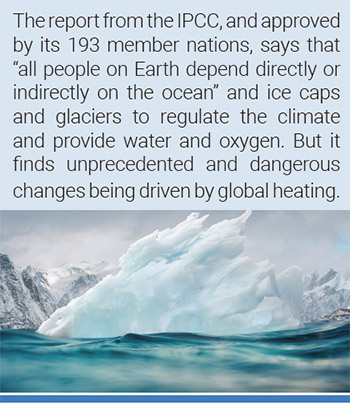 Then in late September, the IPCC released its Special Report on Oceans and the Crysophere, generated more science-infused media attention. This report provided updated assessments of intensifying hurricanes, sea level rise projections, threatened marine ecosystems and thawing permafrost, among many subjects. This special report spurred many media reports. For example, CNN journalist Drew Kann reported, “Cities from New York to Shanghai could see regular flooding, as sea levels rise faster than previously thought. Glaciers and ice sheets from the Himalayas to Antarctica are rapidly melting. And the fisheries that feed millions of people are shrinking. These are just some of the impacts that emissions of greenhouse gases have already triggered across the planet's oceans and frozen regions, according to a new landmark report from the United Nations' Intergovernmental Panel on Climate Change (IPCC). More than 100 scientists from 36 countries worked on the report -- titled the Special Report on the Ocean and Cryosphere in a Changing Climate. It is the last of three special reports from the IPCC following last October's urgent report that showed the world may only have until 2030 to keep global warming below 1.5 degrees, and August's report on climate impacts to the planet's lands”. As a second example, journalist Damian Carrington from The Guardian noted, “Extreme sea level events that used to occur once a century will strike every year on many coasts by 2050, no matter whether climate heating emissions are curbed or not, according to a landmark report by the world’s scientists. The stark assessment of the climate crisis in the world’s oceans and ice caps concludes that many serious impacts are already inevitable, from more intense storms to melting permafrost and dwindling marine life. But far worse impacts will hit without urgent action to cut fossil fuel emissions, including eventual sea level rise of more than 4 metres in the worst case, an outcome that would redraw the map of the world and harm billions of people. The report from the IPCC, and approved by its 193 member nations, says that “all people on Earth depend directly or indirectly on the ocean” and ice caps and glaciers to regulate the climate and provide water and oxygen. But it finds unprecedented and dangerous changes being driven by global heating. Sea level rise is accelerating as losses from Greenland and Antarctica increase, and the ocean is getting hotter, more acidic and less oxygenated. All these trends will continue to the end of the century, the IPCC report said. Half the world’s megacities, and almost 2 billion people, live on coasts. Even if heating is restricted to just 2C, scientists expect the impact of sea level rise to cause several trillion dollars of damage a year, and result in many millions of migrants”.
Then in late September, the IPCC released its Special Report on Oceans and the Crysophere, generated more science-infused media attention. This report provided updated assessments of intensifying hurricanes, sea level rise projections, threatened marine ecosystems and thawing permafrost, among many subjects. This special report spurred many media reports. For example, CNN journalist Drew Kann reported, “Cities from New York to Shanghai could see regular flooding, as sea levels rise faster than previously thought. Glaciers and ice sheets from the Himalayas to Antarctica are rapidly melting. And the fisheries that feed millions of people are shrinking. These are just some of the impacts that emissions of greenhouse gases have already triggered across the planet's oceans and frozen regions, according to a new landmark report from the United Nations' Intergovernmental Panel on Climate Change (IPCC). More than 100 scientists from 36 countries worked on the report -- titled the Special Report on the Ocean and Cryosphere in a Changing Climate. It is the last of three special reports from the IPCC following last October's urgent report that showed the world may only have until 2030 to keep global warming below 1.5 degrees, and August's report on climate impacts to the planet's lands”. As a second example, journalist Damian Carrington from The Guardian noted, “Extreme sea level events that used to occur once a century will strike every year on many coasts by 2050, no matter whether climate heating emissions are curbed or not, according to a landmark report by the world’s scientists. The stark assessment of the climate crisis in the world’s oceans and ice caps concludes that many serious impacts are already inevitable, from more intense storms to melting permafrost and dwindling marine life. But far worse impacts will hit without urgent action to cut fossil fuel emissions, including eventual sea level rise of more than 4 metres in the worst case, an outcome that would redraw the map of the world and harm billions of people. The report from the IPCC, and approved by its 193 member nations, says that “all people on Earth depend directly or indirectly on the ocean” and ice caps and glaciers to regulate the climate and provide water and oxygen. But it finds unprecedented and dangerous changes being driven by global heating. Sea level rise is accelerating as losses from Greenland and Antarctica increase, and the ocean is getting hotter, more acidic and less oxygenated. All these trends will continue to the end of the century, the IPCC report said. Half the world’s megacities, and almost 2 billion people, live on coasts. Even if heating is restricted to just 2C, scientists expect the impact of sea level rise to cause several trillion dollars of damage a year, and result in many millions of migrants”.
October
October media attention to climate change and global warming went down 8% from record levels of coverage in September 2019. However, it was still up 48% throughout the world from October 2018. While Middle East and North America coverage was up 10% and 7% respectively from the previous month, it was down in all other regions. At the country level, coverage also dropped from high levels in September in all countries we monitor, with the exception of increases in three countries: the United Kingdom (+8%), New Zealand (+5%) and Canada (+49%).
In particular, New Zealand’s record September 2019 coverage followed by continued 5% increase in October 2019 showed sustained media discussions of climate change and global warming (see Figure 14).

Figure 14. Number of news stories per day per outlet in October 2019 across the New Zealand newspapers The New Zealand Herald, The Dominion Post, and The Press.
In October 2019, Canadian coverage of climate change indeed went up 49% from the previous month of September 2019. Canadian coverage also reached record levels, and this was largely attributed to the role that climate change played in the October 21 Canadian Federal Election (see Figure 15). For example, journalist Chris Turner reporting for the Globe & Mail noted, “Climate change has never before played as central a role in a Canadian federal election as it did this year, and Mr. Trudeau ran hard on his record as the only leader offering both credible action on climate change and continued support for Canada’s oil and gas sector. The Liberals were, as Mr. Trudeau once put it, the only ones who saw both pipelines and wind turbines in Canada’s energy future. This was Mr. Trudeau’s grand climate bargain – better market access for oil and gas in a sort of trade for consensus on a workable path to a low-carbon economy – and Canadians have given him a shot at seeing that bargain through. I’d argue his legacy as a Prime Minister will ultimately rest on whether he can deliver on it. Mr. Trudeau’s reference to a referendum on the next 40 years was not self-aggrandizing on the climate front”. Meanwhile, over at the Toronto Star journalists Peter Lowen and Michael Bernstein reported after the election that “voters who turned away from the federal Conservatives were overwhelmingly concerned about climate change. Of the voters who did not vote for Scheer’s Conservatives, 20 per cent said they would have considered supporting the party. Among this Conservative-friendly pool of available voters, 77 per cent said climate change was among their top voting issues. Those same voters were unimpressed with the Conservative platform on climate change, giving it an average grade of D. What those results tell us is that the Conservatives left thousands of votes on the table, especially in battleground regions like Toronto and the 905 belt around Canada’s largest city. Had those people switched their vote to the Conservatives, we might be looking at a very different government today. If Conservatives are going to win elections in the future, they will need to advance a more credible plan on climate change — and that begins with not only accepting, but embracing, the reality of the carbon tax and rebate”.

Figure 15. Number of news stories per day per outlet in October 2019 across the Canadian newspapers Globe & Mail, the Toronto Star and the National Post.
This month, further media political and economic connections with climate issues dominated coverage around the world. For example, October began with discussions emanating from an International Monetary Fund (IMF) about putting a price on carbon. The IMF proposed that funds gathered through the pricing scheme would be dedicated to offset increases in energy prices. The report also posited that implementation of a $75 per ton tax on carbon by 2030 could keep warming to 2 degrees C. The IMF prognosticated that it would also lead to approximately 30% greenhouse gas (GHG) emissions reductions in the US and up to 45% GHG emissions reductions in China, India and other developing nations. This set of IMF pronouncements signaled further acceptance of carbon pricing in business and finance communities as a tool to effectively combat climate change.
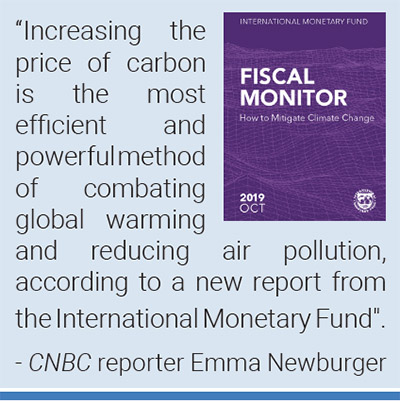 Consequently, this report generated substantial media attention. For example, CNBC reporter Emma Newburger reported, “Increasing the price of carbon is the most efficient and powerful method of combating global warming and reducing air pollution, according to a new report from the International Monetary Fund. While the idea of carbon taxes on fossil fuel corporations has been spreading across the globe in the past couple decades, increasing prices on carbon emissions has received widespread backlash from those who argue the tax would raise energy bills. But economists have long contended that raising the cost of burning fossil fuels like coal, oil and gas is the best way to mitigate climate change, and that revenue raised from the tax can be returned to consumers through rebates and dividends”.
Consequently, this report generated substantial media attention. For example, CNBC reporter Emma Newburger reported, “Increasing the price of carbon is the most efficient and powerful method of combating global warming and reducing air pollution, according to a new report from the International Monetary Fund. While the idea of carbon taxes on fossil fuel corporations has been spreading across the globe in the past couple decades, increasing prices on carbon emissions has received widespread backlash from those who argue the tax would raise energy bills. But economists have long contended that raising the cost of burning fossil fuels like coal, oil and gas is the best way to mitigate climate change, and that revenue raised from the tax can be returned to consumers through rebates and dividends”.
Meanwhile, Washington Post journalists Chris Mooney and Andrew Freedman wrote, “A global agreement to make fossil fuel burning more expensive is urgent and the most efficient way of fighting climate change, an International Monetary Fund study found on Thursday. The group found that a global tax of $75 per ton by the year 2030 could limit the planet’s warming to 2 degrees Celsius (3.6 degrees Fahrenheit), or roughly double what it is now. That would greatly increase the price of fossil-fuel-based energy — especially from the burning of coal — but the economic disruption could be offset by routing the money raised straight back to citizens…The IMF report comes out as financial institutions increasingly grapple with the risks associated with climate change, including damage from sea-level rise, extreme weather events and billions in fossil fuel reserves that might be in excess of what can be burned while also limiting warming. The Federal Reserve, for example, is taking a closer look at how climate change may pose a risk to economic stability. In the United States, a $75 tax would cut emissions by nearly 30 percent but would cause on average a 53 percent increase in electricity costs and a 20 percent rise for gasoline at projected 2030 prices, the analysis in the IMF’s Fiscal Monitor found. But it would also generate revenue equivalent to 1 percent of gross domestic product, an enormous amount of money that could be redistributed and, if spread equally, would end up being a fiscally progressive policy, rather than one disproportionately targeting the poor. The impact of a $75-per-ton tax would also hit countries differently depending on burning or exporting coal, which produces the most carbon emissions per unit of energy generated when it is burned. In developing nations such as China, India and South Africa, a $75 carbon tax reduces emissions even more — by as much as 45 percent — and generates proportionately more revenue, as high as 3.5 percent of GDP in South Africa’s case, the IMF found”.
Justin Farrell and Naomi Oreskes testifying to the Senate Democrats' Special Committee on the Climate Crisis hearing on October 29, 2019. |
In later October, the political and economic met the legal as a set of court cases and congressional hearings involving ExxonMobil and climate change captured media attention. The events that captured media coverage took place in New York, Boston and in Washington D.C. In New York, ExxonMobil defended itself against claims that it misled investors about the risks of climate change for oil and gas explorations, drilling, distribution and sales. In Boston, ExxonMobil faced a suit that was broader in scope that included misleading investors and consumers through false advertising. In Washington D.C., two hearings – one through the House Oversight Committee and a second through the Senate Democrats’ Special Committee on the Climate Crisis – also examined these movements of ExxonMobil. In addition, these hearing more broadly discussed the role of ‘Dark Money’ (covert contributions made from fossil fuel industry groups to organizations that sought to slow or stop climate policy action) and disinformation in contemporary US climate politics.
Media coverage of these hearings abounded, particularly in US and UK sources. For an example of coverage surrounding the New York State court case, Wall Street Journal journalist Corinne Ramey penned a story entitled ‘Exxon Misled Investors Over Climate Change, Court Told’. She reported, “To illustrate how Exxon Mobil Corp. allegedly deceived investors about its climate-change accounting, a lawyer from the New York attorney general’s office showed a packed Manhattan courtroom Tuesday a multicolored world map the company presented to shareholders. In red were countries including the U.S. and Canada where Exxon said it was planning for tougher climate-change regulation, showing the number the company used to calculate the higher cost”. For an example of coverage of US House hearings regarding ExxonMobil, disinformation and climate change, US-based Guardian journalist Emily Holden authored an article entitled, ‘Exxon sowed doubt about climate crisis, House Democrats hear in testimony’. She began the article by writing that the House Oversight “Subcommittee laid out four decades of evidence just a day after oil behemoth began a trial over misleading investors”. She continued, “House Democrats on Wednesday laid out four decades of evidence that oil behemoth Exxon knew since the 1970s that the burning of fossil fuels was heating the planet and intentionally sowed doubt about the climate crisis. The testimony came in a hearing in a House oversight subcommittee on civil rights just a day after ExxonMobil began a trial in New York City over misleading investors on the business risks from government rules meant to address the climate crisis. Exxon’s role in hiding the mounting emergency has been widely publicized for four years, since the publication of an investigation by InsideClimate News, the Los Angeles Times and the Columbia Journalism School. Court proceedings and additional reporting have found more proof of Exxon’s longtime knowledge of the problem”.
Then in the final days of October, the Chilean President Sebastián Piñera and the UN Climate Change Executive Secretary Patricia Espinosa announced that the 25th Conference of Parties meeting (COP25) to the UN Framework Convention on Climate Change was cancelled in Santiago. This cancellation was due to the unrest in the country emanating from chronic inequality but sparked by a metro far hike. In early October, the Chilean government declared a state of emergency. COP25 was a highly anticipated event scheduled for the following month of December to refine a transparency framework for intended nationally determined contributions (INDCs), to further plan for Green Climate Fund contributions and to make further decisions on mitigation and adaptation actions via considerations of gender and empowerment/justice among a host of important agenda items.
Media attention was paid to these developments. For examples, BBC reporter David Shukman noted, “Chile has pulled out of hosting two major international summits, including a UN climate change conference, as anti-government protests continue. President Sebastián Piñera said the decision had caused him "pain" but his government needed "to prioritize re-establishing public order". The COP25 climate summit was scheduled for 2 to 13 December, while the APEC [Asia-Pacific Economic Cooperation] trade forum was next month. The UN said it was now looking at alternative venues. World leaders were to gather at this year's Conference of the Parties (COP) to discuss the implementation of the Paris Accord - a landmark international climate agreement, first signed at COP21 in December 2015. This is the first time a country has pulled out of hosting the conference at such short notice. The demonstrations were originally triggered by a now-suspended rise in the price of metro fares in Santiago. However protesters are now marching to express their discontent over a wide variety of problems ranging from inequality to the high cost of healthcare”. Meanwhile, New York Times journalists Ernesto Londoño and Somini Sengupta reported, “President Sebastián Piñera of Chile said on Wednesday that his country, which has been rocked by a wave of recent protests, was not in a position to host a key United Nations climate change meeting and a major Asia-Pacific trade summit later this year. The announcements underscored how destabilizing the protests and acts of vandalism have been for the country, which has long been regarded as an exemplar of stability in a tumultuous region”.
A hospital ward in Patna, capital of Bihar, after vast areas of the state were inundated by delayed monsoon rains. Photo: Sachin Kumar/AFP/Getty Images. |
Ecological and meteorological content also shaped media coverage in October. Of note, stories about the Indian Monsoon season – with links to a changing climate – were substantial. Record-breaking rainfall events – with accounts of 10% increases over the 50-year average – leading to more than 1,600 deaths drove media attention. For example, Hindustan Times journalist Jayashree Nanda reported, “The behaviour of this year’s monsoon is getting curiouser and curiouser — after beginning to withdraw only on October 9, well after the usual date of September 1, the latest withdrawal since at least 1961, it has, in the span of five days, retreated from most parts of the country and, in the next few days, will be gone completely, according to the India Meteorological Department (IMD). In other words, it will take a week to do what it usually does over 45 days. But that is perhaps only to be expected of what has been a very peculiar monsoon characterised by a delayed onset, an extremely dry June, a near deluge in several states in August and September, and, of course, a delayed withdrawal”. Looking to the future, journalist Jasjeev Gandhiok from The Times of India linked the monsoons to climate change in an article entitled ‘Extremely Hot Days May Go Up 22 Times in Delhi by 2100’. He noted, “While the capital on an average records three extremely hot days as of now, future citizens will have to suffer for as many as 67 days every year. On an extremely hot day, temperatures could remain over 35 degrees Celsius throughout the day”.
Meanwhile, reporting for The Guardian from Delhi, journalist Rebecca Ratcliffe noted, “More than 100 people have died in flooding in the Indian states of Bihar and Uttar Pradesh, where vast areas have been inundated by delayed monsoon rains. Videos shared on social media show submerged roads and heavy flooding at one of the major hospitals in Patna, state capital of Bihar, where patients lay on beds just inches above dirty water. Schools and offices are closed in many areas, and electricity supplies for some residents cut to one hour a day to prevent accidents. In Uttar Pradesh, 93 people have died due to the incessant rains, which has caused homes to collapse and led to an increase in snake bites. Dozens of people have also died in Bihar, where boats have been deployed to rescue stranded residents. Experts blame a lack of urban planning and poor drainage systems, which have been unable to cope with sudden and incessant rains over recent days”.
Also in October, Hurricane Lorenzo visited the UK and Ireland. The hurricane was downgraded to a storm by the time it reached Ireland and the UK. Nonetheless, the storm earned a good amount of media attention. For example, Associated Press journalist Barry Hatton noted, “Hurricanes the size of Lorenzo are rare so far north and east in the Atlantic basin. Lorenzo is producing huge swells across the North Atlantic as it moves northeast toward Ireland and the United Kingdom and weakens to a Category 1 hurricane”. As a second example, journalist Matthew Cappucci from The Washington Post reported, “Former Hurricane Lorenzo is now “Storm Lorenzo,” named by the Irish Meteorological Service as the powerful tempest approaches. Winds as high as 80 mph, localized flooding and travel disruptions are all anticipated as the post-tropical cyclone gets set to make landfall in Europe. With forward speeds topping 45 mph, Storm Lorenzo is cruising — enough so that the worst of the weather will only occur over a 9 to 12 hour period. For Ireland, the roughest was expected from dinner time on Thursday overnight into early Friday morning. A 63 mph wind gust was measured by an offshore weather buoy 300 miles west of Ireland situated over Northeast Atlantic’s Rockall Trough. Air pressure at that buoy dropped to 28.63 inches — down from more than 30 inches — indicating how efficiently the storm is evacuating air upward and outward. That powerful drop in air pressure creates a vacuum effect, drawing in air from all around and spurring the strong winds associated with Storm Lorenzo. That air pressure is commensurate with what’s seen in many Category 2 hurricanes”.
In mid-October, Typhoon Hagabis struck Japan. Considerable coverage domestically and abroad made links between extreme events and a changing climate. For example, New York Times journalists Motoko Rich and Ben Dooley reported, “Japan woke on Sunday morning to flooded rivers and burst levees, as emergency workers used helicopters and boats to rescue stranded residents from their homes in the wake of Typhoon Hagibis, the largest storm to hit the country in decades. Rain began falling on Saturday and continued through Sunday morning, testing dams, pulling down hillsides, destroying roads and bridges, and driving rivers over their banks… Kenichi Nakajima, 58, a farmer, had driven over a bridge to see the flooding close to a friend’s house. “They can’t get out of their houses; it’s such a pity,” he said. “We don’t have supermarkets around here. We have to go far to a big supermarket. But without a car, we can’t go shopping as the cars are flooded.” The scale of the damage was “abnormal,” Mr. Nakajima said, suggesting global warming was responsible. “Recently, a girl made a speech about global warming, and as she was crying she said, ‘We have no future,’” he said, referring to the climate activist Greta Thunberg. “She is absolutely right.””.
Firefighters work near the Getty Center in Los Angeles on October 28, 2019. Photo: Getty Images. |
Ongoing fires through California in the US also generated media attention that made links between these fires and a changing climate. For example, New York Times journalists Thomas Fuller and Tim Arango noted, “the area burned by fires each year in the summer months has increased drastically, and this is consistent with the influence expected from global warming”. Furthermore, CNN journalists Ray Sanchez and Brandon Miller noted, “More than a dozen wildfires displace hundreds of thousands of Californians. Nearly 30 million people from California to Arizona wake up to red-flag warnings that signal conditions ripe for fire danger. Utilities throw entire communities into darkness in hopes of reducing the risks. More than 94,000 acres have already burned. Vast forests of dead trees have become tinderboxes. In South Orange [County], Deborah Engel is investing in her local community to change the landscape for working parents. "This is only the beginning," former California Gov. Jerry Brown told Politico this week. "This is only a taste of the horror and terror that will occur in decades." But it's happening now. Here's why deadlier and more destructive wildfires have become the new normal – and it's all related to climate change”.
In October, cultural dimensions of climate change and global warming captured media attention as well. For example, increased Extinction Rebellion actions across the US and UK garnered coverage. To illustrate, in Chicago USA Today journalist Grace Hauck reported, “About 200 protesters marched through downtown Chicago Monday evening to demand lawmakers declare a climate emergency. The group initially rallied at a main downtown plaza across from City Hall, where they hosted speakers and cheered on a simultaneous student protest. Meanwhile, around two dozen Chicago-area teens dressed in all black gathered across from Trump International Hotel and marched to City Hall, where they staged an 11-minute "die-in." During the demonstration, the teens laid on the ground in silence, many with their palms facing up, revealing phrases such as "climate emergency" written in red paint”.
Extinction Rebellion activists glue themselves to buildings and roads in central London. Credit: Guardian News. |
As a second example, in London Guardian journalist Sarah Marsh observed, “Extinction Rebellion activists have glued themselves to the Department for Transport and the lobby of the Home Office in another day of protests, with further action planned at other government department buildings as hundreds face arrest. About 200 protesters camped on the streets of central London on Tuesday on the second day of the campaign group’s planned two-week shutdown of the heart of the capital in protest at the lack of action to tackle the climate crisis. Westminster Bridge, Lambeth Bridge, Trafalgar Square and Smithfield market, as well as several roads in Westminster, were blockaded by activists on Monday, with a focus on the areas around parliament in an attempt to force politicians to heed their warning. On Tuesday, protesters who remained faced arrest after being issued with warnings by police. Under the section 14 notices, which were handed out to tents at about 7.30am, the activists will be allowed to demonstrate in a specified location – Trafalgar Square. Those who do not comply with the order and move their belongings will be arrested, though many camping on the corner of Horseferry Road and Marsham Street, near to the Home Office, intend to stay”.
Media stories in October also focused on scientific themes. Among them, a study published in the journal Nature Communications that found that previous sea level rise estimates were too conservative captured media attention. This study found that over the next 30 years, sea levels could rise more than three times higher than previous forecasts, and this was particularly troubling for parts of low-lying countries around the world like Thailand, Vietnam and India. For example, CNN journalist Jessie Yeung reported, “Hundreds of millions of people worldwide are at risk of losing their homes as entire cities sink under rising seas over the next three decades, according to researchers. The findings, published Tuesday in the journal Nature Communications, put nearly three times as many people in coastal areas at risk from flooding than previously thought, and are the result of new advances in elevation modeling technology. Global sea levels are expected to rise between two to seven feet (0.6 meters to 2.1 meters) -- and possibly more -- over the course of the 21st century. And by 2050, land that is currently home to about 300 million people will fall below the elevation of the average annual coastal flood -- meaning they could face severe floods at least once a year. By 2100, land that is home to 200 million people could sit permanently below the high tide line, rendering those coastal areas all but unlivable”.
As another example, reporter Seth Borenstein from the Associated Press added, “if emissions of heat-trapping gases continue unabated and Antarctic ice melts more in a worst-case scenario, around 500 million people could be at risk by the end of the century, according to the study by Climate Central , a New Jersey based non-profit of scientists and journalists. Space-based radar says 170 million are at risk in that scenario. For big picture global mapping of flooding threats, the go-to technology for elevation is NASA’s Shuttle Radar Topography Mission . But that doesn’t accurately show ground, instead mistaking rooftops and tree canopies for ground with an average error of 6.5 feet (2 meters), said Climate Central chief executive officer Ben Strauss, a scientist who studies sea level rise. For the United States, much of Europe and Australia, this is not a problem because those areas use airborne lidar radar, which is more accurate about true elevation. But in flood prone Asia and other places that’s not an option, Strauss said. So Climate Central used the shuttle radar, artificial intelligence and 23 different variables to create a computer model that is more accurate in globally mapping elevation, Strauss said. They then tested it against the airplane-generated data in the United States and Australia and found this computer model was accurate, he said”.
November
November media attention to climate change and global warming at the global level remained relatively steady when compared to the previous month’s coverage. However, across the globe, November 2019 news articles and segments about climate change and global warming was up 64% from a year earlier (November 2018). The ongoing stream of stories also continued for the most part in Europe, where regional coverage was steady, as was national-level coverage in the Germany, UK and Sweden as examples. An exception to this trend was coverage in Spain, where news accounts – some anticipating the UN Madrid-based round of climate talks (COP25) beginning December 2 – increased a bit, up 7% from October 2019.
Focusing further at the country level, on the heels of the previous month’s Canadian Federal election (see October 2019 summary for more details), coverage across Canada decreased by a third, though it remained more than double the quantity of coverage a year previous (November 2018). Similarly, record levels of coverage in New Zealand in October 2019 (see October 2019 summary for more details) were down nearly 24% in November 2019, yet still up 72% from the previous November. In contrast, coverage was up 5% in the US, up 13% in India and up 25% in Japan from the previous month of October.
In particular, Australian media coverage of climate change was up 19% in November 2019. This was attributed in part to media discussions of early November bushfires and their attribution to climate change, as well as to the connected climate change protests that took place in across the country at the end of the month. This coverage was at its second highest levels in Australia in the last eight years. The only month of higher coverage during that stretch were May 2019 levels, attributed in most part to the May 18 Australian elections where climate change played a big part (see May 2019 summary for more details). Figure 16 shows the number of stories per outlet in November 2019 (Sydney Morning Herald, Courier Mail & Sunday Mail, The Age, The Australian and The Daily Telegraph & Sunday Telegraph).

Figure 16. Number of news stories per outlet in November 2019 across the Australian newspapers The Sydney Morning Herald, Courier Mail & Sunday Mail, The Age, The Australian and The Daily Telegraph & Sunday Telegraph
More specifically, early in November the Australian government declared a state of emergency for the east coast as wildfires that raged through the state of New South Wales, not far from Sydney. Numerous stories linked these wildfires to climate change. For example, journalists Jacob Miley, Thomas Morgan and Chris Clarke from The Courier Mail quoted Queensland Fire and Emergency Services Commissioner Katarina Carroll who said, “The combination of the climate, the heat, the fire is just absolutely horrendous”. Meanwhile, a Sydney Morning Herald Editorial entitled ‘Talking about climate change is not an insult to bushfire victims’ pointed out “In a week when all Australians are concerned for the lives and property of residents and firefighters in NSW and Queensland who continue to face the threat of catastrophic bushfires, climate change must be part of the discussion. Of course, in the short term, as both Prime Minister Scott Morrison and NSW Premier Gladys Berejiklian said over the weekend, the main focus should be on expressing sympathy for people who are directly affected and planning an emergency response. But scientists agree that climate change has caused a long-term increase in extreme bushfire weather and made the fire season longer in many parts of Australia. So it is something we should talk about. It is not a sign of indifference to the victims of bushfires or political point-scoring to raise the issue of climate change. It is common sense. Without a rational assessment of the causes and trends of bushfires, we will only increase the likelihood of more tragedies in the future. So if politicians want to reinforce their compassion for the victims of bushfires, they should talk about the link to climate change sooner rather than later. The fire season will last for months”. And pointing to the human and property damage, journalist David Aaro from Fox News reported, “Wildfires have ripped through Australia's most populated state, claiming three lives, destroying at least 150 homes and forcing more than 1,300 people to flee, according to officials. Over 35 people have been injured, including 16 of the 1,500 firefighters battling fires across New South Wales”.
Then, on November 29 there were large demonstrations in in over 100 towns and cities across the country that sought to raise these issues of bushfires and climate change in the realm of policy decision-making. Thousands of students participated in events, and media coverage was prominent. There were numerous angles taken by Australian media outlets. For example, ahead of the protest date The Australian focused on the disruptions that the climate demonstrations generated, noting, “Their plans to blockade a major resources conference in Perth have prompted police to deploy security typically reserved for heads of state, but climate activists insist they're committed to a peaceful demonstration. Environmental groups including Extinction Rebellion are promising a significant presence at Perth Convention Centre on Wednesday, where attendees will include the chief executives of BHP, Woodside Energy and Chevron Australia”. On the day of the actions, Sydney Morning Herald journalist Konrad Marshall reported on who he called ‘the climate strike kids’ and their demands. Then, after the event journalist Lydia Lynch from The Age observed, “The owner of a south-east Queensland mountain resort that narrowly escaped a "glowing ribbon" of fire this month has added his voice to a chorus of activists begging the government to declare a climate emergency. Mt Barney Lodge owners Innes and Tracey Larkin watched on as fires ravaged parts of the national park this month… Mr Larkin joined a few hundred people for a "sit-in" protest at Queens Gardens in the CBD on Friday afternoon, as part of a national day of action. Protests were also held outside Liberal Party headquarters in Sydney and Victorian Parliament in Melbourne”. Meanwhile, Courier Mail columnist Peggy Noonan conceded that “what climate protesters are fighting for is indisputably something we should all want: a healthier planet”. As an example of additional coverage from outside Australia, journalist Calla Wahlquist from The Guardian noted, “A teenager whose family home burned down in the New South Wales bushfires has delivered a message to Scott Morrison at a climate emergency protest outside the Liberal party headquarters, saying: “your thoughts and prayers are not enough”. Shiann Broderick, from Nymboida, said government inaction on the climate crisis had “supercharged bushfires”. “People are hurting,” she said in a statement before the protest on Friday at the party’s Sydney headquarters on Friday. “Communities like ours are being devastated. Summer hasn’t even begun””. Moreover, Associated Press journalist Frank Jordan noted that these demonstrations were also timed to take place ahead of the United Nations climate talks in Madrid that began on December 2 concurrently in cities around the world. He began the article writing “Protesters in cities across the world staged rallies Friday demanding leaders take tougher action against climate change, days before the latest global conference, which this year takes place in Madrid. The rallies kicked off in Australia, where people affected by recent devastating wildfires joined young environmentalists protesting against the government’s pro-coal stance”.
US President Trump holds up a "Trump Digs Coal" sign at a West Virginia rally. Photo: Saul Loeb/AFP/Getty Images. |
In November (much like in October), political and economic connections with climate issues continued to drive a significant portion of overall media coverage of climate change around the world. To illustrate, media attention spiked in early November when the Trump Administration officially filed their paperwork to the UN to initiate the formal process of withdrawing the US from the Paris Agreement. This set forward a process where the US officially will be removed on November 4, 2020 (one day after the US Presidential election). For example, journalist Connor Finnegan from NBC News reported, “The formal notification comes over two years after President Donald Trump announced he would pull the US out of the agreement, criticizing it as imposing an unfair burden on the US and doing little to halt climate change-causing emissions from other countries – claims that critics say mischaracterize the agreement. The agreement…seeks to limit global temperature increases to less than 2 degrees Celsius, with each country setting its own nonbinding emission targets and reporting on its progress to reduce them”. Meanwhile, journalist Rebecca Hersher from US National Public Radio noted, “The Trump administration has formally notified the United Nations that the US is withdrawing from the Paris climate agreement. The withdrawal will be complete this time next year, after a one-year waiting period has elapsed. "We will continue to work with our global partners to enhance resilience to the impacts of climate change and prepare for and respond to natural disasters," Secretary of State Mike Pompeo said in a statement Monday. Nearly 200 countries signed on to the agreement in 2015 and made national pledges to reduce greenhouse gas emissions. Each country set its own goals, and many wealthy countries including the US also agreed to help poorer countries pay for the costs associated with climate change. The US is now the only country to pull out of the pact”.
In contrast, in November the New Zealand government pressed ahead in a bipartisan manner to confront climate challenges. Early in the month, a historic bill passed 119-1 to operationalize a pact to decarbonize by mid-century. For example, in an article entitled ‘'This is our nuclear moment': NZ passes climate change law’, journalist Ben McKay from The Sydney Morning Herald reported, “New Zealand has reached agreement on climate change policy, passing the Zero Carbon Bill in Parliament. Prime Minister Jacinda Ardern's government landed their flagship climate legislation on Thursday with the support of the opposition National party, which she hopes will ensure the longevity of the law. It is hoped the bill's success sets a course for New Zealand to radically reduce emissions by the year 2050”. Meanwhile, in The New Zealand Herald, journalist Audrey Young quoted Prime Minister Ardern who said, “"And I am proud at least that … we're no longer having the debate over whether or not that is the case. We're merely debating what it is we do about it." Ardern went on to say she absolutely believed climate change was the "biggest challenge of our time" and the "nuclear moment" for this generation”.
New Zealand Prime Minister Jacinda Ardern speaks in the Lower House during the third reading of the Zero Carbon Bill. Photo: Getty Images. |
In mid-November, the International Energy Agency released their annual World Energy Outlook report. The report stated the importance of energy transitions, and the connections to a changing climate generated many news reports. For example, New York Times reporter Brad Plumer wrote, “Wind turbines, solar panels and electric vehicles are spreading far more quickly around the world than many experts had predicted. But this rapid growth in clean energy isn’t yet fast enough to slash humanity’s greenhouse gas emissions and get global warming under control. That’s the conclusion of the International Energy Agency, which on Tuesday published its annual World Energy Outlook, an 810-page report that forecasts global energy trends to 2040. Since last year, the agency has significantly increased its future projections for offshore wind farms, solar installations and battery-powered cars, both because these technologies keep getting cheaper and because countries like India keep ramping up their clean-energy targets. But the report also issues a stark warning on climate change, estimating that the energy policies countries currently have on their books could cause global greenhouse gas emissions to continue rising for the next 20 years. One reason: The world’s appetite for energy keeps surging, and the rise of renewables so far hasn’t been fast enough to satisfy all that extra demand. The result: fossil fuels use, particularly natural gas, keeps growing to supply the rest”.
Also in mid-November, the European Union announced that over the next 24 months they will phase out their investments in fossil fuel projects, ending €2 billion ($2.2B) of yearly investments. This sparked media interest throughout Europe and around the world. For example, Guardian journalists Jillian Ambrose and Jon Henley reported, “The European Investment Bank has agreed to phase out its multibillion-euro financing for fossil fuels within the next two years to become the world’s first ‘“climate bank”. The bank will end its financing of oil, gas, and coal projects after 2021, a policy that will make the EU’s lending arm the first multilateral lender to rule out financing for projects that contribute to the climate crisis. The decision to stem the flow of capital into fossil fuel projects has been welcomed by green groups as an important step towards the EU’s aim to be carbon-neutral by 2050. The EIB, the world’s largest multilateral financial institution, described its decision as a “quantum leap” in ambition”.
In November, there were signs of trending in a different direction as a report from Global Energy Monitor found that the Chinese government increased its coal output by approximately 5% over the past year and a half, while they have plans to continue to expand its coal-fired power in the coming years. Media reported on these findings and developments. For example, Washington Post journalist Gary Shih reported, “When Chinese authorities declared three years ago that they would limit the use of coal energy and canceled more than 100 coal power projects, climate campaigners cheered what seemed to be a sweeping policy reversal for the world’s largest greenhouse gas emitter. They may have celebrated too soon. Here on the Shandong Province coastline, cranes perched over a half-built smokestack and two furnaces show how once-suspended coal power projects are being revived — and entering service — across China, tilting the balance of coal power worldwide and worrying climate scientists. In the past two years, China has expanded its coal fleet by 43 gigawatts — roughly the entire coal-fired capacity of Germany — according to Global Energy Monitor, a group that tracks construction in the Chinese power industry using public announcements and satellite images. Excluding China, global coal power capacity would otherwise be dropping as countries in Europe and elsewhere decommission old facilities and switch to other energy sources, the group said in a report released Wednesday”.
In addition to these political and economic media stories about climate change, ecological and meteorological content also shaped media coverage in November. For example – meshing with scientific themes as well – a study from the journal Proceedings of the National Academy of Sciences garnered substantial media interest. This study re-examined hurricane damages and links to a changing climate. For example, Associated Press journalist Seth Borenstein wrote, “Big, destructive hurricanes are hitting the US three times more frequently than they did a century ago, according to a new study. Experts generally measure a hurricane’s destruction by adding up how much damage it did to people and cities. That can overlook storms that are powerful, but that hit only sparsely populated areas. A Danish research team came up with a new measurement that looked at just the how big and strong the hurricane was, not how much money it cost. They call it Area of Total Destruction”. As another example, BBC reporter Matt McGrath noted, “Using a new method of calculating the destruction, the scientists say the increase in frequency is "unequivocal". Previous attempts to isolate the impact of climate change on hurricanes have often came up with conflicting results. But the new study says the increase in damage caused by these big cyclones is linked by global warming. Hurricanes or tropical cyclones are one of the most destructive natural disasters. The damage inflicted by Hurricane Katrina in 2005 was estimated to be $125bn, roughly 1% of US GDP”.
In November, cultural dimensions also grabbed some of the overall media attention to climate change and global warming. For example, numerous stories covered how the Collins English Dictionary announced that ‘climate strike’ was named its 2019 Word of the Year. They stated that the term’s use has gone up dramatically in the last calendar year, noting the increasing influence of youth-led demonstrations for more significant climate action. To illustrate, journalist Johanne Elster Hanson wrote, “In a year when global protests over the climate crisis were staged from Afghanistan to Vietnam, Extinction Rebellion demonstrations stopped traffic in major cities and Greta Thunberg called for young people to skip school to fight political inaction, “climate strike” has been named Collins Dictionary’s 2019 word of the year. Each year, the dictionary’s lexicographers monitor a 9.5bn word corpus and make a list of 10 new and notable terms. One of these is crowned the word of the year. Climate strike’s definition is “a form of protest in which people absent themselves from education or work in order to join demonstrations demanding action to counter climate change.” The first use of the expression was registered in 2015, when a mass demonstration took place during the UN climate change conference in Paris. However, the phrase only took off in late 2018, when the young Swedish activist Thunberg’s decision to skip school on Fridays in order to protest in front of the national parliament made headlines around the world. In September 2019, an estimated six million people joined the worldwide climate strike, also known as the Global Week for Future. Collins lexicographers noticed a hundredfold increase in the use of climate strike in 2019, the largest of any word on their list”.
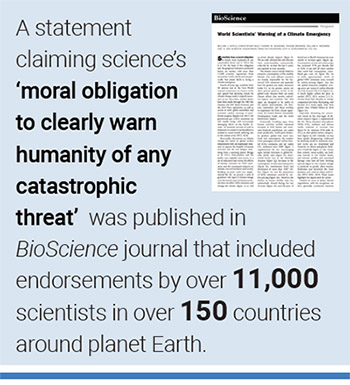 Finally, media accounts in November continued with a focus on scientific themes as well. Examples abounded. Early in the month a statement claiming science’s ‘moral obligation to clearly warn humanity of any catastrophic threat’ was published in BioScience journal that included endorsements by over 11,000 scientists in over 150 countries around planet Earth. Many media outlets covered this statement. For instance, Washington Post journalist Andrew Freedman reported, “A new report by 11,258 scientists in 153 countries from a broad range of disciplines warns that the planet “clearly and unequivocally faces a climate emergency,” and provides six broad policy goals that must be met to address it. The analysis is a stark departure from recent scientific assessments of global warming, such as those of the UN Intergovernmental Panel on Climate Change, in that it does not couch its conclusions in the language of uncertainties, and it does prescribe policies. The study, called the “World scientists’ warning of a climate emergency,” marks the first time a large group of scientists has formally come out in favor of labeling climate change an “emergency,” which the study notes is caused by many human trends that are together increasing greenhouse gas emissions”. As another example, journalist Damian Carrington in The Guardian wrote, “The statement is published…on the 40th anniversary of the first world climate conference, which was held in Geneva in 1979….The scientists say the urgent changes needed include ending population growth, leaving fossil fuels in the ground, halting forest destruction and slashing meat eating”.
Finally, media accounts in November continued with a focus on scientific themes as well. Examples abounded. Early in the month a statement claiming science’s ‘moral obligation to clearly warn humanity of any catastrophic threat’ was published in BioScience journal that included endorsements by over 11,000 scientists in over 150 countries around planet Earth. Many media outlets covered this statement. For instance, Washington Post journalist Andrew Freedman reported, “A new report by 11,258 scientists in 153 countries from a broad range of disciplines warns that the planet “clearly and unequivocally faces a climate emergency,” and provides six broad policy goals that must be met to address it. The analysis is a stark departure from recent scientific assessments of global warming, such as those of the UN Intergovernmental Panel on Climate Change, in that it does not couch its conclusions in the language of uncertainties, and it does prescribe policies. The study, called the “World scientists’ warning of a climate emergency,” marks the first time a large group of scientists has formally come out in favor of labeling climate change an “emergency,” which the study notes is caused by many human trends that are together increasing greenhouse gas emissions”. As another example, journalist Damian Carrington in The Guardian wrote, “The statement is published…on the 40th anniversary of the first world climate conference, which was held in Geneva in 1979….The scientists say the urgent changes needed include ending population growth, leaving fossil fuels in the ground, halting forest destruction and slashing meat eating”.
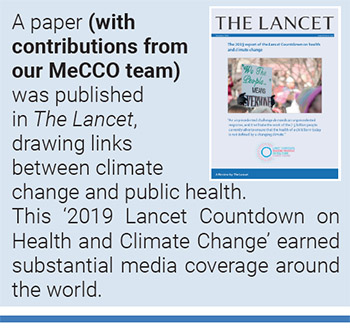 In mid-November, a paper (with contributions from our MeCCO team) was published in The Lancet, drawing links between climate change and public health. This ‘2019 Lancet Countdown on Health and Climate Change’ earned substantial media coverage around the world. For example, journalist Jen Christensen from CNN reported, “The climate crisis is already hurting our health and it could burden generations to come with lifelong health problems, a new report finds. It could challenge already overwhelmed health systems and undermine much of the medical progress that has been made in the last century. If the world continues to produce the same amount of carbon emissions, a child born today could be living in a world with an average temperature that's 7.2 degrees Fahrenheit (4 degrees Celsius) warmer by their 71st birthday, according to the report, published Wednesday in the medical journal The Lancet. On any given day, a 7.2-degree difference might not sound like much, but as an average increase in temperature, it would be devastating for our health”. As another example, USA Today journalist Doyle Rice wrote, “The report stated that as temperatures rise, harvests will shrink – threatening food security and driving up food prices. Infants and small children are among the worst affected by malnutrition and related health problems such as stunted growth, weak immune systems, and long-term developmental problems. In addition, children will be especially susceptible to the infectious diseases that rising temperatures and changing rainfall patterns will leave in their wake. 2018 was the second-most climatically suitable year on record for the spread of bacteria that cause much of diarrheal disease and wound infection around the world... Extreme weather events will intensify into adulthood, the report found, with 152 out of 196 countries experiencing an increase in people exposed to wildfires since 2001-04, and a record 220 million more people over 65 exposed to heatwaves in 2018, when compared with 2000. For the world to meet its U.N. climate goals and protect the health of the next generation, the energy landscape will have to change drastically, and soon, the report warned. Nothing short of a 7.4% year-on-year cut in carbon dioxide emissions from 2019 to 2050 will limit global warming to the more ambitious goal of 2.7 degrees F”.
In mid-November, a paper (with contributions from our MeCCO team) was published in The Lancet, drawing links between climate change and public health. This ‘2019 Lancet Countdown on Health and Climate Change’ earned substantial media coverage around the world. For example, journalist Jen Christensen from CNN reported, “The climate crisis is already hurting our health and it could burden generations to come with lifelong health problems, a new report finds. It could challenge already overwhelmed health systems and undermine much of the medical progress that has been made in the last century. If the world continues to produce the same amount of carbon emissions, a child born today could be living in a world with an average temperature that's 7.2 degrees Fahrenheit (4 degrees Celsius) warmer by their 71st birthday, according to the report, published Wednesday in the medical journal The Lancet. On any given day, a 7.2-degree difference might not sound like much, but as an average increase in temperature, it would be devastating for our health”. As another example, USA Today journalist Doyle Rice wrote, “The report stated that as temperatures rise, harvests will shrink – threatening food security and driving up food prices. Infants and small children are among the worst affected by malnutrition and related health problems such as stunted growth, weak immune systems, and long-term developmental problems. In addition, children will be especially susceptible to the infectious diseases that rising temperatures and changing rainfall patterns will leave in their wake. 2018 was the second-most climatically suitable year on record for the spread of bacteria that cause much of diarrheal disease and wound infection around the world... Extreme weather events will intensify into adulthood, the report found, with 152 out of 196 countries experiencing an increase in people exposed to wildfires since 2001-04, and a record 220 million more people over 65 exposed to heatwaves in 2018, when compared with 2000. For the world to meet its U.N. climate goals and protect the health of the next generation, the energy landscape will have to change drastically, and soon, the report warned. Nothing short of a 7.4% year-on-year cut in carbon dioxide emissions from 2019 to 2050 will limit global warming to the more ambitious goal of 2.7 degrees F”.
In late November, a new study from the UN found that greenhouse gas emissions reached record highs over the past year despite commitments and promises from UN member nations. The ‘UN Emissions Gap Report’ was released ahead of the planned UN climate talks in December. For example, New York Times journalist Somini Sengupta reported, “'The summary findings are bleak” said the annual assessment, which is produced by the United Nations Environment Program and is formally known as the Emissions Gap Report. Countries have failed to halt the rise of greenhouse gas emissions despite repeated warnings from scientists, with China and the United States, the two biggest polluters, further increasing their emissions last year. The result, the authors added, is that “deeper and faster cuts are now required”…Global greenhouse gas emissions have grown by 1.5 percent every year over the last decade, according to the annual assessment. The opposite must happen if the world is to avoid the worst effects of climate change, including more intense droughts, stronger storms and widespread hunger by midcentury. To stay within relatively safe limits, emissions must decline sharply, by 7.6 percent every year, between 2020 and 2030, the report warned”.
December
December media attention to climate change and global warming at the global level remained relatively steady from November 2019 coverage, up just under 1%. However, news articles and segments about climate change and global warming was up 55% from a year earlier (December 2018). In particular, global radio coverage was up 19% from November 2019 and up 32% from December 2018.
Regionally, the ongoing stream of stories increased most in Europe (up 73%) and Central/South America (with coverage more than doubling). At the national-level, coverage notably continued to rise in Spain (up 72% from November).
Many stories in Spanish media ran about the United Nations (UN) Madrid-based round of climate talks (COP25) that ran December 2-13. Focusing further at the country level, coverage in Japan was up 14% from November 2019 and double from a year prior (December 2018) while coverage in Sweden was up 36% from November 2019, and up 10% from the previous December. Meanwhile, coverage in Australia was up 1% in December from the previous month, yet up 48% from December 2018.
Figure 17 tracks global newspaper coverage of climate change or global warming across 55 countries and nine languages from January 2004 through December 2019.

Figure 16. Newspaper media coverage of climate change or global warming in one hundred sources in seven different regions around the world, from January 2004 through December 2019.
In December, ecological and meteorological connections with climate issues contributed substantially to media coverage of climate change around the world. To illustrate, continued coverage of extreme heat and bushfires in Australia sparked media attention to their links with planetary climate change. As domestic and international coverage focused on temperature records and fires in New South Wales, numerous journalists and outlets connected these dots with longer-term changes. For example, journalist Graham Readfern from The Guardian reported, “Australia recorded its hottest day on record on Wednesday, with an average maximum temperature of 41.9C (107.4F), beating the previous record by 1C that had been set only 24 hours earlier. Tuesday 16 December recorded an average of 40.9C across the continent, beating the previous record of 40.3C set on 7 January 2013. But it held the record for just 24 hours. Wednesday was even hotter across the country, with the highest maximum temperature reached in Birdsville, Queensland, which hit 47.7C (117.8F). On Wednesday the lowest maximum was 19C at Low Head, Tasmania. On Thursday, Nullarbor in South Australia set the record for the hottest December day on record, recording 49.9C (121.8F). Underlying these two major drivers of the heat is climate change – the simple physics of loading the atmosphere with extra greenhouse gases, mainly by burning fossil fuels. Australia’s latest State of the Climate report shows the country has warmed by just over 1C since 1910, leading to more extreme events. Watkins said: “That long-term warming sees the bar lifted up so that it’s easier to get extreme conditions now than it was 50 or 100 years ago,” “One part of me says that this is amazing but then another says that we have seen this in other parts of the world so we’re not especially surprised.” He pointed to France’s heatwave of June 2019, when Montpellier hit 43.5C, breaking its previous all-time heat record set in August 2017 by a huge 5.8C. “I’m not sure we are shocked by much any more.” Dr Sarah Perkins-Kirkpatrick, a climate scientist at the University of New South Wales specialising in extreme events, said climate change had given the natural drivers of Australia’s record -breaking heat “extra sting.” She said without the extra CO2 in the atmosphere “it would still have been warm”, but, she added: “I doubt very much we would have seen a record on Tuesday and then another one on Wednesday. And we are still at the beginning of the summer with a long way to go.” On Thursday, she was driving through thick smoke haze in north-west Sydney with her family. She said: “It is frightening and a little frustrating, but this is what climate scientists have been saying for decades. “I’m bordering on saying ‘I told you so’ but I don’t think anyone really wants to hear that””.
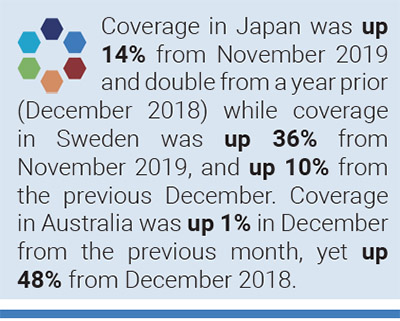 In December, media also covered ecological and meteorological aspects of climate change as they threaded through oceans-atmospheric interactions. For instance, NOAA reporting of ocean acidification focused media attention. Journalist Rosanna Xia from The Los Angeles Times remarked, “Waters off the California coast are acidifying twice as fast as the global average, scientists found, threatening major fisheries and sounding the alarm that the ocean can absorb only so much more of the world’s carbon emissions. A new study led by the National Oceanic and Atmospheric Administration also made an unexpected connection between acidification and a climate cycle known as the Pacific Decadal Oscillation — the same shifting forces that other scientists say have a played a big role in the higher and faster rates of sea level rise hitting California in recent years. El Niño and La Niña cycles, researchers found, also add stress to these extreme changes in the ocean’s chemistry. These findings come at a time when record amounts of emissions have already exacerbated the stress on the marine environment. When carbon dioxide mixes with seawater, it undergoes chemical reactions that increase the water’s acidity. Across the globe, coral reefs are dying, oysters and clams are struggling to build their shells, and fish seem to be losing their sense of smell and direction. Harmful algal blooms are getting more toxic — and occurring more frequently. Researchers are barely keeping up with these new issues while still trying to understand what’s happening under the sea. Scientists call it the other major, but less talked about, CO2 problem. The ocean covers more than 70% of the Earth’s surface and has long been the unsung hero of climate change. It has absorbed more than a quarter of the carbon dioxide released by humans since the Industrial Revolution, and about 90% of the resulting heat — helping the air we breathe at the expense of a souring sea”. Concurrently, journalist Denise Chow from NBC News noted, “The waters off California are acidifying twice as rapidly as elsewhere on Earth, according to a study published Monday, which suggests that climate change is likely hastening and worsening chemical changes in the ocean that could threaten seafood and fisheries. Oceans play an important role in the planet's delicate carbon cycle, acting as a crucial reservoir that absorbs and stores carbon dioxide from the atmosphere. But the new research finds that although oceans can withstand some natural variations in climate, global warming may be adding to the stress on those ecosystems and overwhelming their ability to cope”.
In December, media also covered ecological and meteorological aspects of climate change as they threaded through oceans-atmospheric interactions. For instance, NOAA reporting of ocean acidification focused media attention. Journalist Rosanna Xia from The Los Angeles Times remarked, “Waters off the California coast are acidifying twice as fast as the global average, scientists found, threatening major fisheries and sounding the alarm that the ocean can absorb only so much more of the world’s carbon emissions. A new study led by the National Oceanic and Atmospheric Administration also made an unexpected connection between acidification and a climate cycle known as the Pacific Decadal Oscillation — the same shifting forces that other scientists say have a played a big role in the higher and faster rates of sea level rise hitting California in recent years. El Niño and La Niña cycles, researchers found, also add stress to these extreme changes in the ocean’s chemistry. These findings come at a time when record amounts of emissions have already exacerbated the stress on the marine environment. When carbon dioxide mixes with seawater, it undergoes chemical reactions that increase the water’s acidity. Across the globe, coral reefs are dying, oysters and clams are struggling to build their shells, and fish seem to be losing their sense of smell and direction. Harmful algal blooms are getting more toxic — and occurring more frequently. Researchers are barely keeping up with these new issues while still trying to understand what’s happening under the sea. Scientists call it the other major, but less talked about, CO2 problem. The ocean covers more than 70% of the Earth’s surface and has long been the unsung hero of climate change. It has absorbed more than a quarter of the carbon dioxide released by humans since the Industrial Revolution, and about 90% of the resulting heat — helping the air we breathe at the expense of a souring sea”. Concurrently, journalist Denise Chow from NBC News noted, “The waters off California are acidifying twice as rapidly as elsewhere on Earth, according to a study published Monday, which suggests that climate change is likely hastening and worsening chemical changes in the ocean that could threaten seafood and fisheries. Oceans play an important role in the planet's delicate carbon cycle, acting as a crucial reservoir that absorbs and stores carbon dioxide from the atmosphere. But the new research finds that although oceans can withstand some natural variations in climate, global warming may be adding to the stress on those ecosystems and overwhelming their ability to cope”.
Moving from Oceania and North America to the African continent, ecological and meteorological-themed coverage of climate change pointed to the historic drying of Victoria Falls on the Zambezi River between Zambia and Zimbabwe. For example, journalist Mehr Gill from The Indian Express reported, “The flow of Victoria Falls, with a width of 1.7 km and a height of roughly 108 metres, has been reduced to a trickle due to the severe droughts in the southern African region since October 2018. The falls are fed by the Zambezi River and define the boundary between Zambia and Zimbabwe in southern Africa. The falls are one of southern Africa’s biggest tourist attractions, but now one of the worst droughts of the century has reduced its flow to a trickle triggering fears that climate change might destroy a major tourist attraction such as this. The news comes amid the ongoing 2019 United Nations Framework Convention on Climate Change that is being held in Madrid, Spain”.
Chilean Environment Minister Carolina Schmidt, who chaired COP25, attends the closing session in Madrid. Marathon climate talks ended with negotiators postponing until next year a key decision on how to regulate global carbon markets. Photo: Bernat Armangue/AP. |
In addition, some media coverage across Asia connected Typhoon Kammuri early in the month and Typhoon Phanfone later in December to patterns consistent with a changing climate. For example, Philippines correspondent Raul Dancel from The Straits Times reported, “Typhoon Kammuri slammed into the Philippines on Tuesday (Dec 3), bringing heavy rains and gale-force winds as it tore across the main island of Luzon. At least four people were killed and close to half-a-million huddled in evacuation centres as the typhoon, the 20th to hit the country this year, roared ashore late on Monday and passed south of the capital Manila, threatening to set off floods, landslides and storm surges… Typhoon season used to end in October but has stretched to December since the year 2000, a phenomenon experts blamed on climate change”.
In December, political and economic content also shaped media coverage. Prominently, media coverage of the UN climate negotiations in Madrid, Spain sparked coverage. For example, BBC journalist Matt McGrath reported, “Environmentalists and observers have been barred from UN climate talks in Madrid after a protest inside the conference. Around 200 climate campaigners were ejected after staging a sit in, preventing access to one of the negotiating halls. Protesters said they were "pushed, bullied and touched without consent." In the wake of the disruption all other observers were then barred from the talks. Observers play an important role in the talks, representing civil society. They are allowed to sit in on negotiations and have access to negotiators on condition that they do not reveal the contents of those discussions”. Concurrently, Associated Press reporters Arritz Parra and Frank Jordans noted, “With less than 72 hours left to reach a deal on key measures in the fight against global warming, major countries at a U.N. meeting on climate change took the floor to stake out their positions — showing that deep differences remain to be breached. In a sign of growing frustration over the pace of the talks in Madrid — the logo of which is a stylized ticking clock — more than 100 activists led by representatives of indigenous peoples from Latin and North America staged an impromptu protest, blocking the gates of the main plenary hall for a few tense minutes…Climate negotiators in Madrid also had one eye on Brussels, where the European Union announced a 100-billion euro ($130-billion) plan to help wean EU nations off fossil fuels. But some observers predicted the talks could head into overtime, with ministers struggling to agree on rules for a global carbon market and ways to compensate vulnerable countries for disasters caused by global warming. World leaders agreed in Paris four years ago to keep global warming below 2 degrees Celsius (3.6 degrees Fahrenheit) — ideally no more than 1.5 C (2.7 F) — by the end of the century. Scientists say both of those goals will be missed by a wide margin unless drastic steps are taken to begin cutting greenhouse gas emissions next year”.
California's kelp forests are in danger which is affecting the larger ocean ecosystem. Source: NBC News. |
As the UN climate talks (COP25) ended with disappointing outcomes in mid-December, news focused on how the scale of international policy responses paled in comparison to the scale of ongoing climate challenges. For example, Wall Street Journal reporter Emre Peker dispatched, “Climate negotiators failed to strengthen targets to cut emissions or to create a global carbon-trading system, two main goals of the 2015 Paris accord, as the impending U.S. exit from the pact exacerbated challenges to cut record-high planet-warming gases. Delegates from nearly 200 nations sparred for two weeks in Madrid at the annual United Nations climate summit without setting new emissions targets before next year’s U.N. convention in Glasgow or creating a framework to reward and encourage efforts to cut emissions”. Meanwhile, Washington Post journalists Brady Dennis and Chico Harlan wrote, “Global climate talks lurched to an end here Sunday with finger-pointing, accusations of failure and fresh doubts about the world's collective resolve to slow the warming of the planet — at a moment when scientists say time is running out for people to avert steadily worsening climate disasters. After more than two weeks of negotiations, punctuated by raucous protests and constant reminders of a need to move faster, negotiators barely mustered enthusiasm for the compromise they had patched together, while raising grievances about the issues that remain unresolved. The negotiators failed to achieve their primary goals. Central among them: persuading the world’s largest carbon-emitting countries to pledge to tackle climate change more aggressively beginning in 2020”. Moreover, consistent BBC environment reporter Matt McGrath noted, “The longest United Nations climate talks on record have finally ended in Madrid with a compromise deal. Exhausted delegates reached agreement on the key question of increasing the global response to curbing carbon. All countries will need to put new climate pledges on the table by the time of the next major conference in Glasgow next year. Divisions over other questions - including carbon markets - were delayed until the next gathering”.
Low-water levels are seen after a prolonged drought at Victoria Falls. Source: Guardian News. |
In December, scientific dimensions also grabbed some of the overall media attention to climate change and global warming. For example, reporting drew attention to findings from the Global Carbon Project that global greenhouse gases hit new record highs in 2019. New York Times journalist Brad Plumer wrote, “Emissions of planet-warming carbon dioxide from fossil fuels hit a record high in 2019, researchers said Tuesday, putting countries farther off course from their goal of halting global warming. The new data contained glimmers of good news: Worldwide, industrial emissions are on track to rise 0.6 percent this year, a considerably slower pace than the 1.5 percent increase seen in 2017 and the 2.1 percent rise in 2018. The United States and the European Union both managed to cut their carbon dioxide output this year, while India’s emissions grew far more slowly than expected. And global emissions from coal, the worst-polluting of all fossil fuels, unexpectedly declined by about 0.9 percent in 2019, although that drop was more than offset by strong growth in the use of oil and natural gas around the world. Scientists have long warned, however, that it’s not enough for emissions to grow slowly or even just stay flat in the years ahead. In order to avoid many of the most severe consequences of climate change — including deadlier heat waves, fiercer droughts, and food and water shortages — global carbon dioxide emissions would need to steadily decline each year and reach roughly zero well before the end of the century”. Meanwhile, journalists Fiona Harvey and Jennifer Rankin from the Guardian noted, “The rise in emissions was much smaller than in the last two years, but the continued increase means the world is still far from being on track to meet the goals of the Paris agreement on climate change, which would require emissions to peak then fall rapidly to reach net-zero by mid-century. Emissions for this year will be 4% higher than those in 2015, when the Paris agreement was signed. Governments are meeting this week and next in Madrid to hammer out some of the final details for implementing the Paris deal and start work on new commitments to cut emissions by 2030. But the new report shows the increasing difficulty of that task”.
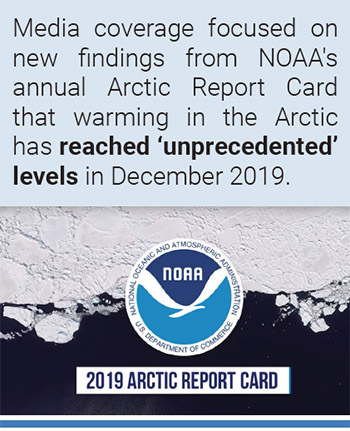 Also, media coverage focused on new findings from NOAA's annual Arctic Report Card that warming in the Arctic has reached ‘unprecedented’ levels in December 2019. For example, in a PBS NewsHour segment with the topline ‘Arctic ecosystems and communities are increasingly at risk due to continued warming and declining sea ice’, journalist Nsikan Akpan observed, “Dead seals, marked with bald patches, washing onto shores or floating in rivers. A 900-mile-long bloom of algae stretching off the coast of Greenland, potentially suffocating wildlife. A giant, underground storehouse of carbon trapped in permafrost is leaking millions of tons of greenhouse gases into the atmosphere, heralding a feedback loop that will accelerate climate change in unpredictable ways. These are all bleak highlights from the 2019 Arctic Report Card, unveiled on Tuesday at the American Geophysical Union Fall Meeting. Published annually by the National Oceanic and Atmospheric Administration, the 14th iteration of this peer-reviewed report examines the status of the planet’s northern expanse and changes due to global warming, with potential consequences reaching around the globe. In addition to scientific essays, this year’s report card for the first time delivers firsthand accounts from indigenous communities confronting the Arctic’s dramatic, climate-caused transformation. More than 70 such communities depend on Arctic ecosystems, which are warming twice as fast as any other location on the planet”. Meanwhile, New York Times journalist Kendra Pierre-Louis reported, “Temperatures in the Arctic region remained near record highs this year, according to a report issued on Tuesday, leading to low summer sea ice, cascading impacts on the regional food web and growing concerns over sea level rise. Average temperatures for the year ending in September were the second highest since 1900, the year records began, scientists said. While that fell short of a new high, it fit a worrying trend: Over all, the past six years have been the warmest ever recorded in the region”.
Also, media coverage focused on new findings from NOAA's annual Arctic Report Card that warming in the Arctic has reached ‘unprecedented’ levels in December 2019. For example, in a PBS NewsHour segment with the topline ‘Arctic ecosystems and communities are increasingly at risk due to continued warming and declining sea ice’, journalist Nsikan Akpan observed, “Dead seals, marked with bald patches, washing onto shores or floating in rivers. A 900-mile-long bloom of algae stretching off the coast of Greenland, potentially suffocating wildlife. A giant, underground storehouse of carbon trapped in permafrost is leaking millions of tons of greenhouse gases into the atmosphere, heralding a feedback loop that will accelerate climate change in unpredictable ways. These are all bleak highlights from the 2019 Arctic Report Card, unveiled on Tuesday at the American Geophysical Union Fall Meeting. Published annually by the National Oceanic and Atmospheric Administration, the 14th iteration of this peer-reviewed report examines the status of the planet’s northern expanse and changes due to global warming, with potential consequences reaching around the globe. In addition to scientific essays, this year’s report card for the first time delivers firsthand accounts from indigenous communities confronting the Arctic’s dramatic, climate-caused transformation. More than 70 such communities depend on Arctic ecosystems, which are warming twice as fast as any other location on the planet”. Meanwhile, New York Times journalist Kendra Pierre-Louis reported, “Temperatures in the Arctic region remained near record highs this year, according to a report issued on Tuesday, leading to low summer sea ice, cascading impacts on the regional food web and growing concerns over sea level rise. Average temperatures for the year ending in September were the second highest since 1900, the year records began, scientists said. While that fell short of a new high, it fit a worrying trend: Over all, the past six years have been the warmest ever recorded in the region”.
Finally, media accounts in December continued with a focus on cultural themes as well. From the start of the month, protests in Sydney Australia stretched from November (see November 2019 summary for more) to December as concerns about air quality and public health from bushfires provided news hooks for climate change stories. These also fueled demonstrations led by youth around the world as part of the ongoing ‘Fridays for Future’ movement. For example, journalists Arritz Parra and Frank Jordans from the Associated Press wrote, “Activists of all ages and from all corners of the planet demanded concrete action Friday against climate change from leaders and negotiators at a global summit in Madrid. The march was led by dozens of representatives of Latin America’s indigenous peoples – a mark of deference after anti-government protests in Chile, the original host of the summit, resulted in the talks suddenly being moved to Europe for the third year in a row…Organizers claimed 500,000 people turned out for the march, but authorities in Madrid put the number at 15,000 without an immediate explanation for the disparity in the count”.
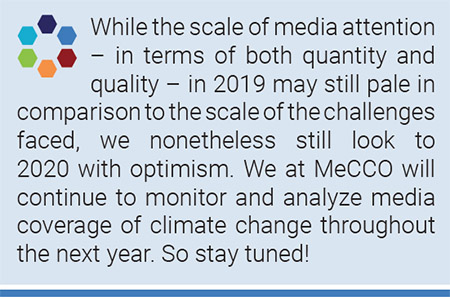 While the scale of media attention – in terms of both quantity and quality – in 2019 may still pale in comparison to the scale of the challenges faced, we nonetheless still look to 2020 with optimism. We at MeCCO will continue to monitor and analyze media coverage of climate change throughout the next year. So stay tuned for our monitoring, summaries and analyses in the coming along scientific, political, economic, ecological, meteorological and cultural dimensions of climate change and global warming. Happy New Year! Onward we go.
While the scale of media attention – in terms of both quantity and quality – in 2019 may still pale in comparison to the scale of the challenges faced, we nonetheless still look to 2020 with optimism. We at MeCCO will continue to monitor and analyze media coverage of climate change throughout the next year. So stay tuned for our monitoring, summaries and analyses in the coming along scientific, political, economic, ecological, meteorological and cultural dimensions of climate change and global warming. Happy New Year! Onward we go.
Brought to you by your MeCCO team: Midori Aoyagi, Andrew Benham, Max Boykoff, Patrick Chandler, Meaghan Daly, Kaori Doi, Rogelio Fernández-Reyes, Lauren Gifford, Isidro Jiménez Gómez, Jennifer Katzung, Lucy McAllister, Marisa McNatt, Ami Nacu-Schmidt, David Oonk, Jeremiah Osborne-Gowey, Olivia Pearman, Anne Hege Simonsen, and Andreas Ytterstad
MeCCO members partnerships:
- University of Colorado Boulder (US)
- University of New England (US)
- Babson College (US)
- Universidad Complutense de Madrid (Spain)
- Universidad de Sevilla (Spain)
- National Institute for Environmental Studies (Japan)
- Oslo Metropolitan University (Norway)
Report citation: Boykoff, M., Katzung, J., and Nacu-Schmidt, A. (2020). A Review of Media Coverage of Climate Change and Global Warming in 2019, Media and Climate Change Observatory, Center for Science and Technology Policy Research, Cooperative Institute for Research in Environmental Sciences, University of Colorado Boulder [http://sciencepolicy.colorado.edu/icecaps/research/media_coverage/summaries/special_issue_2019.html]


